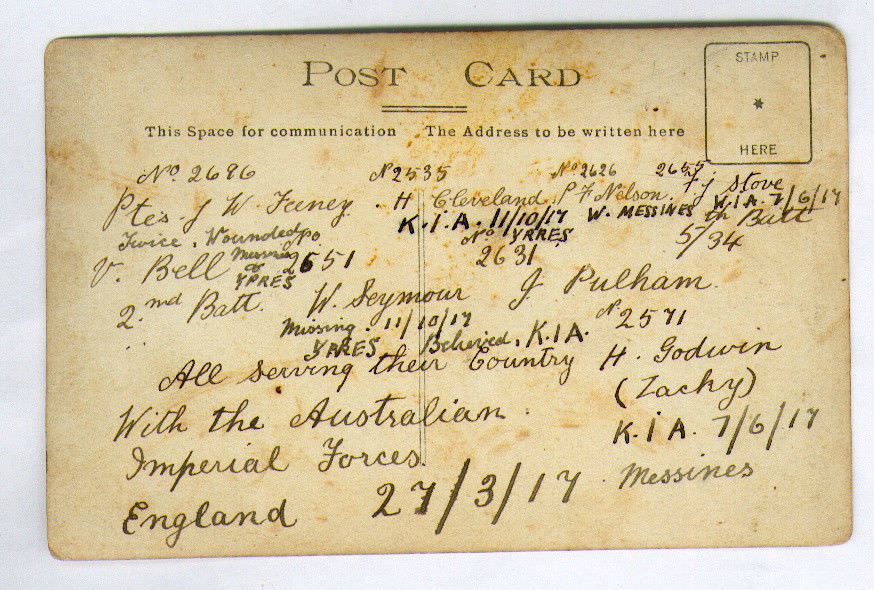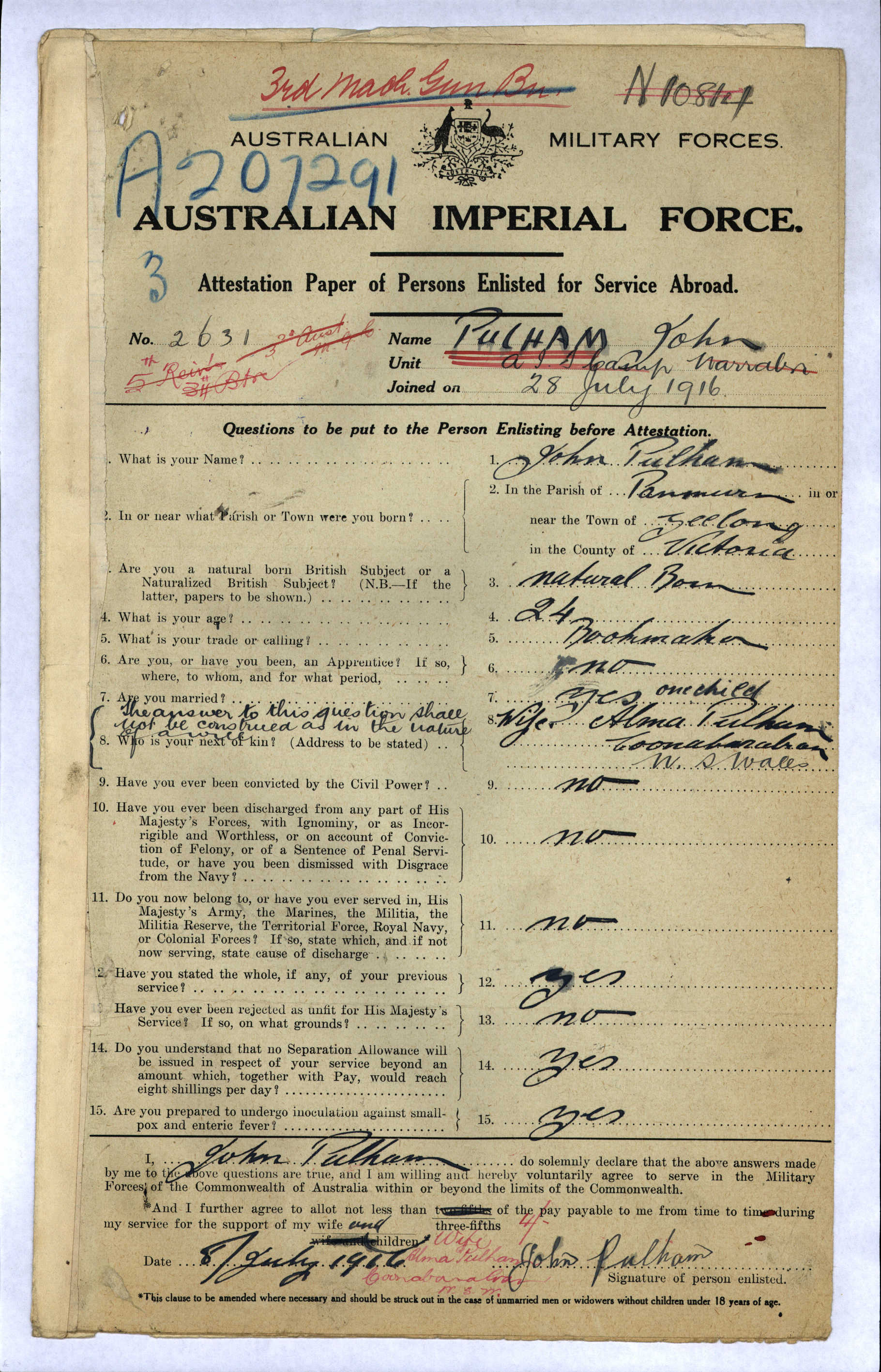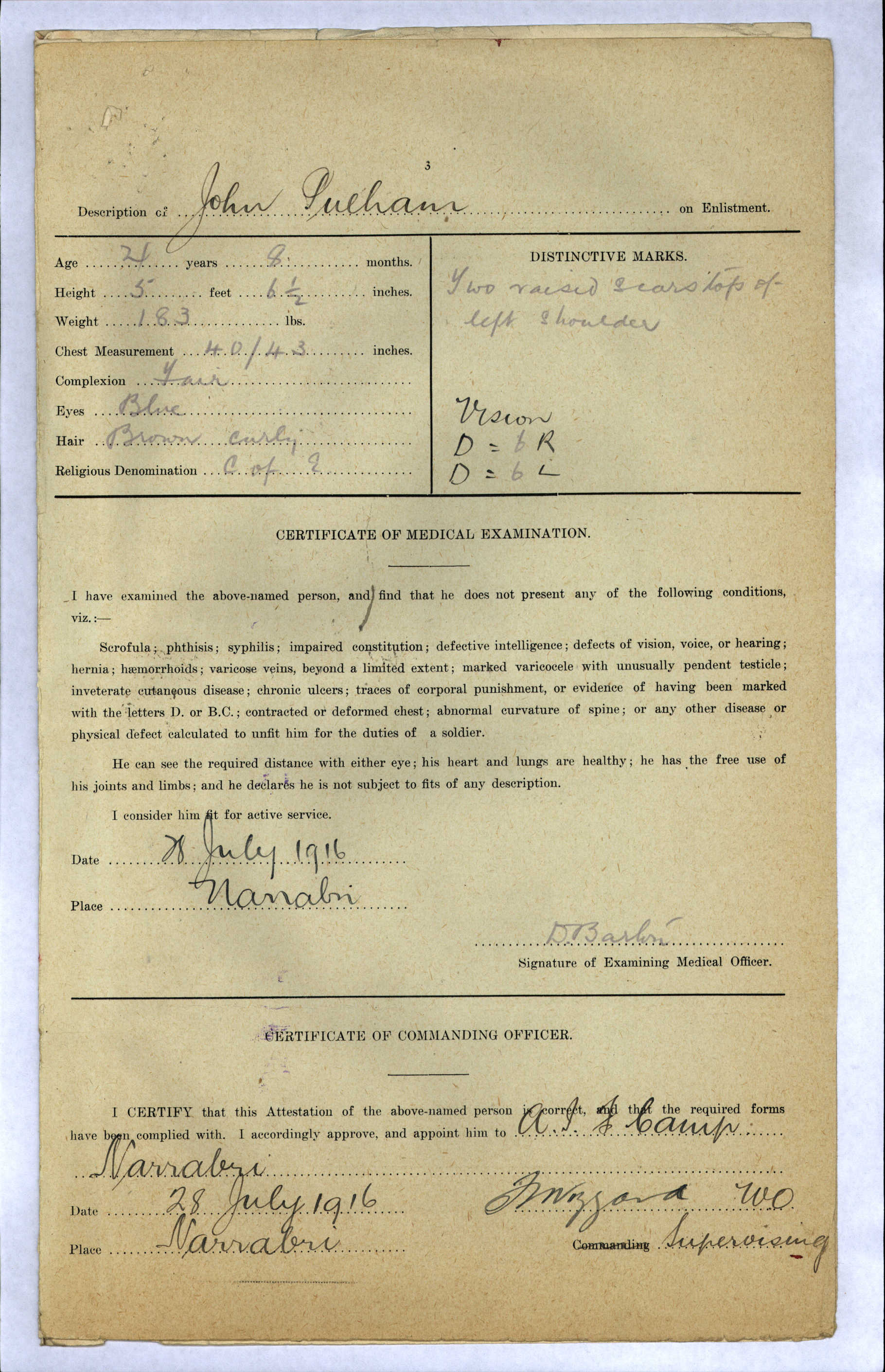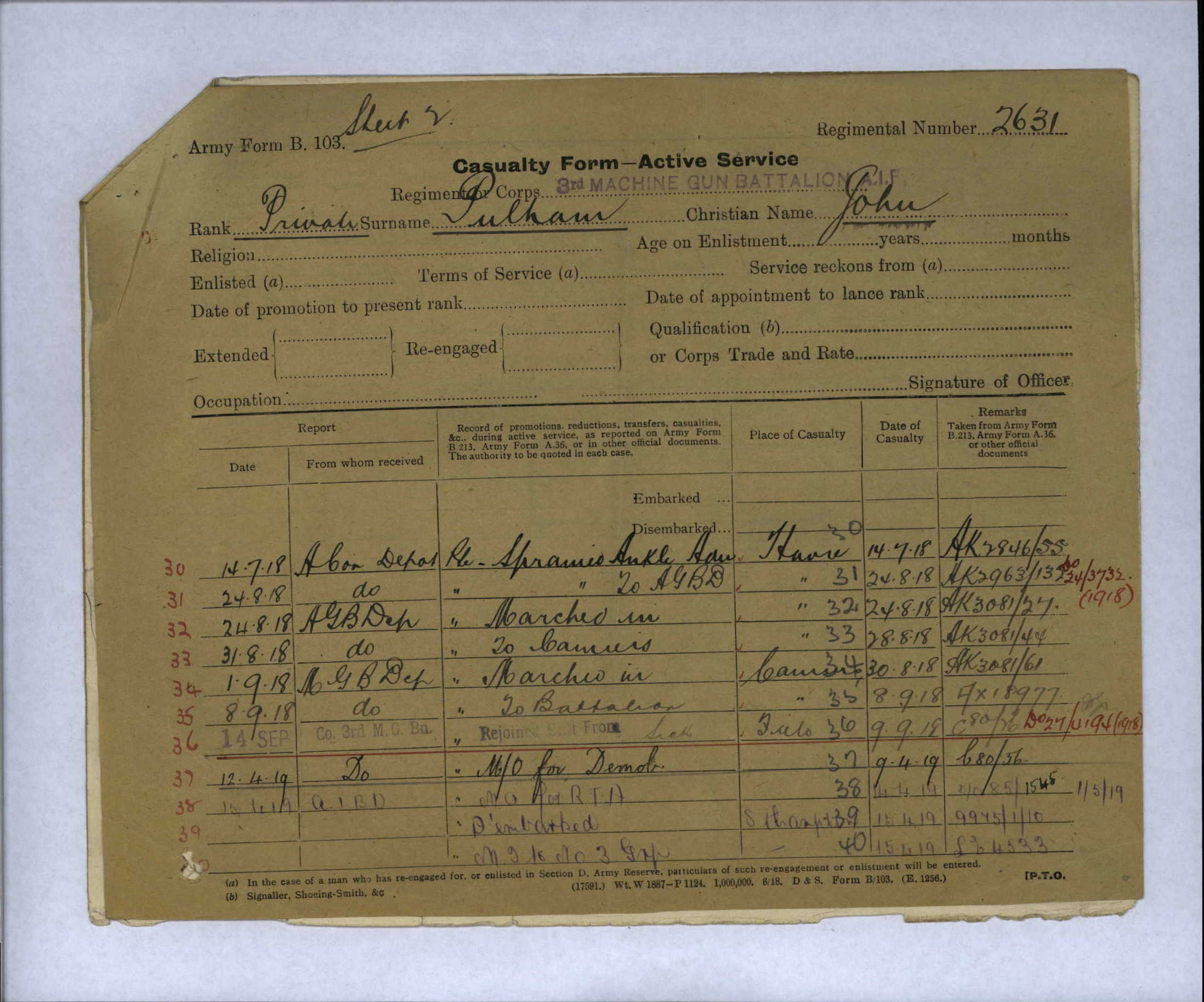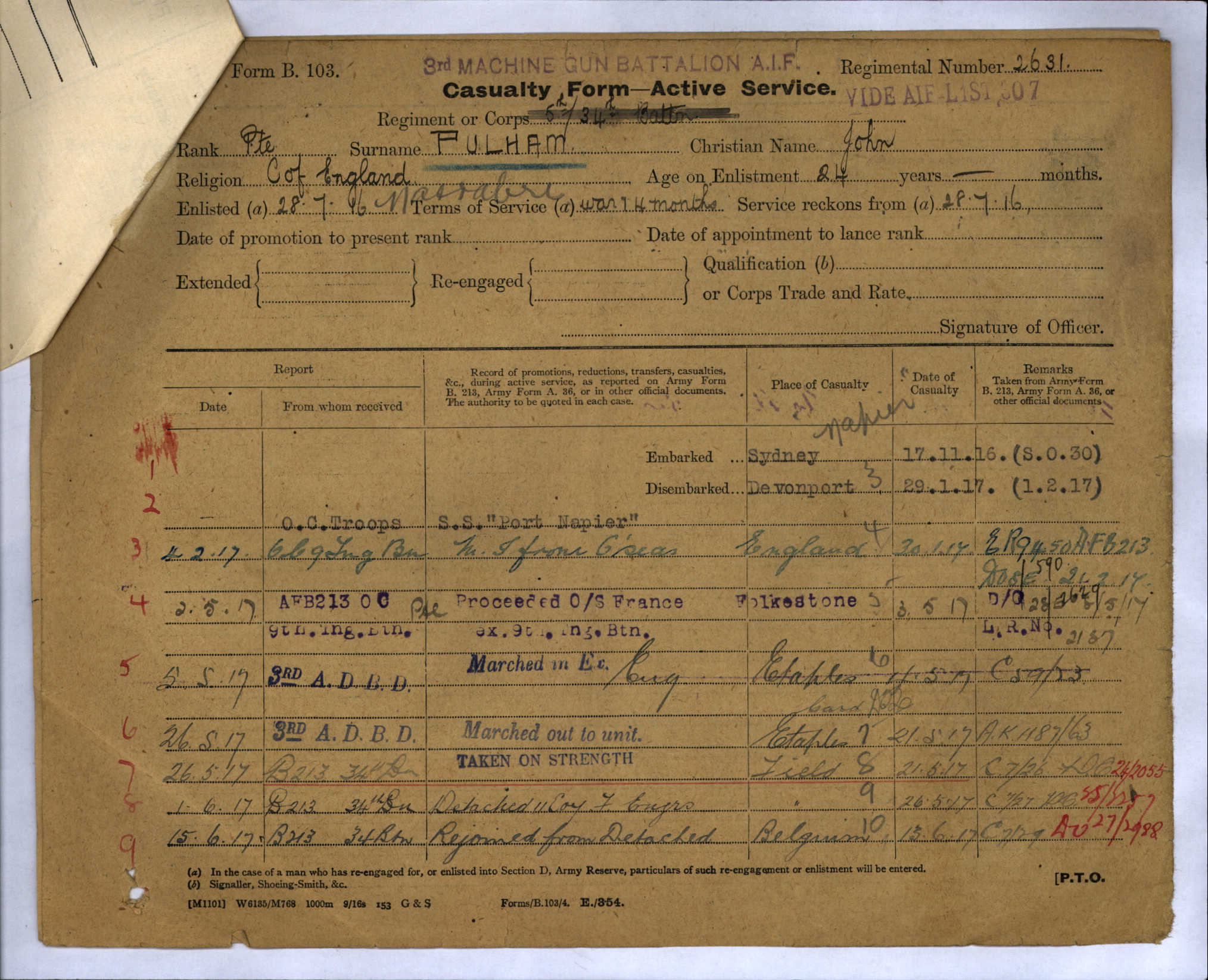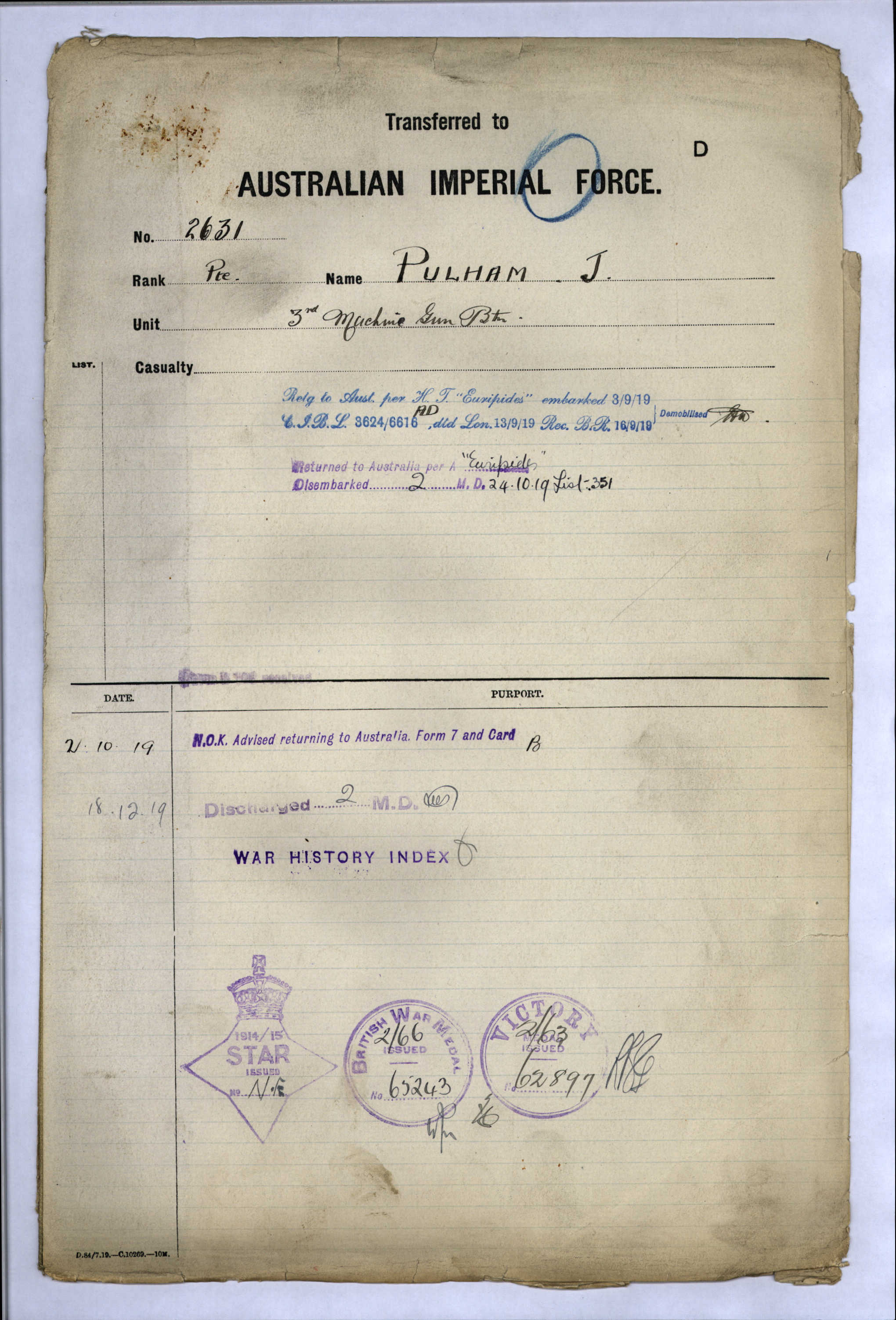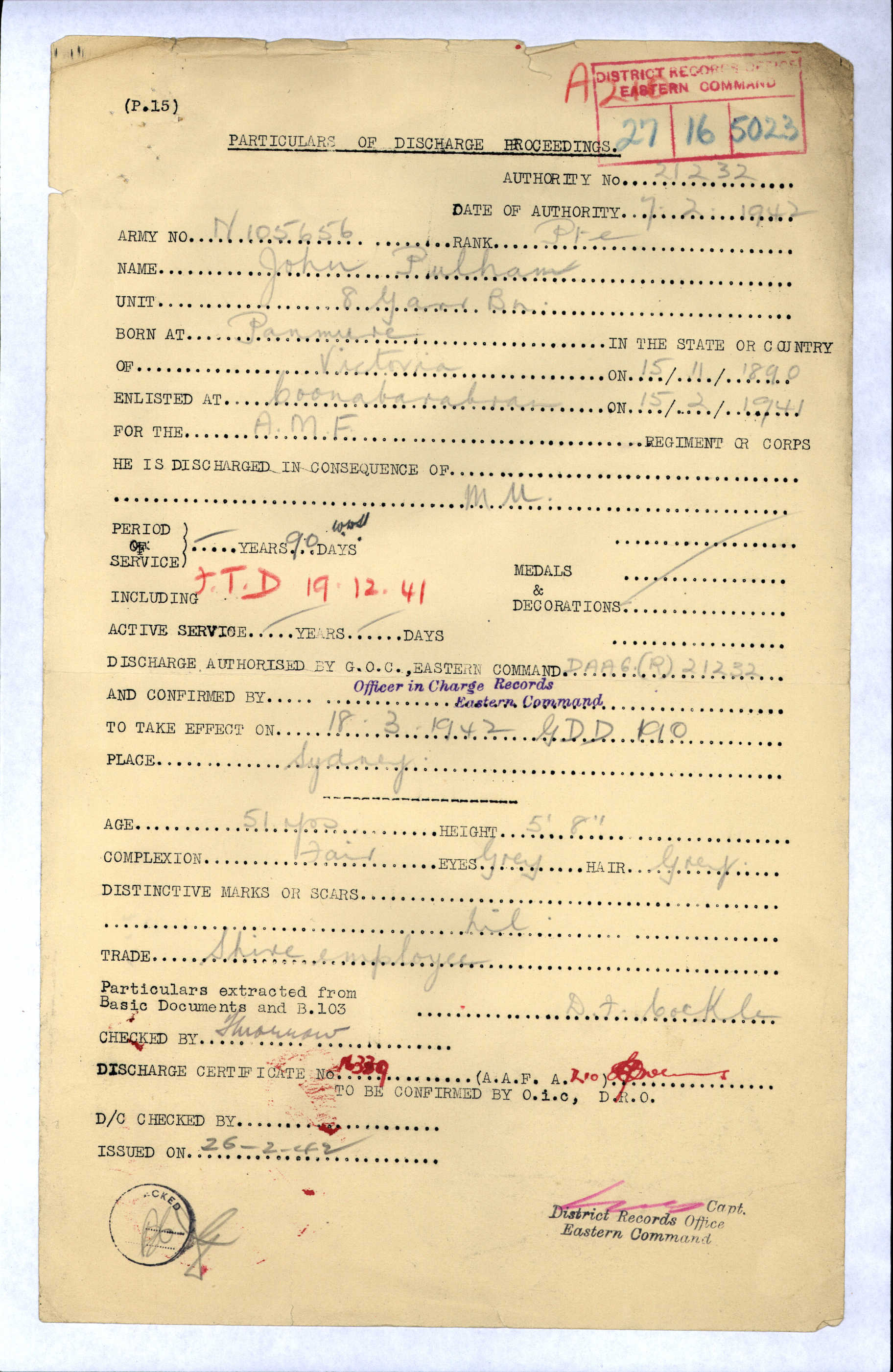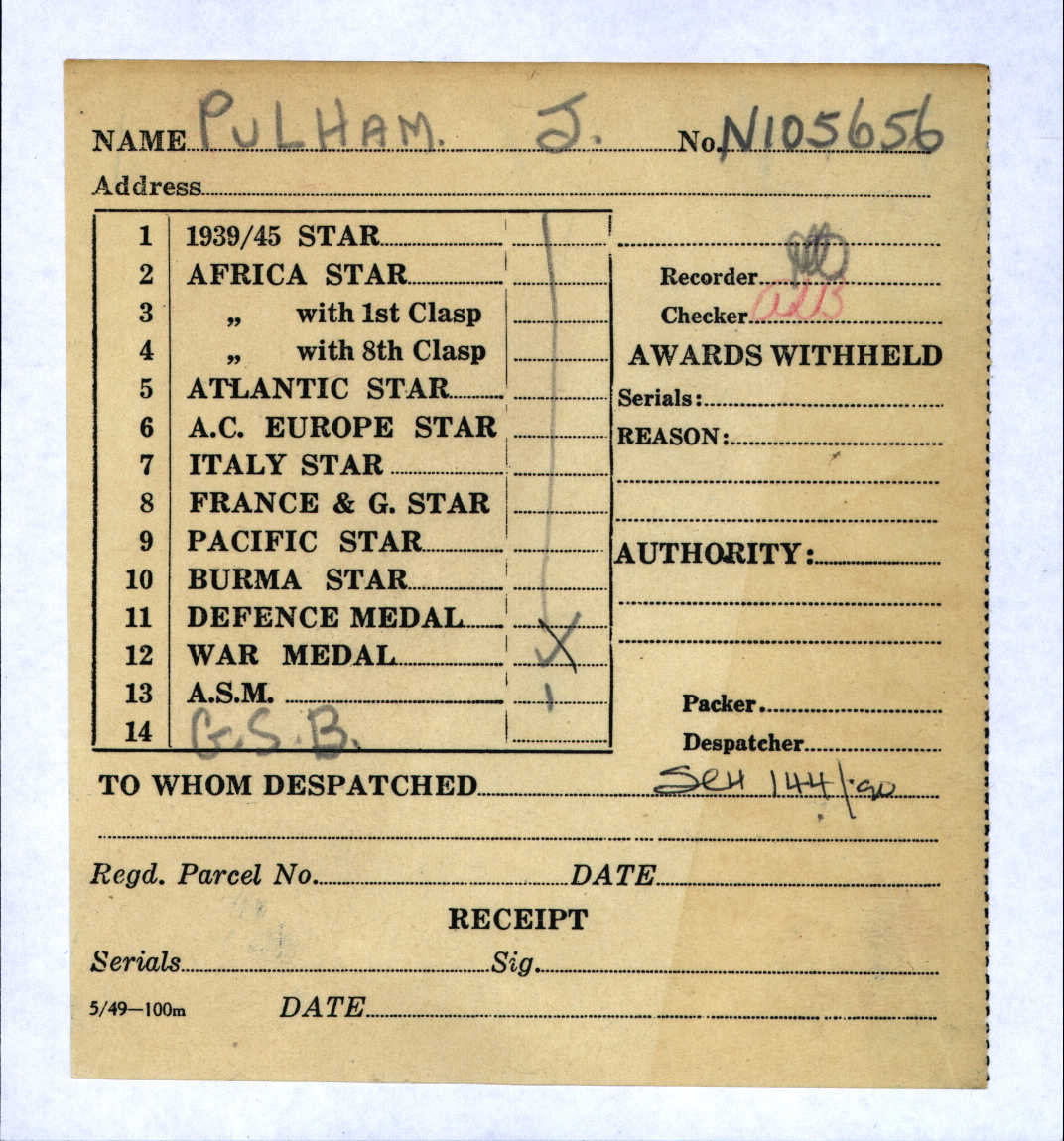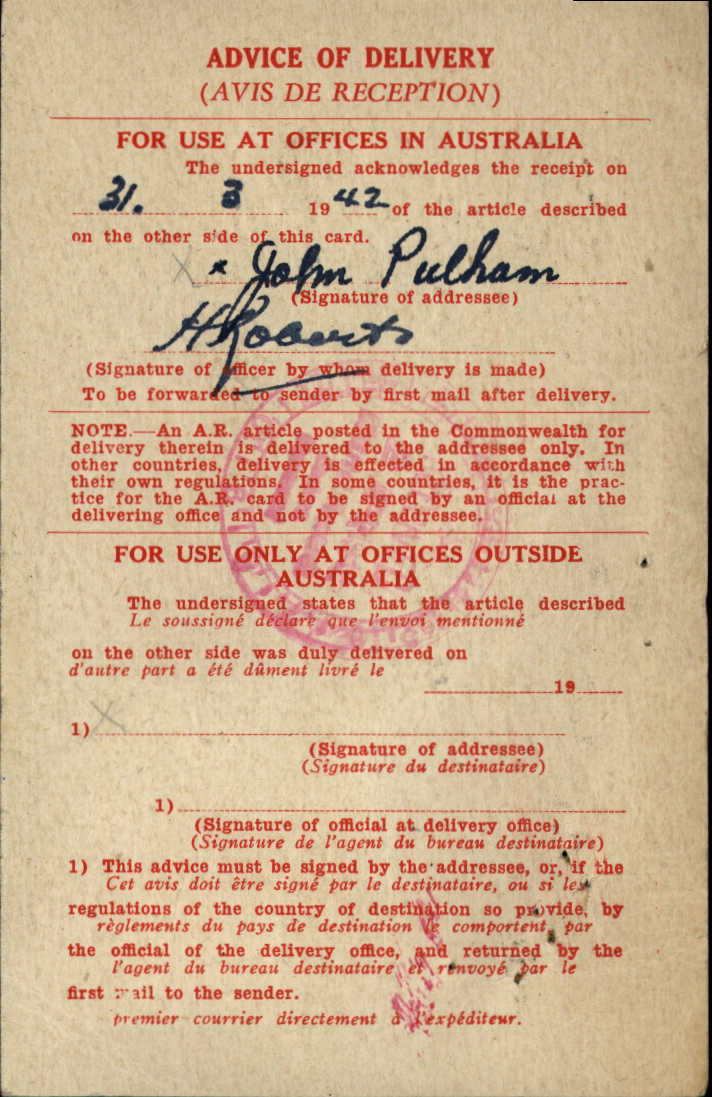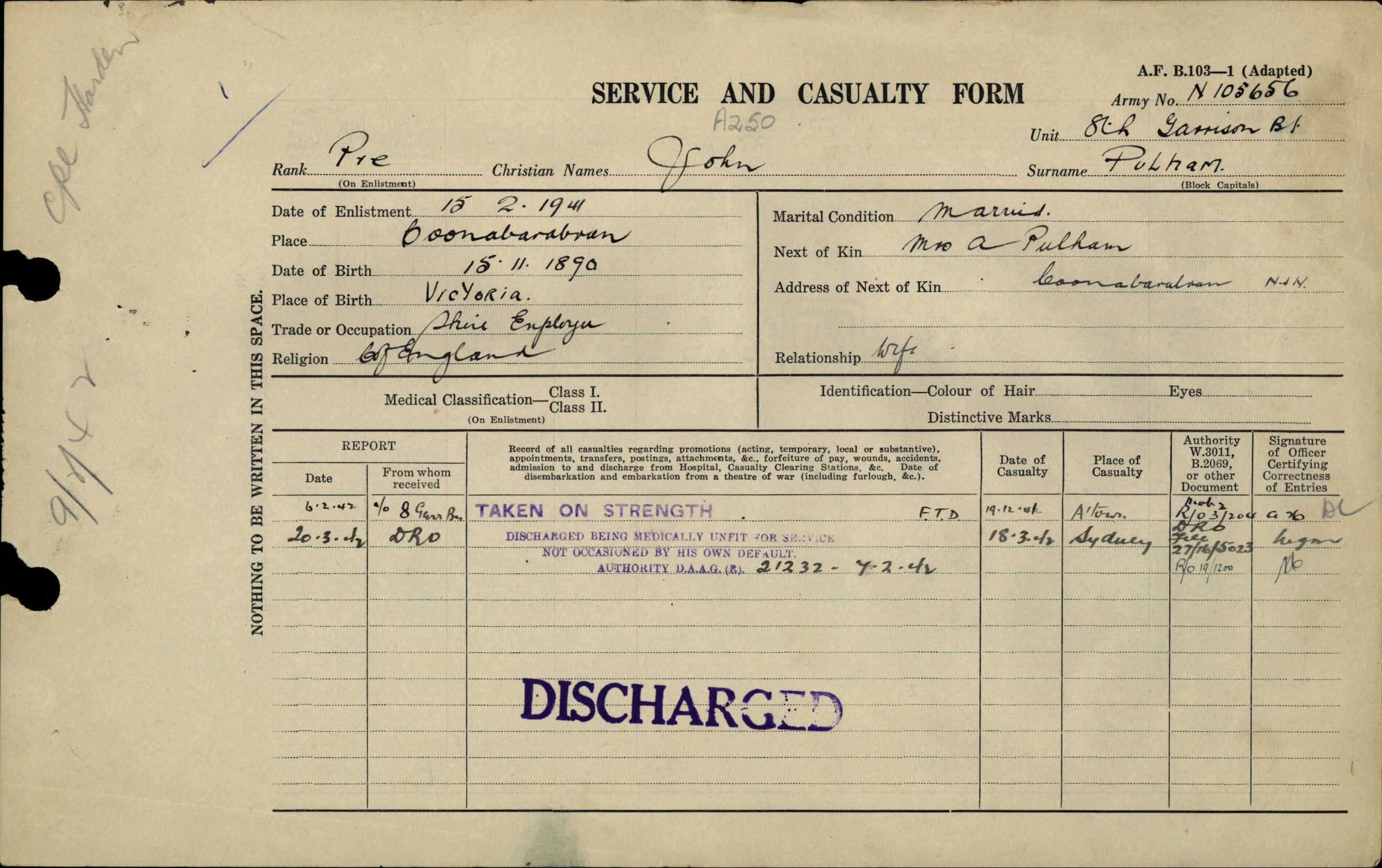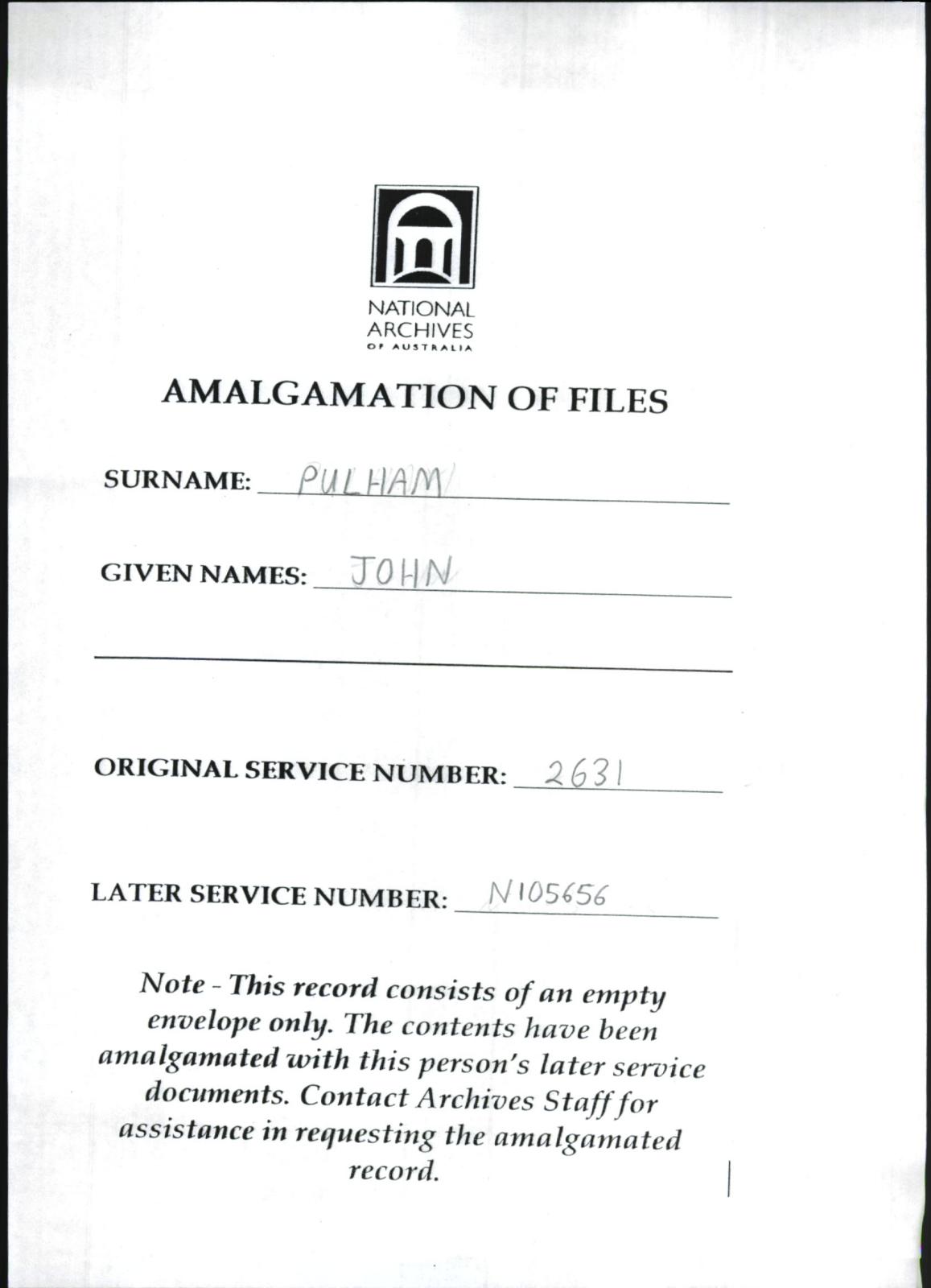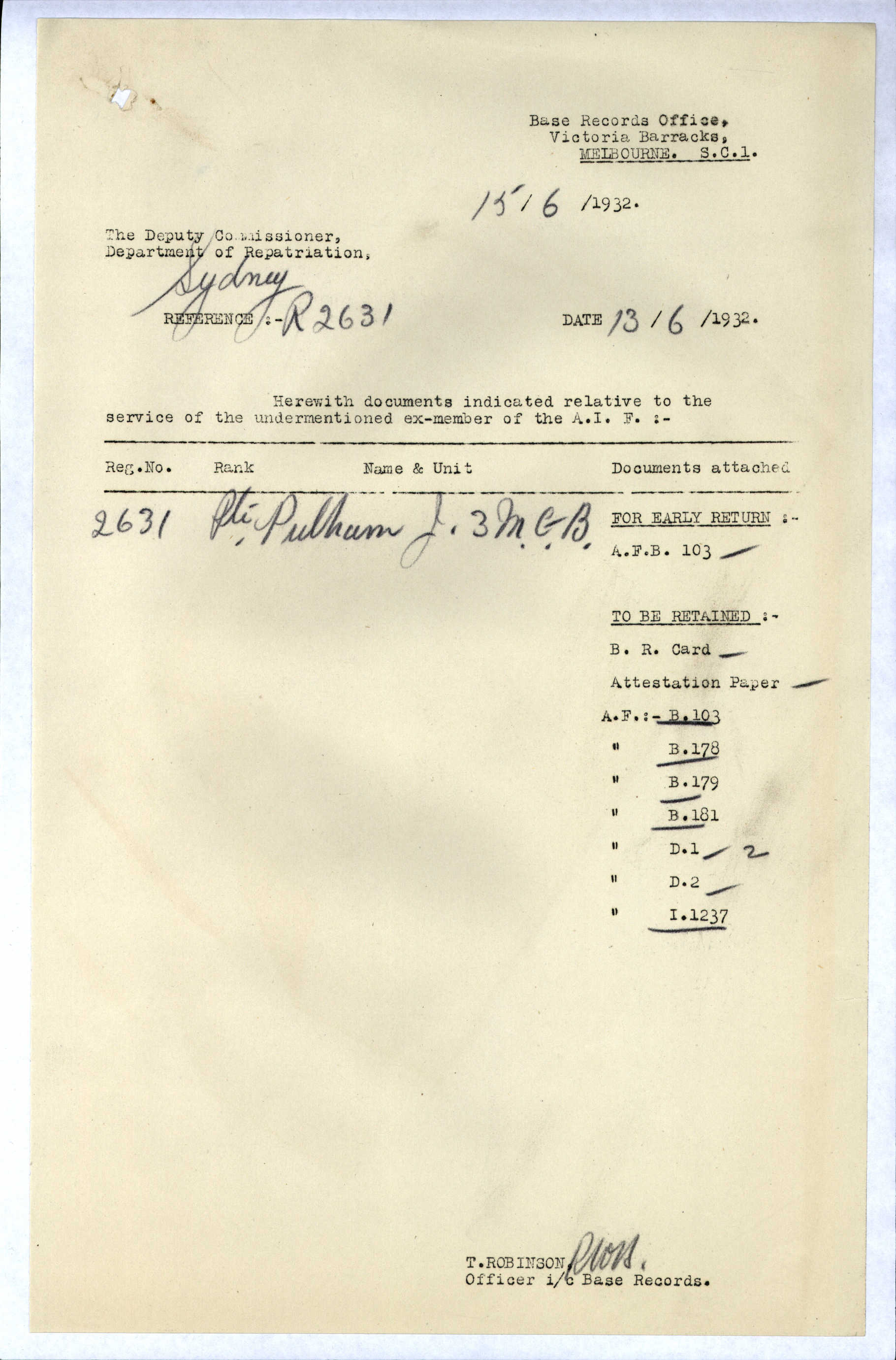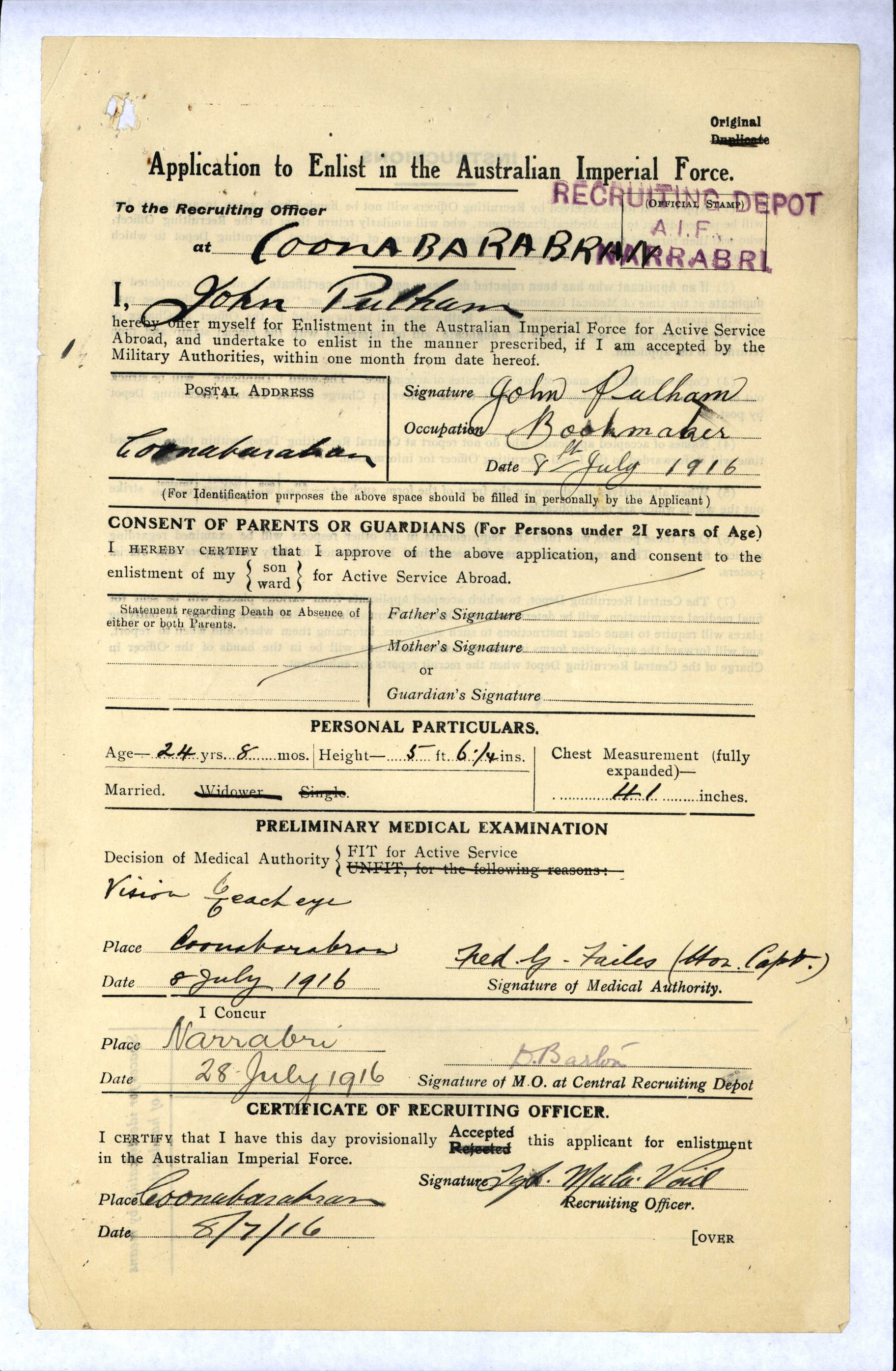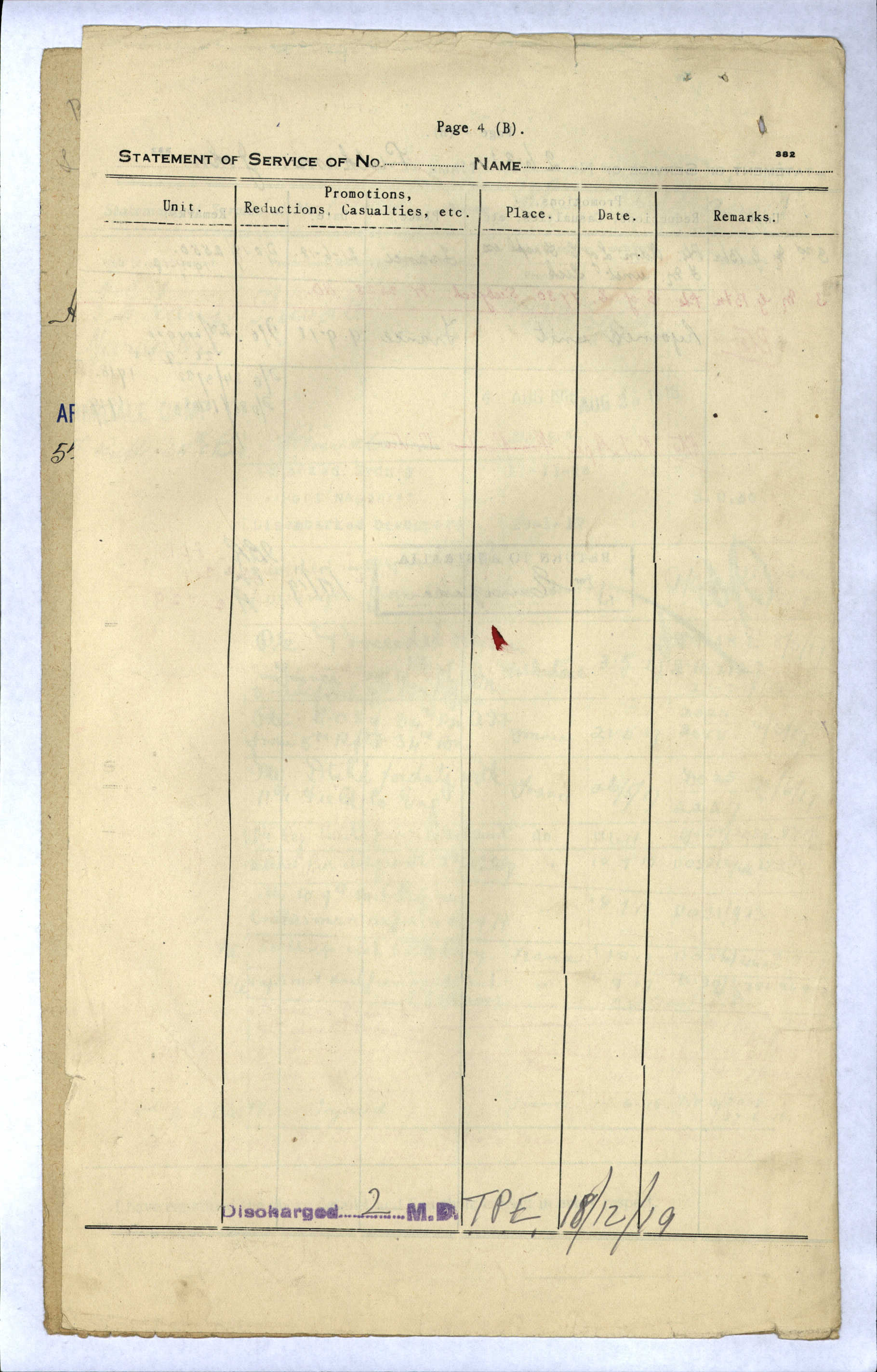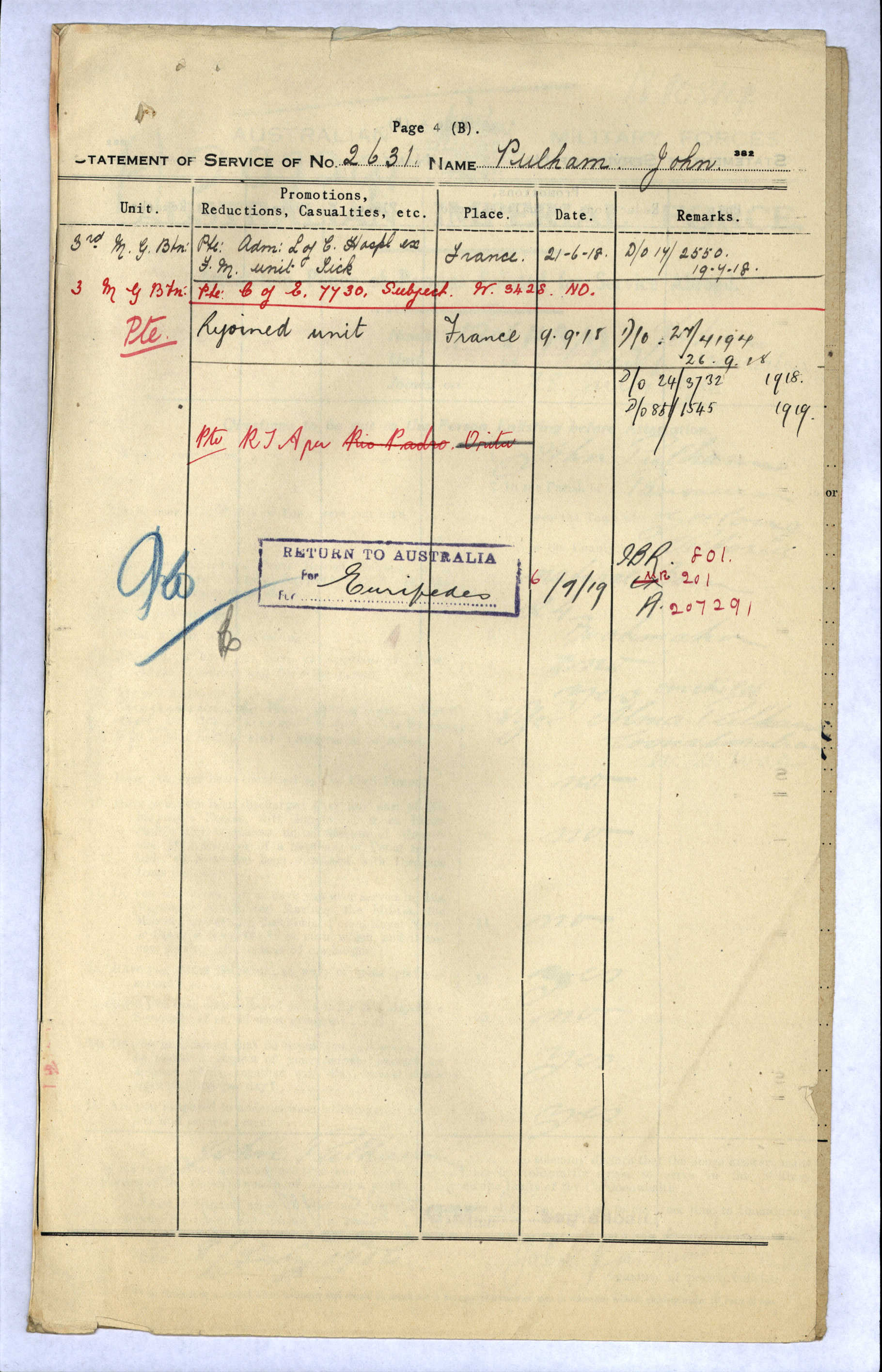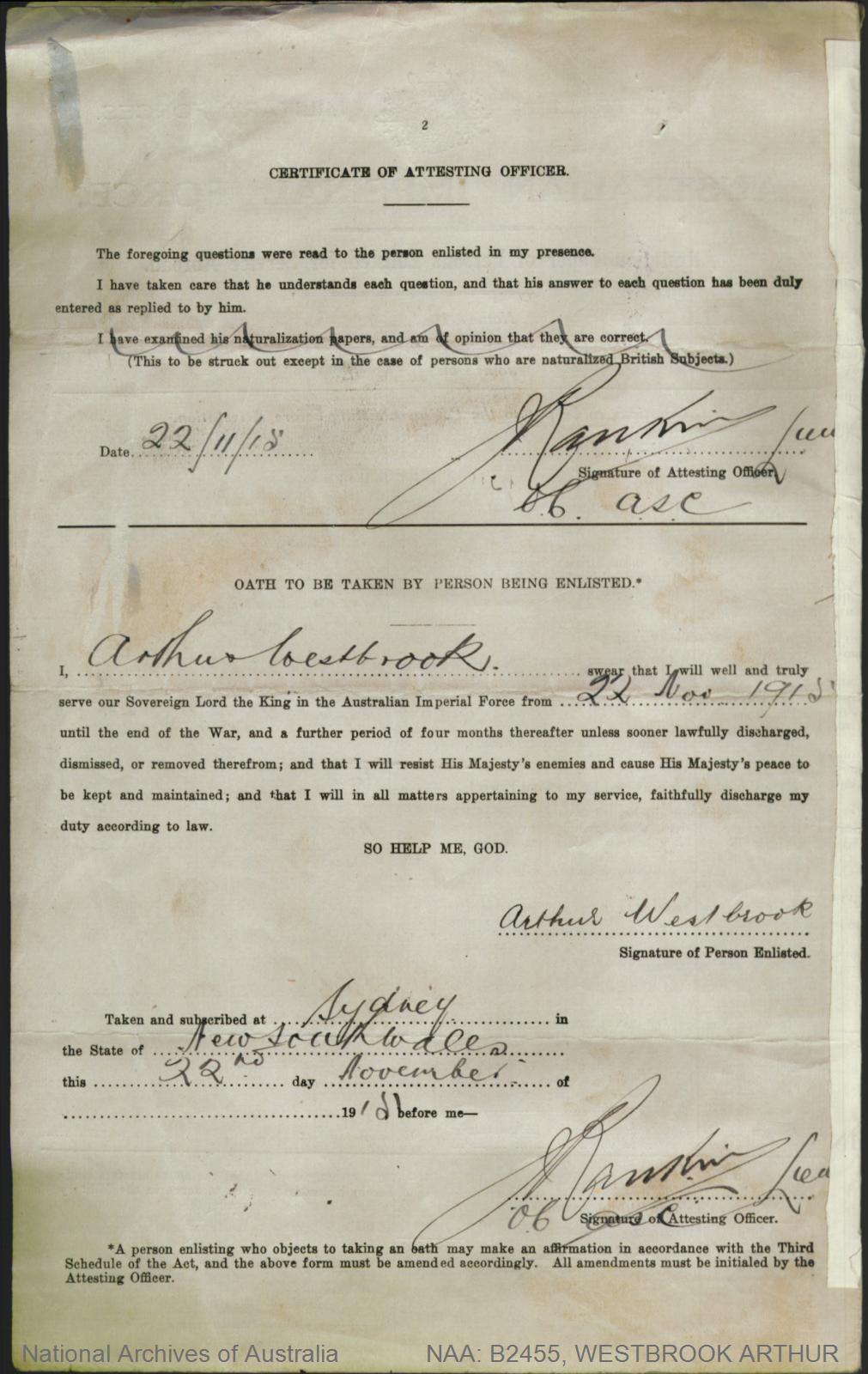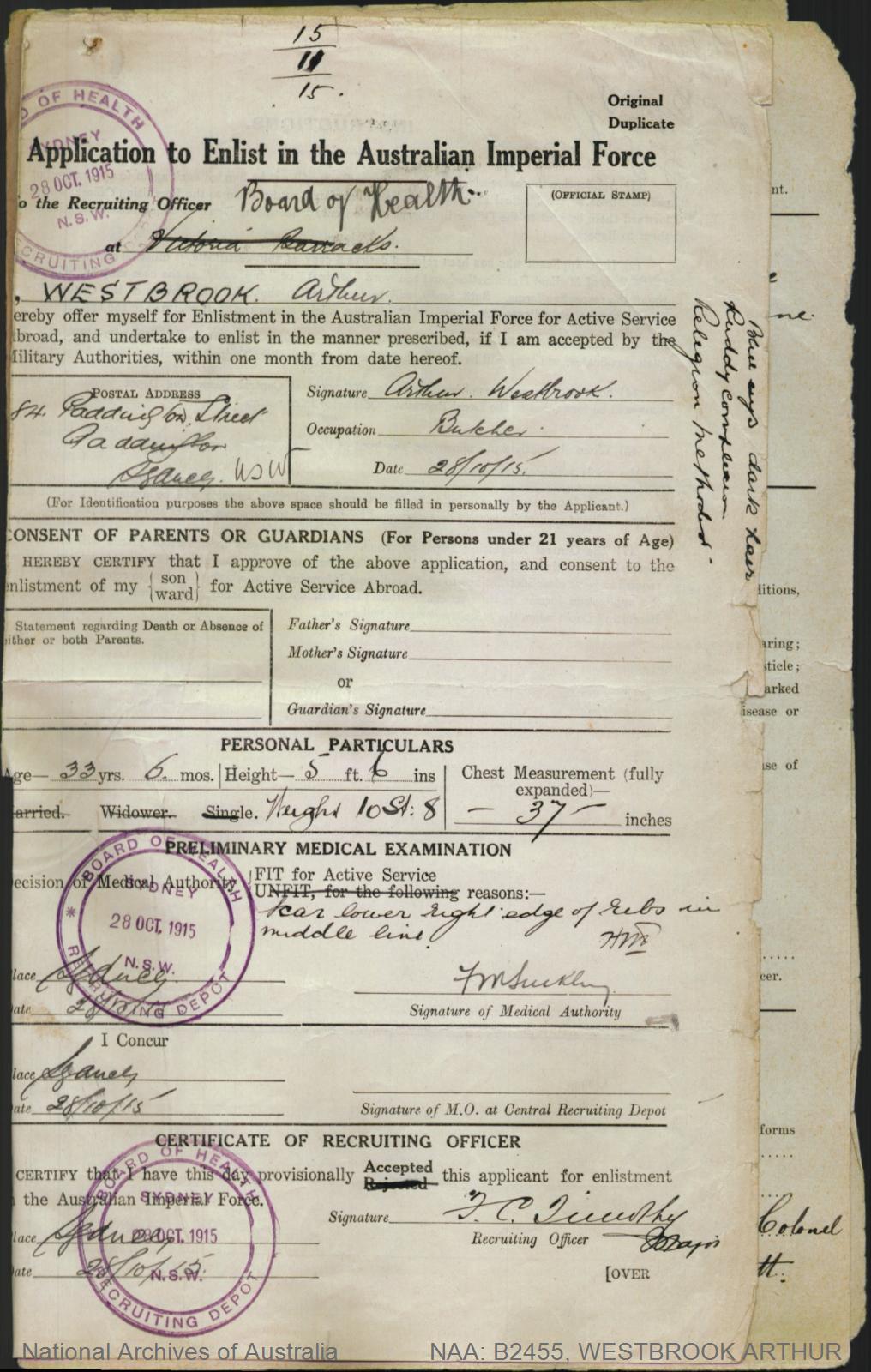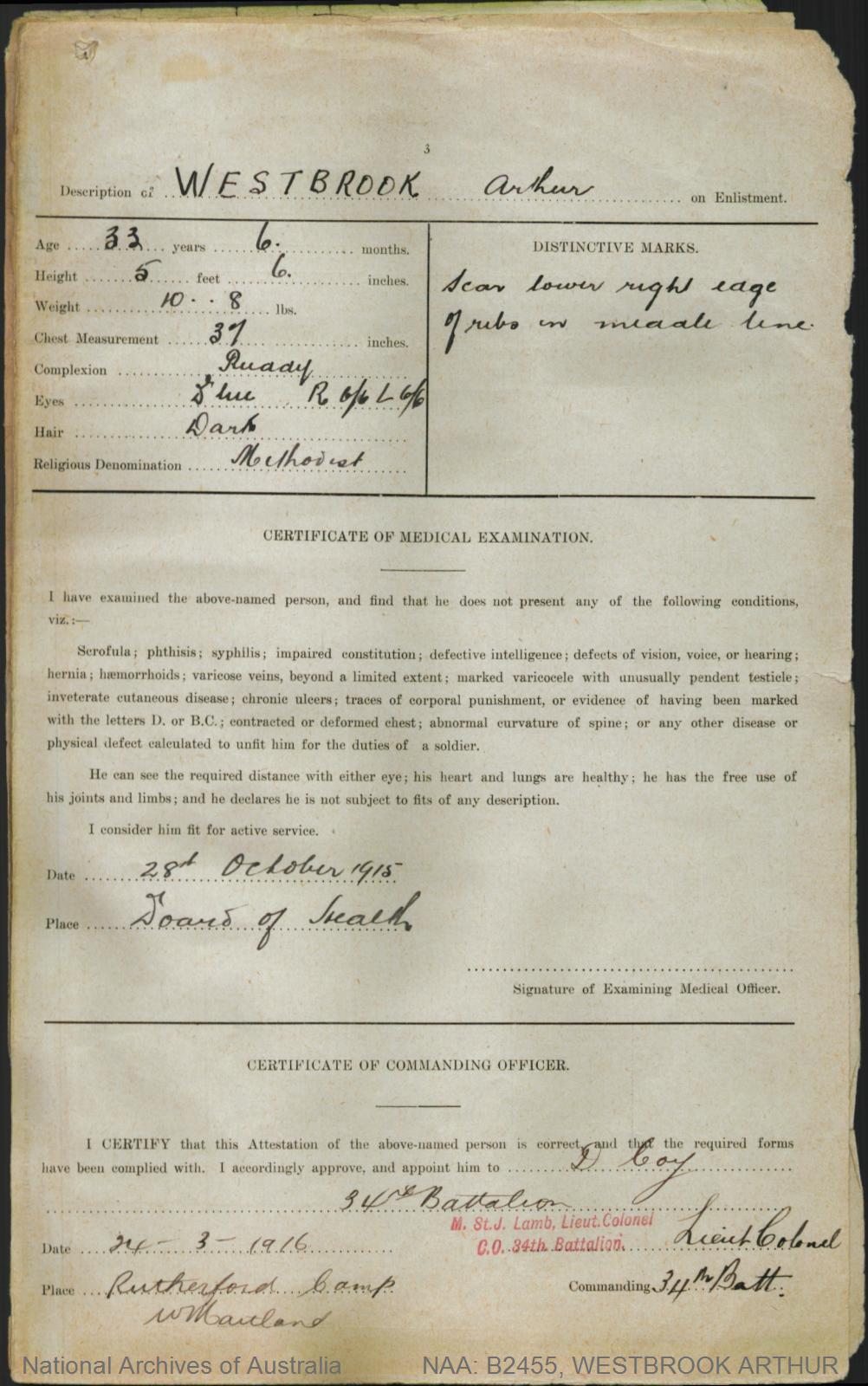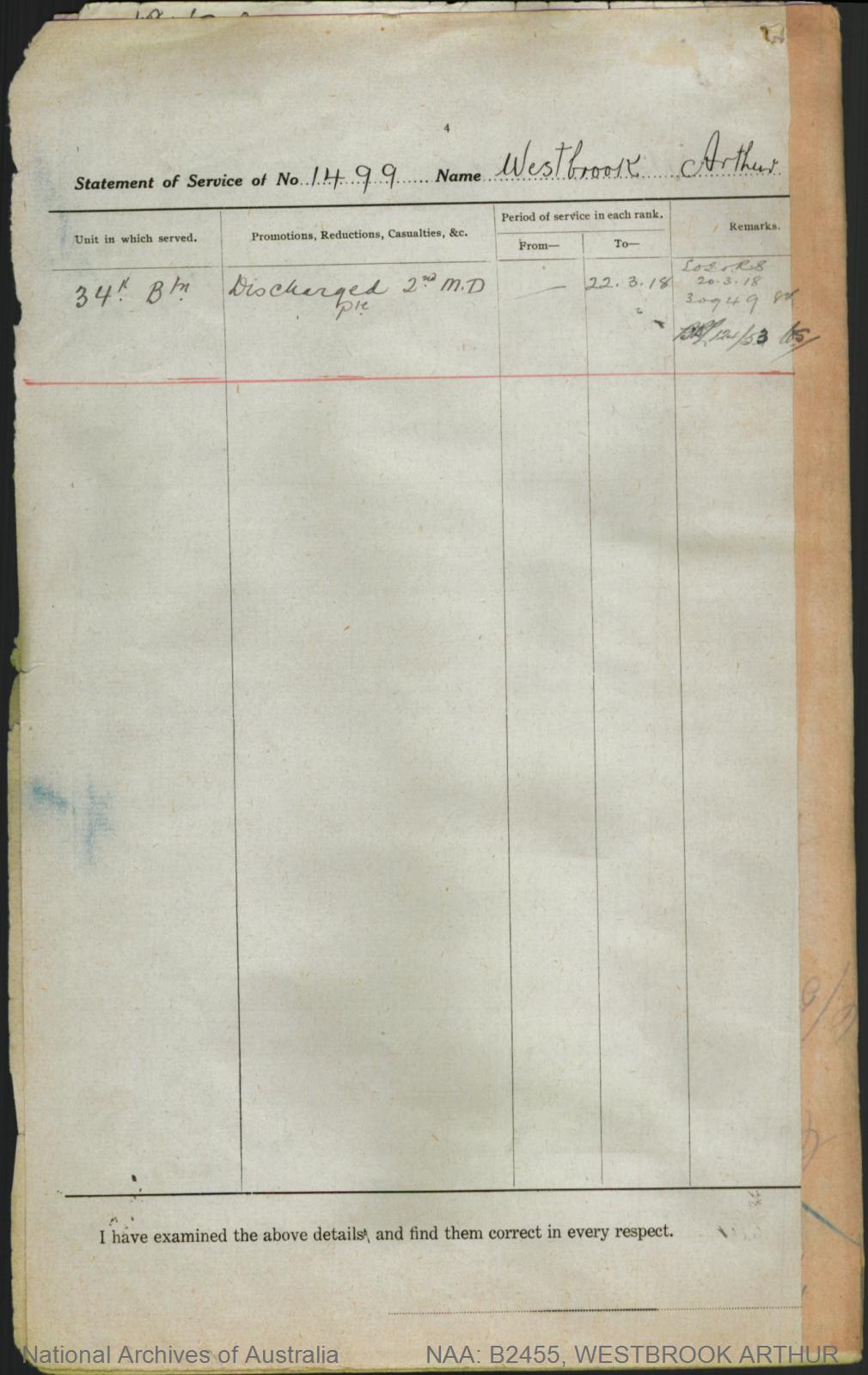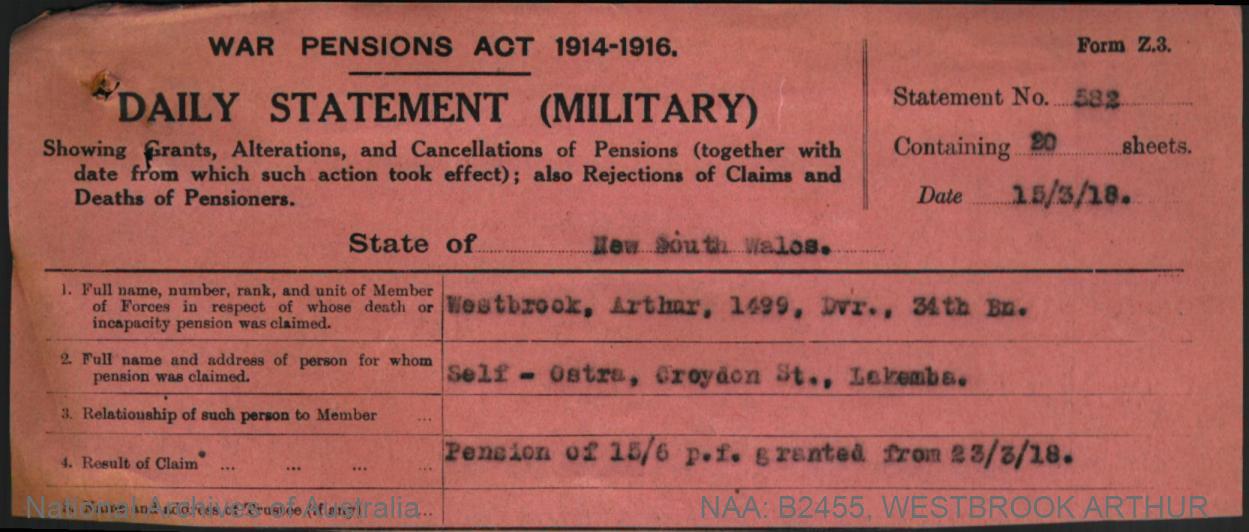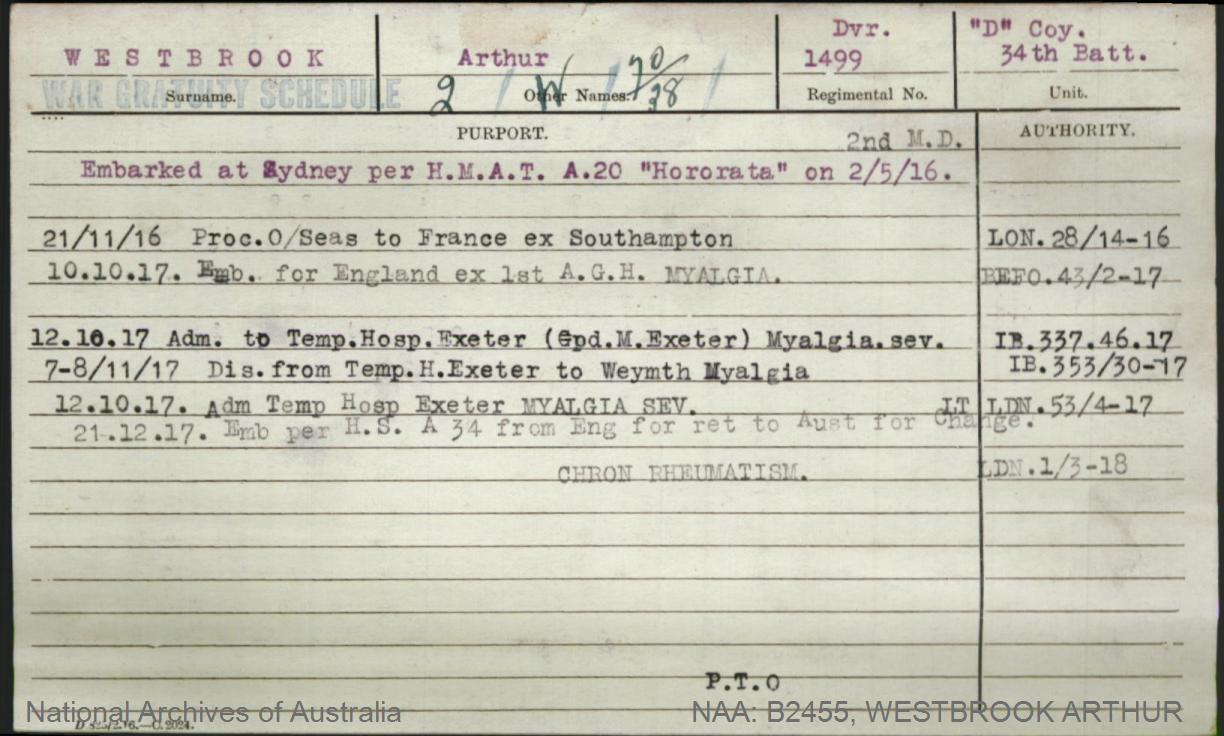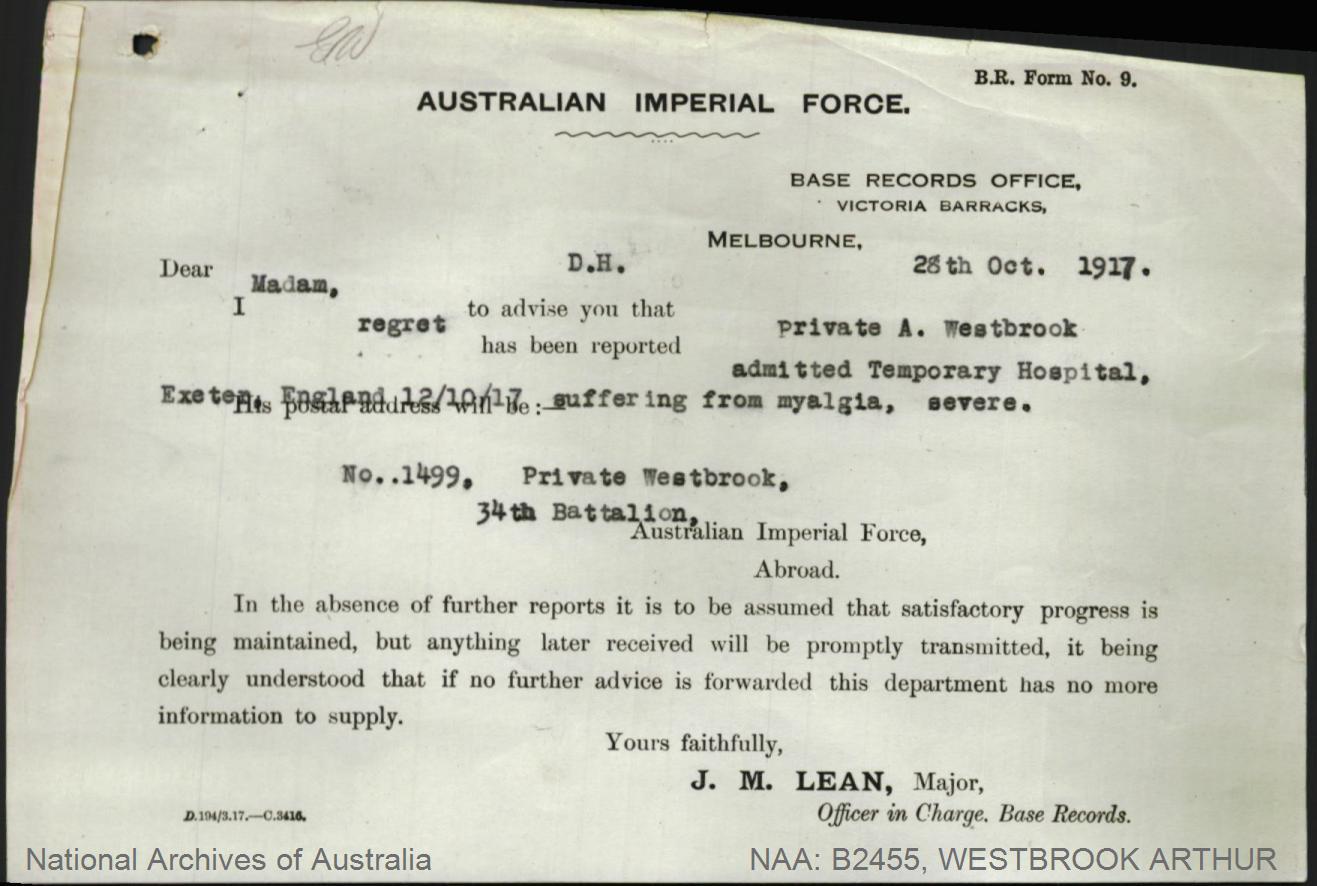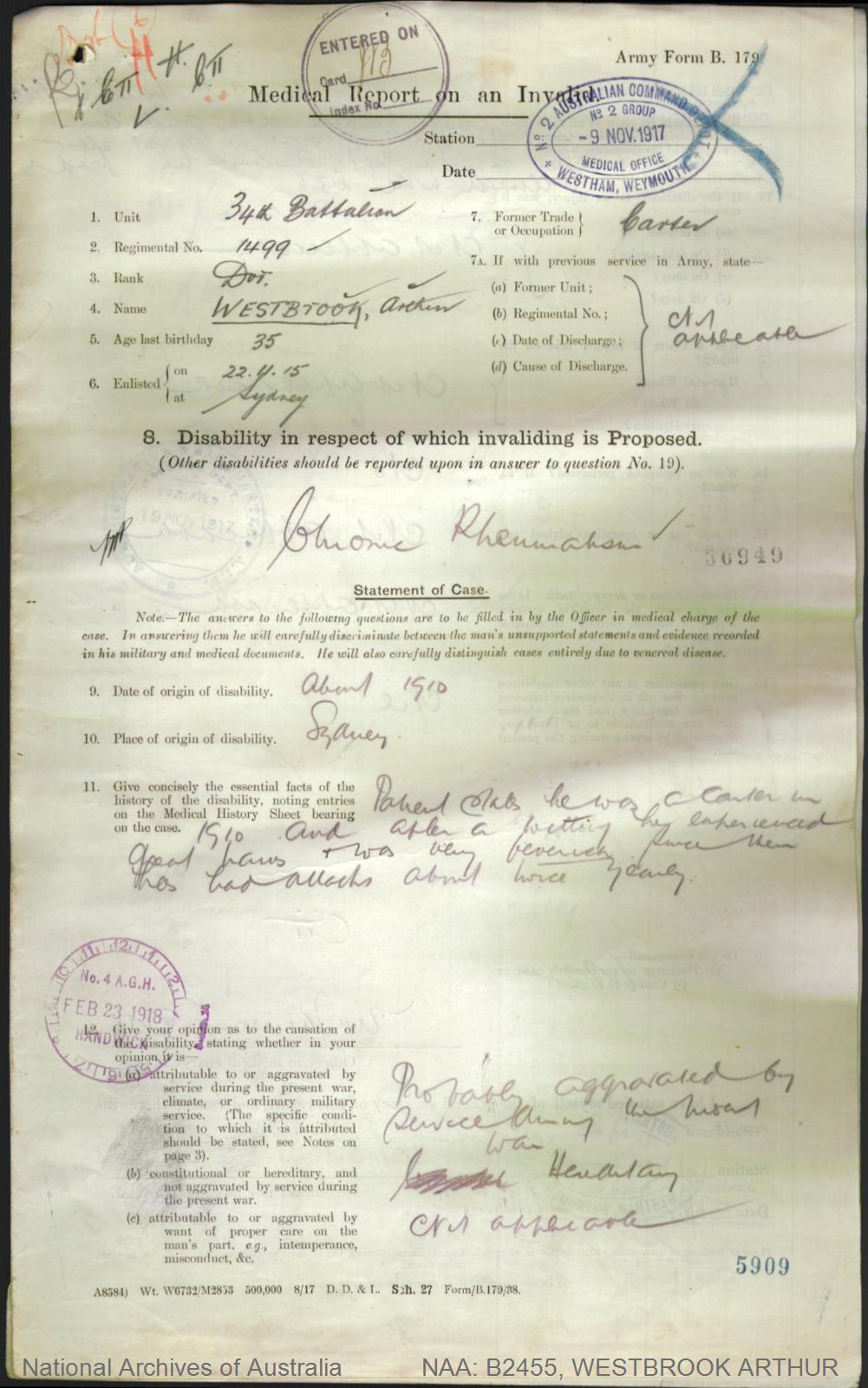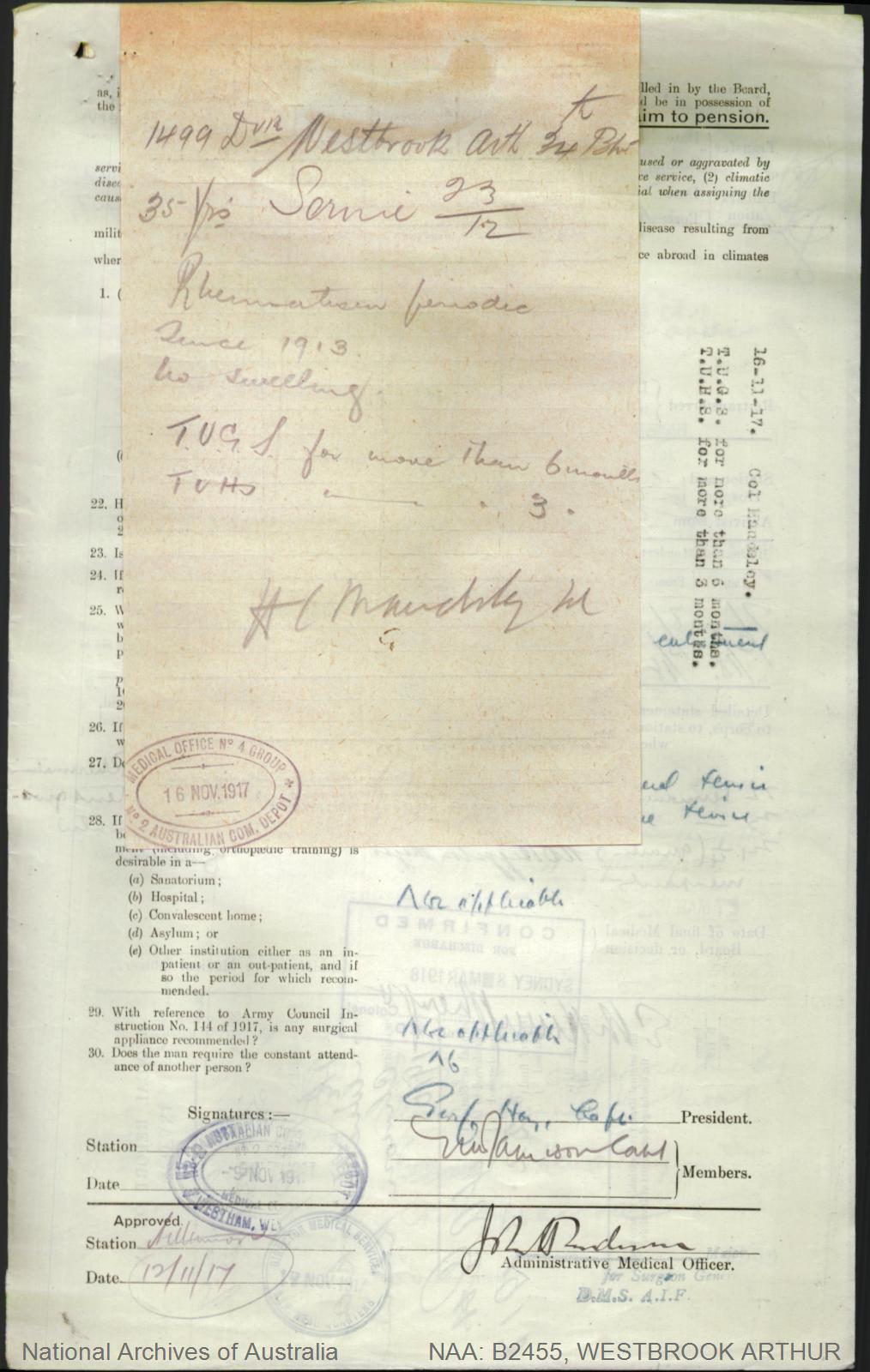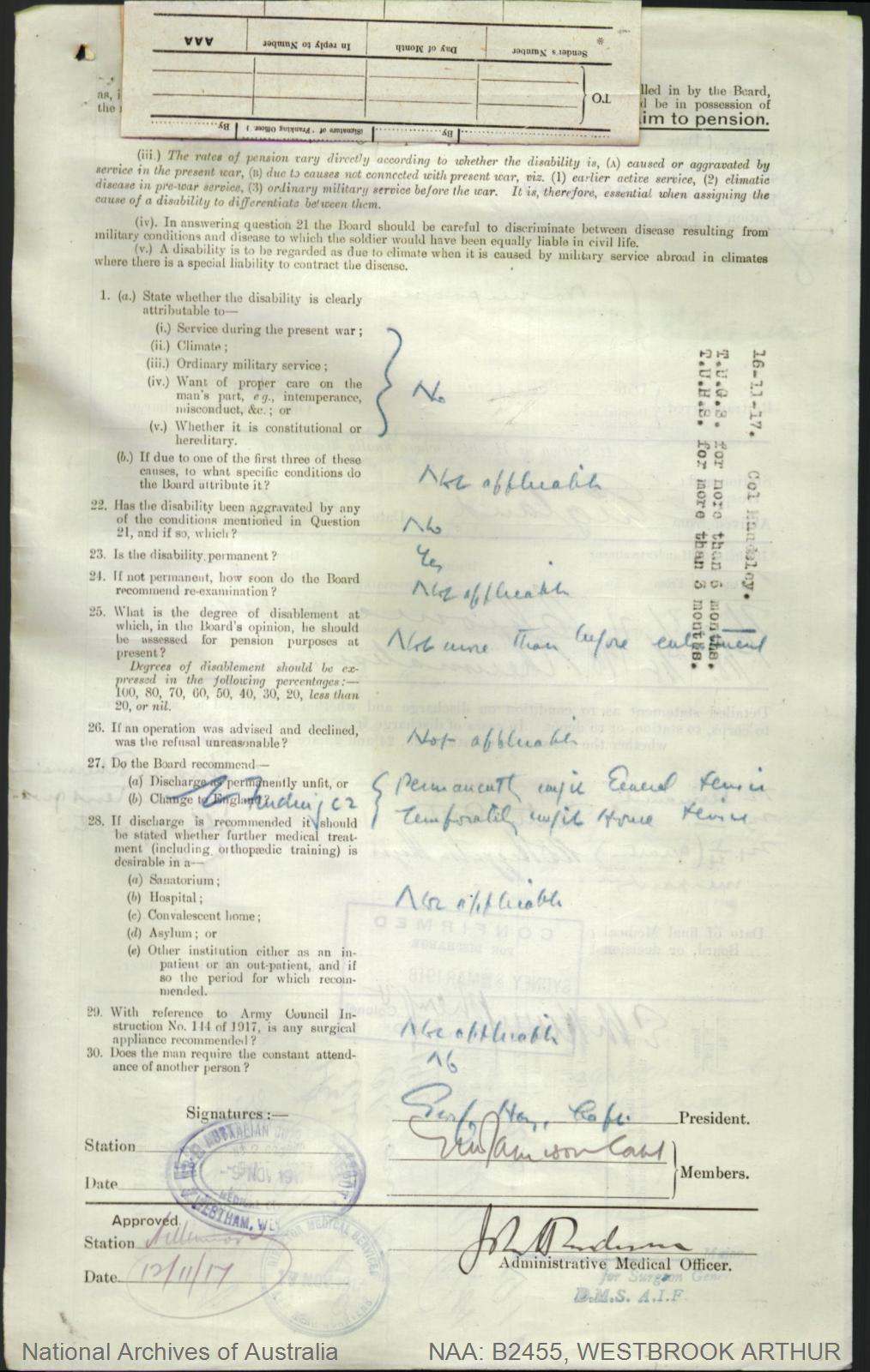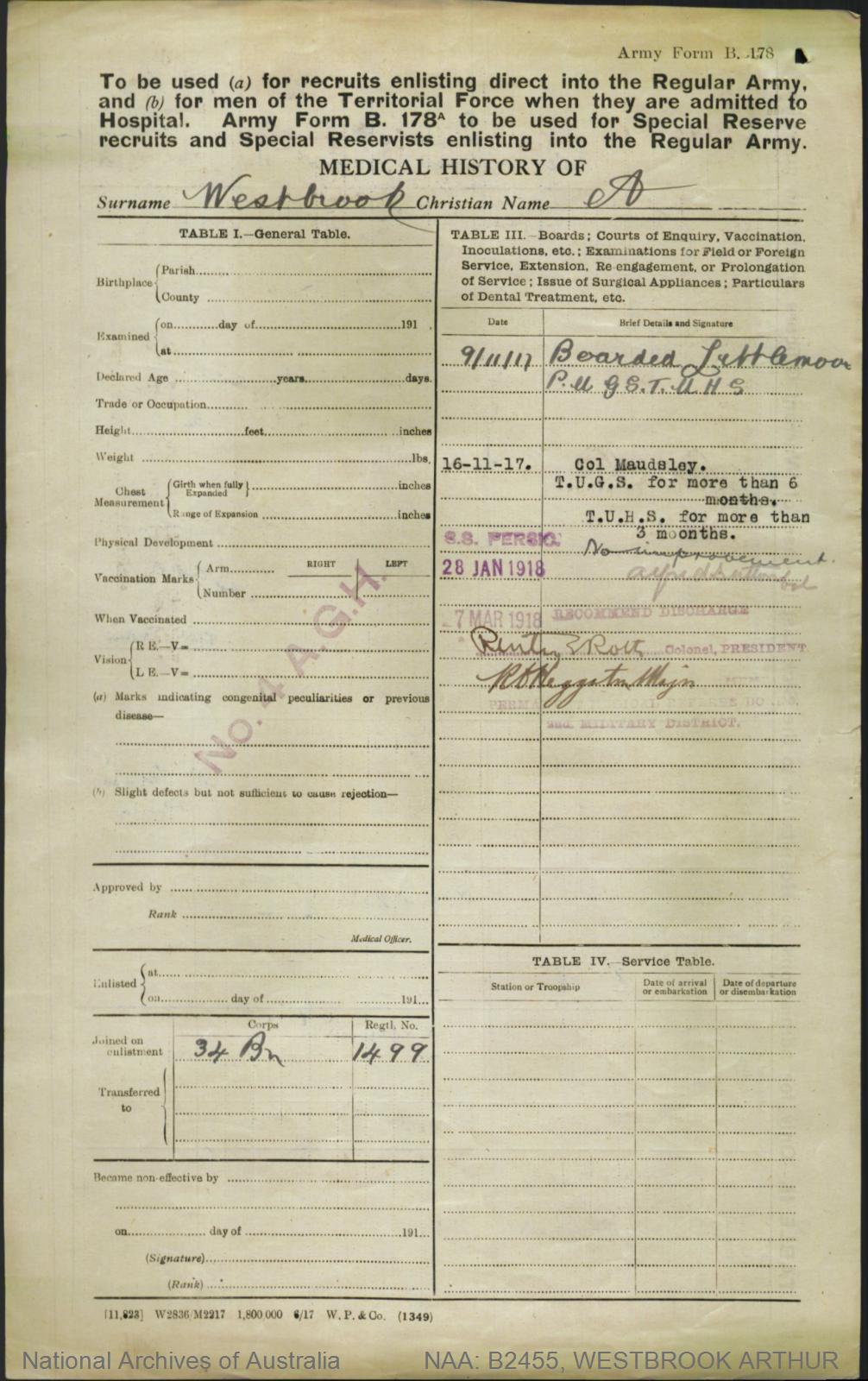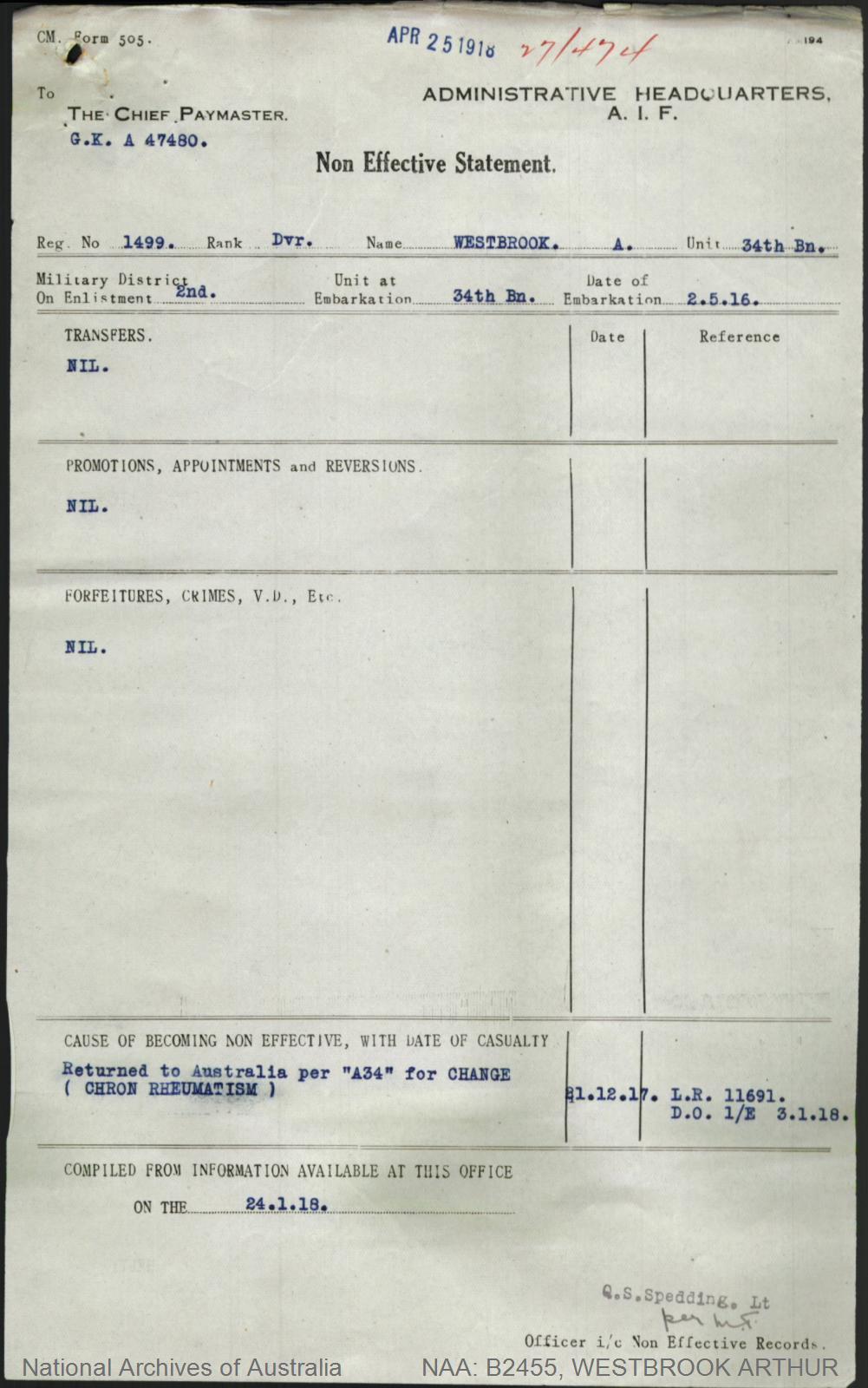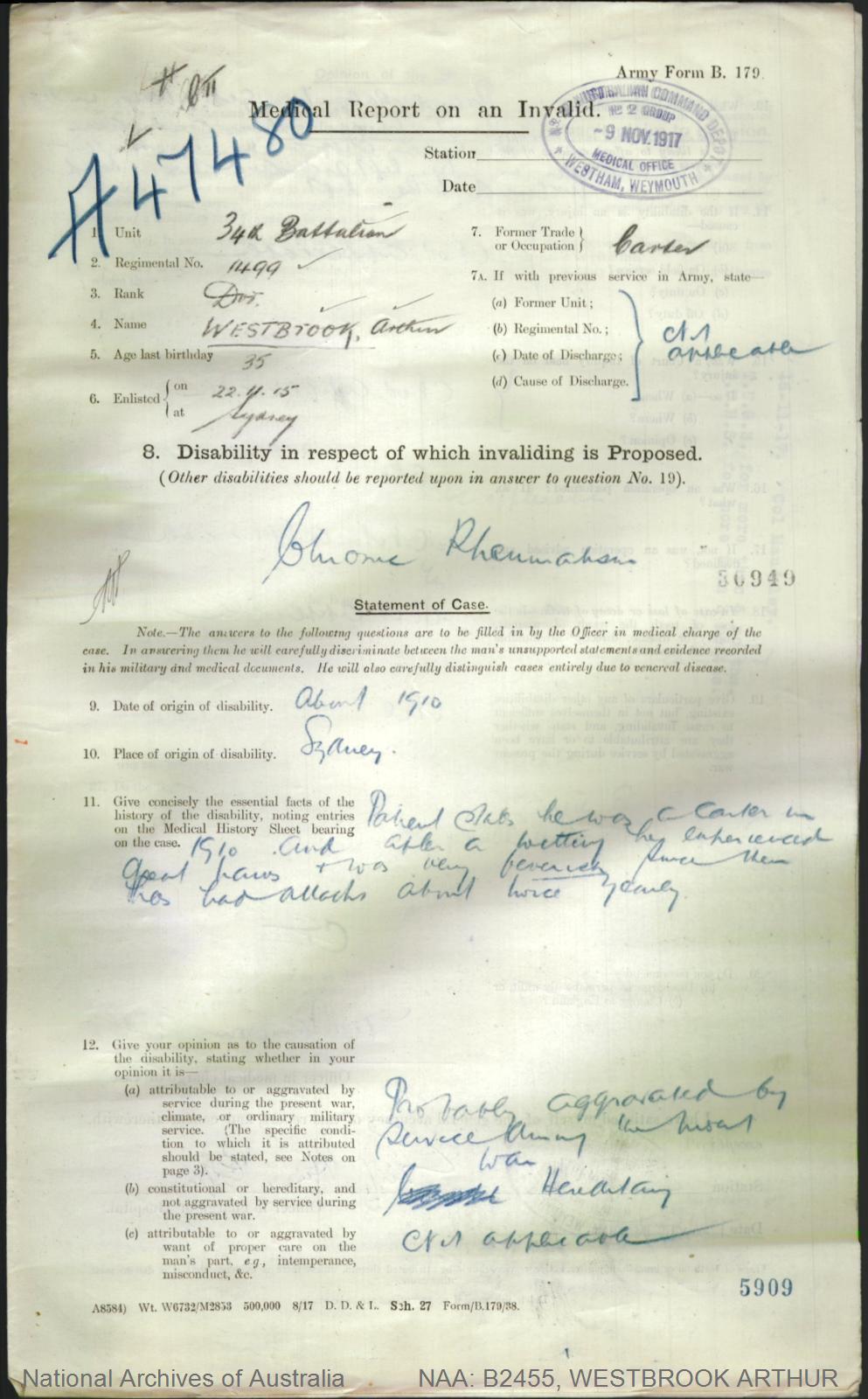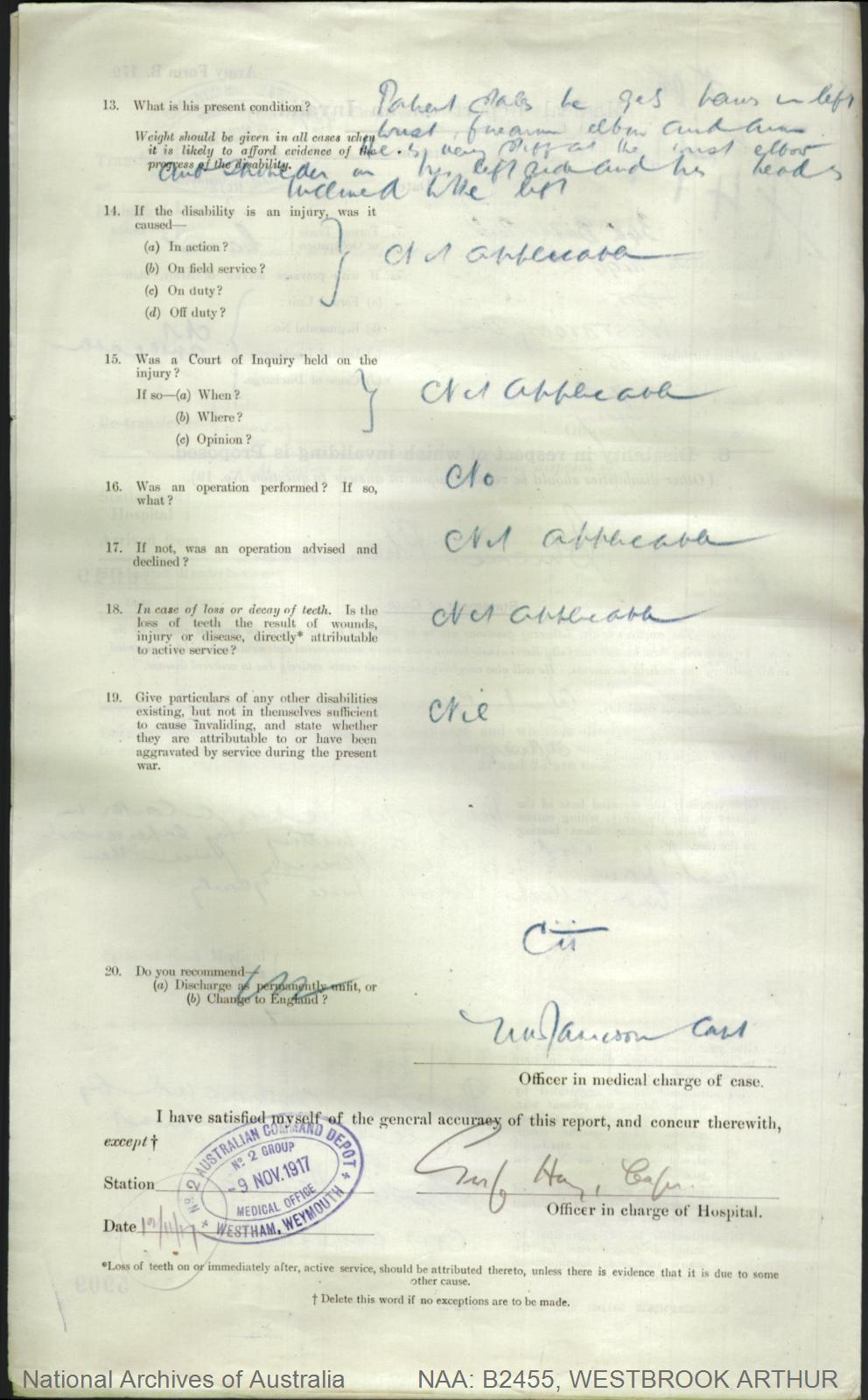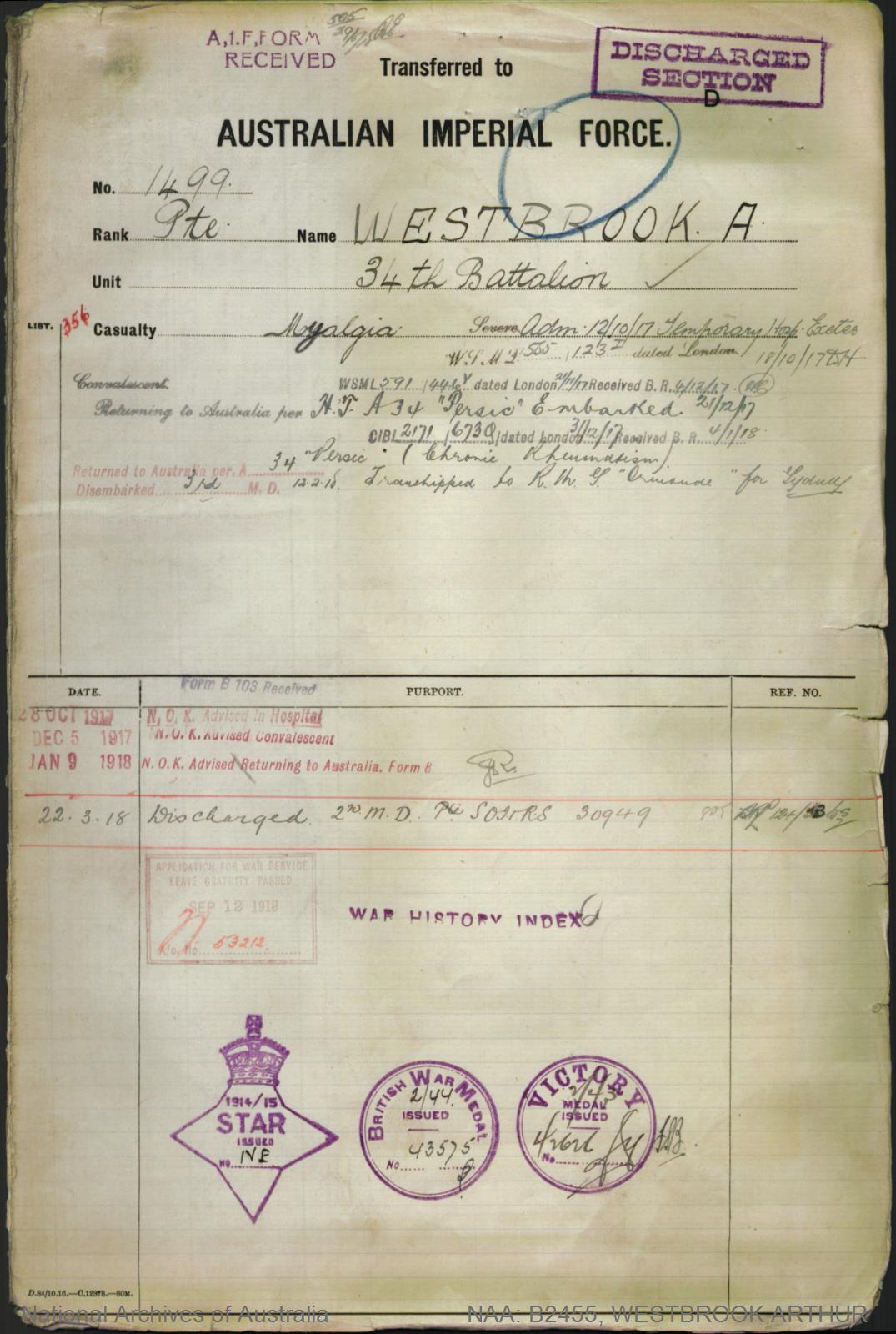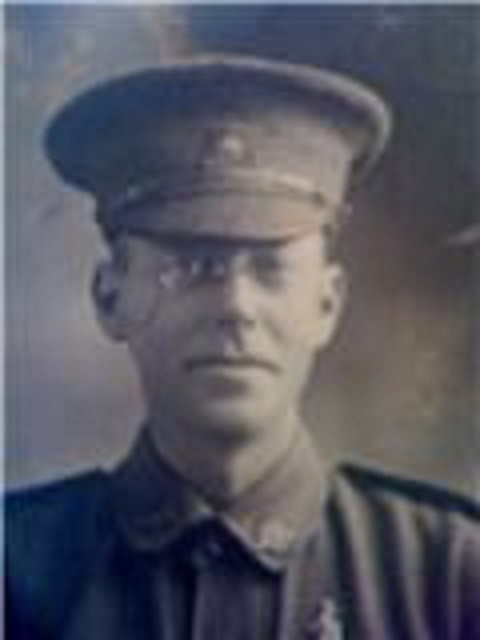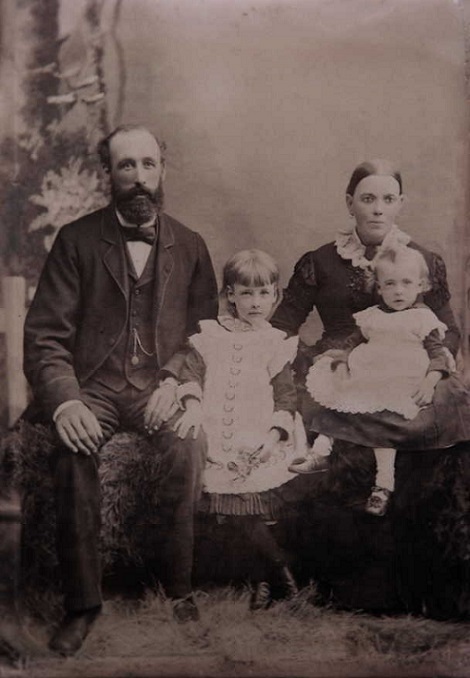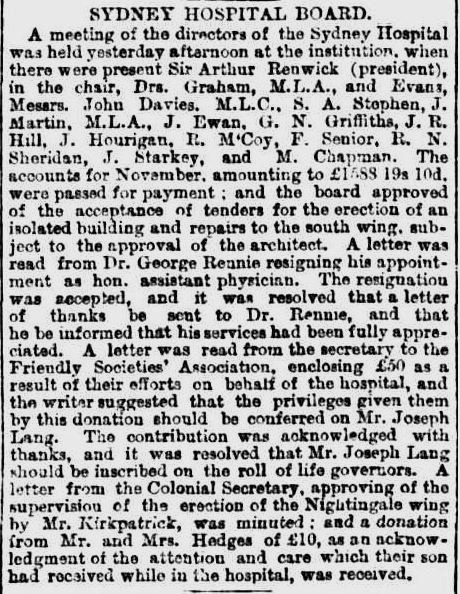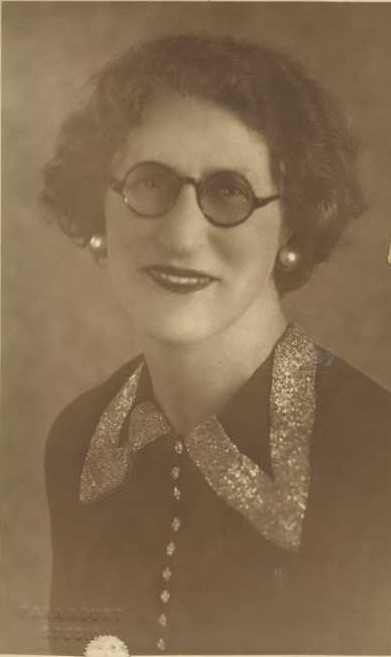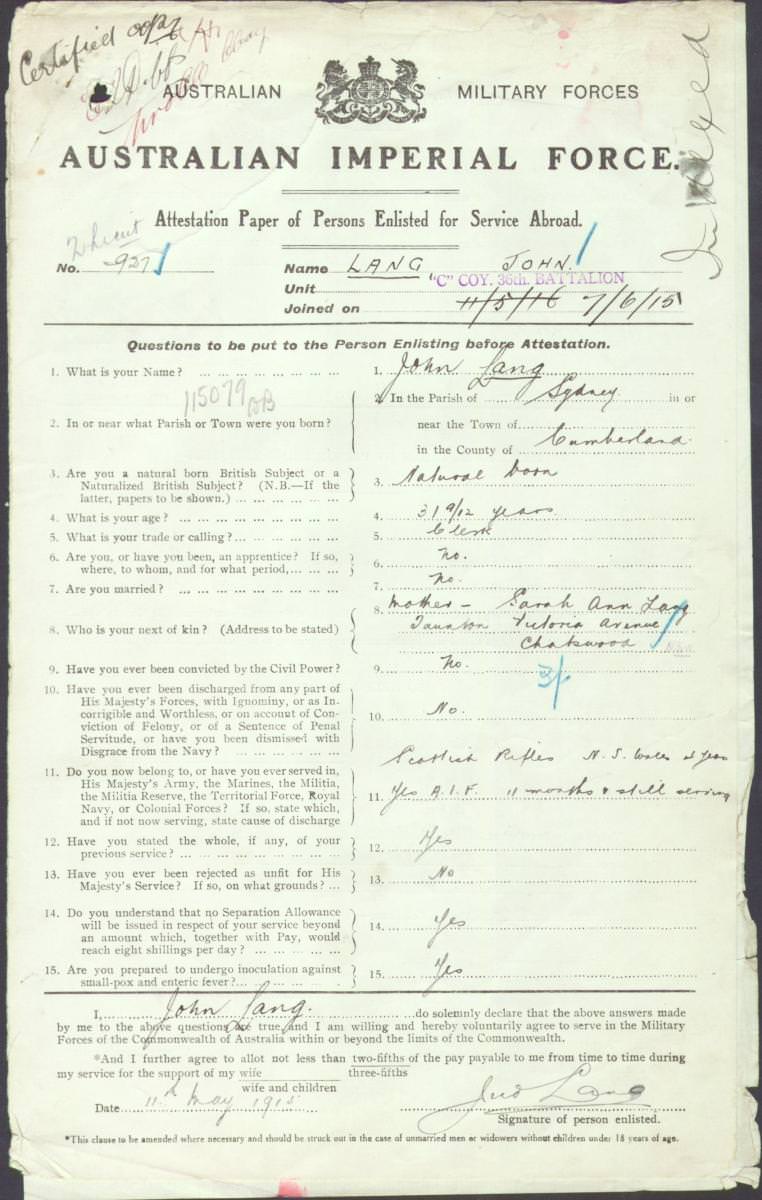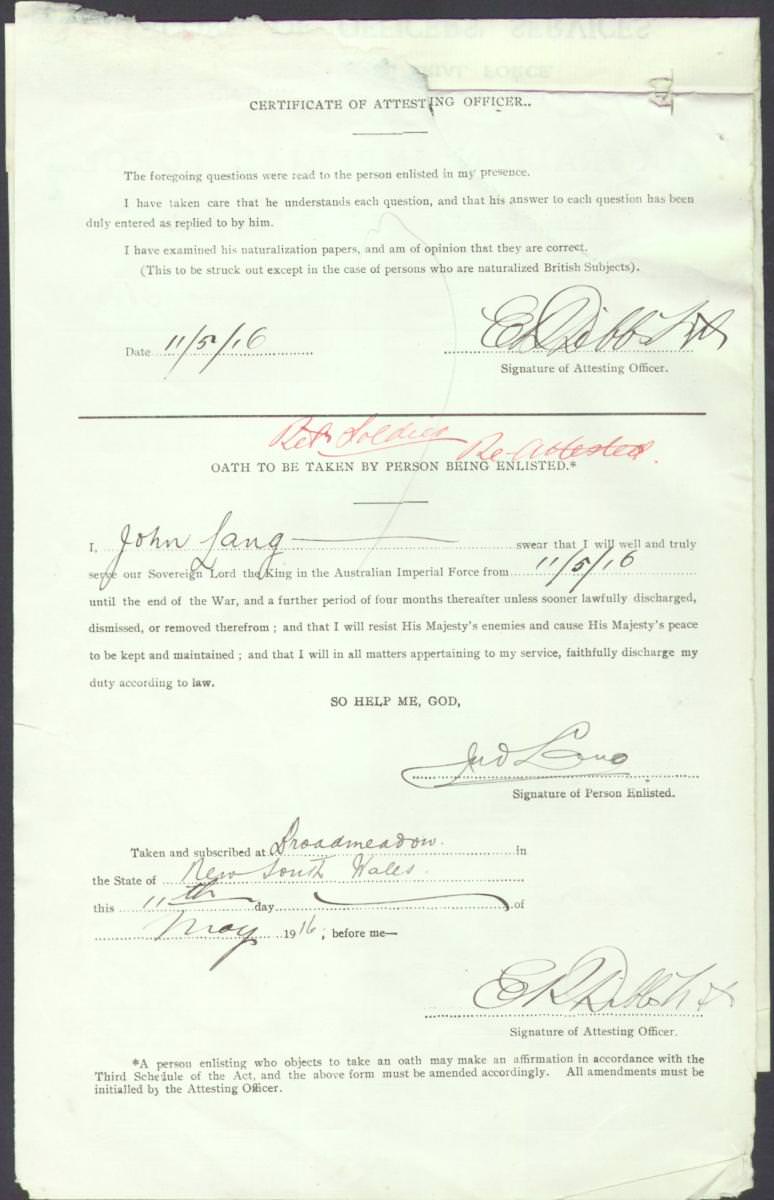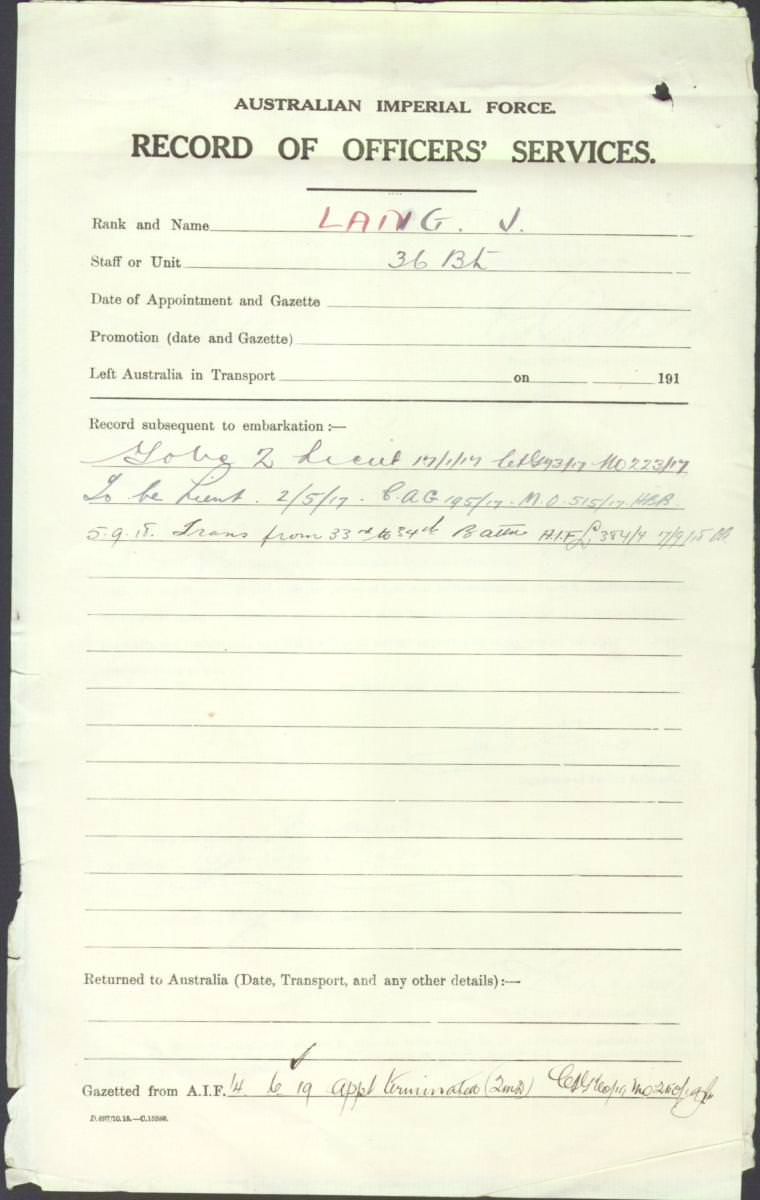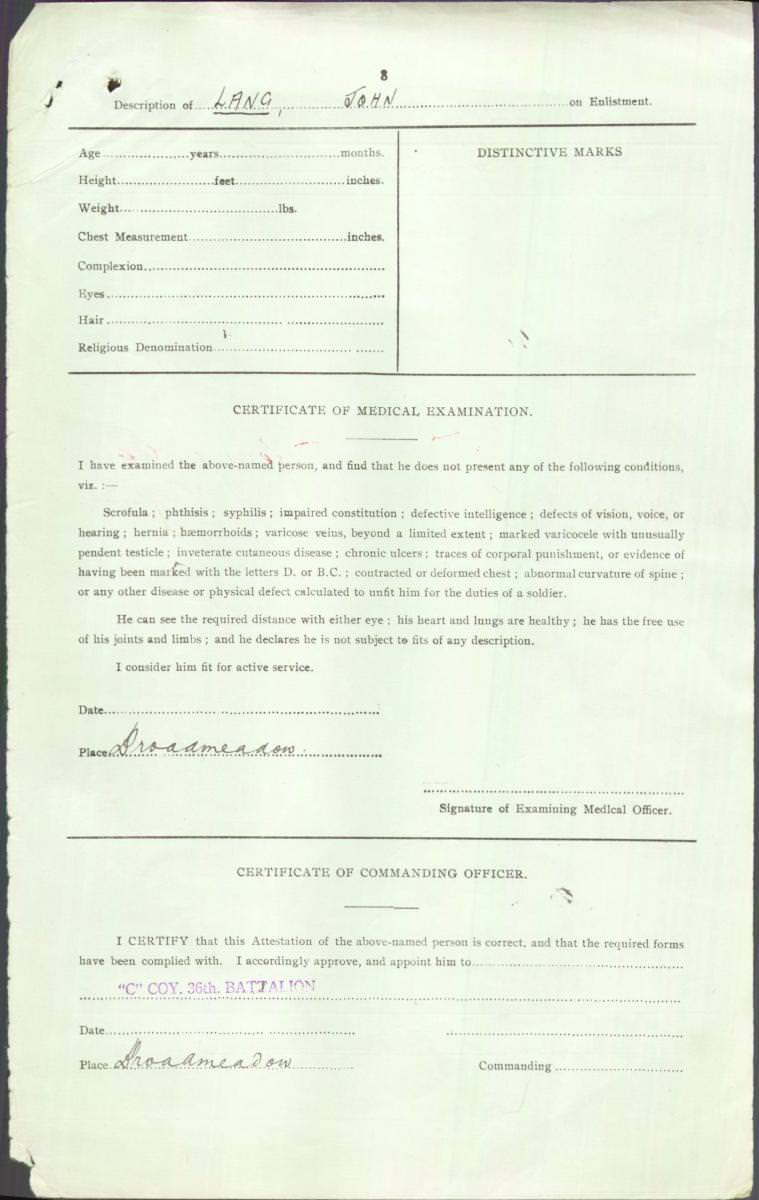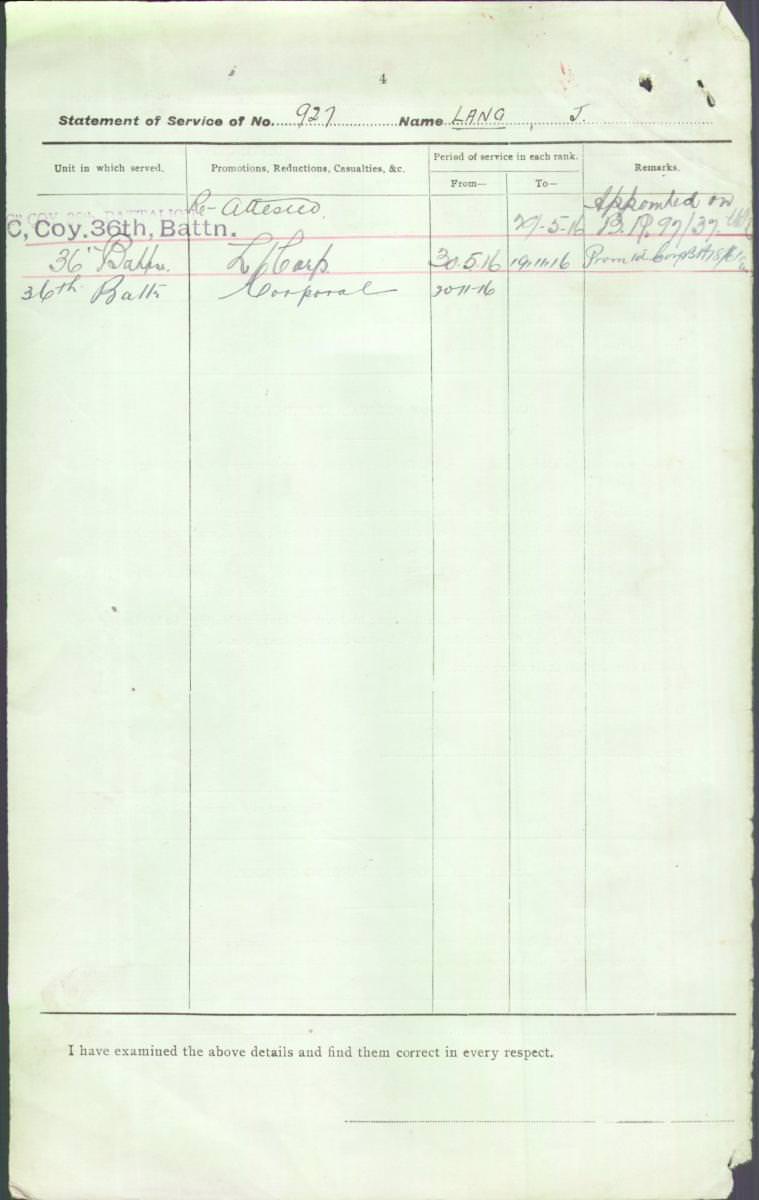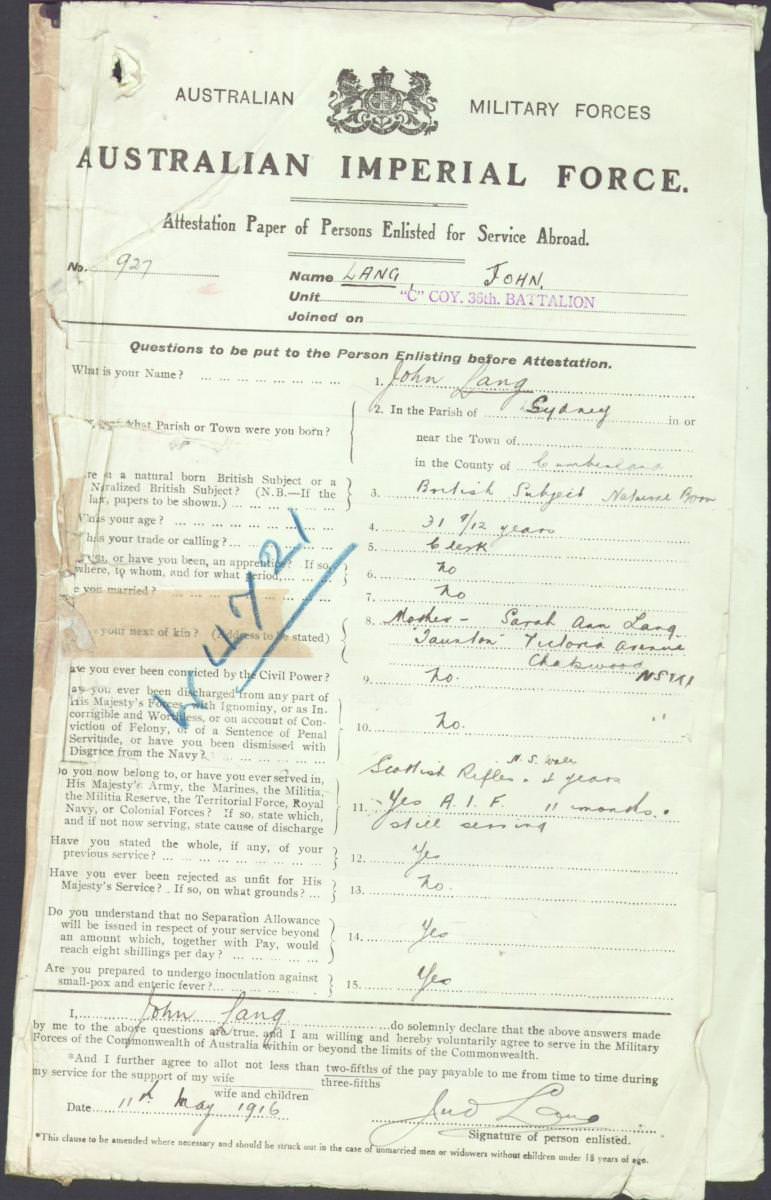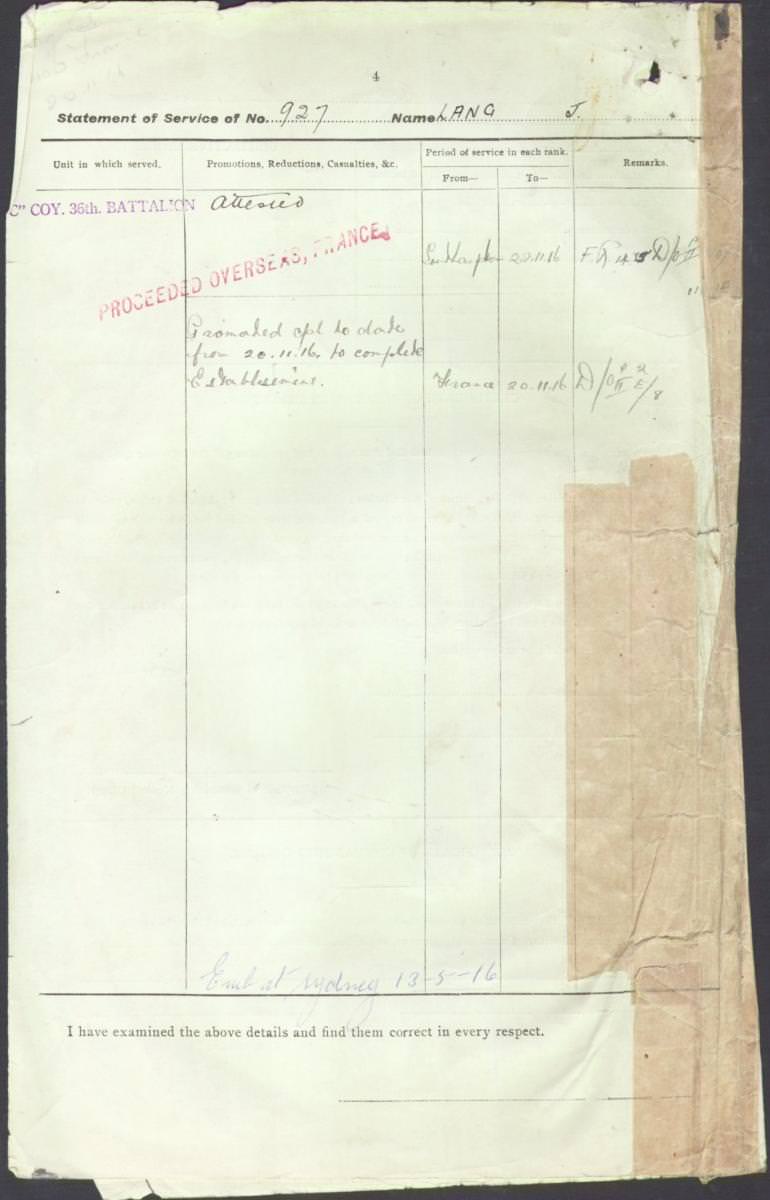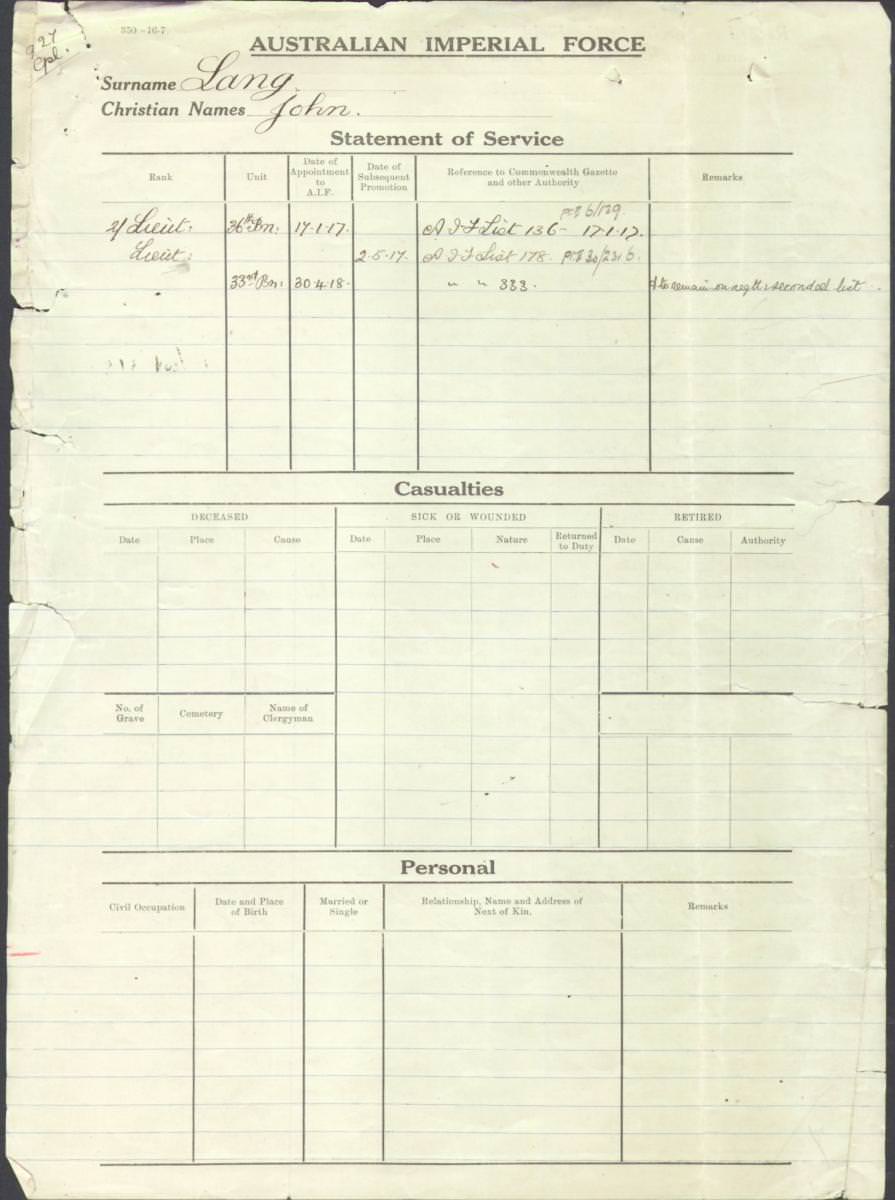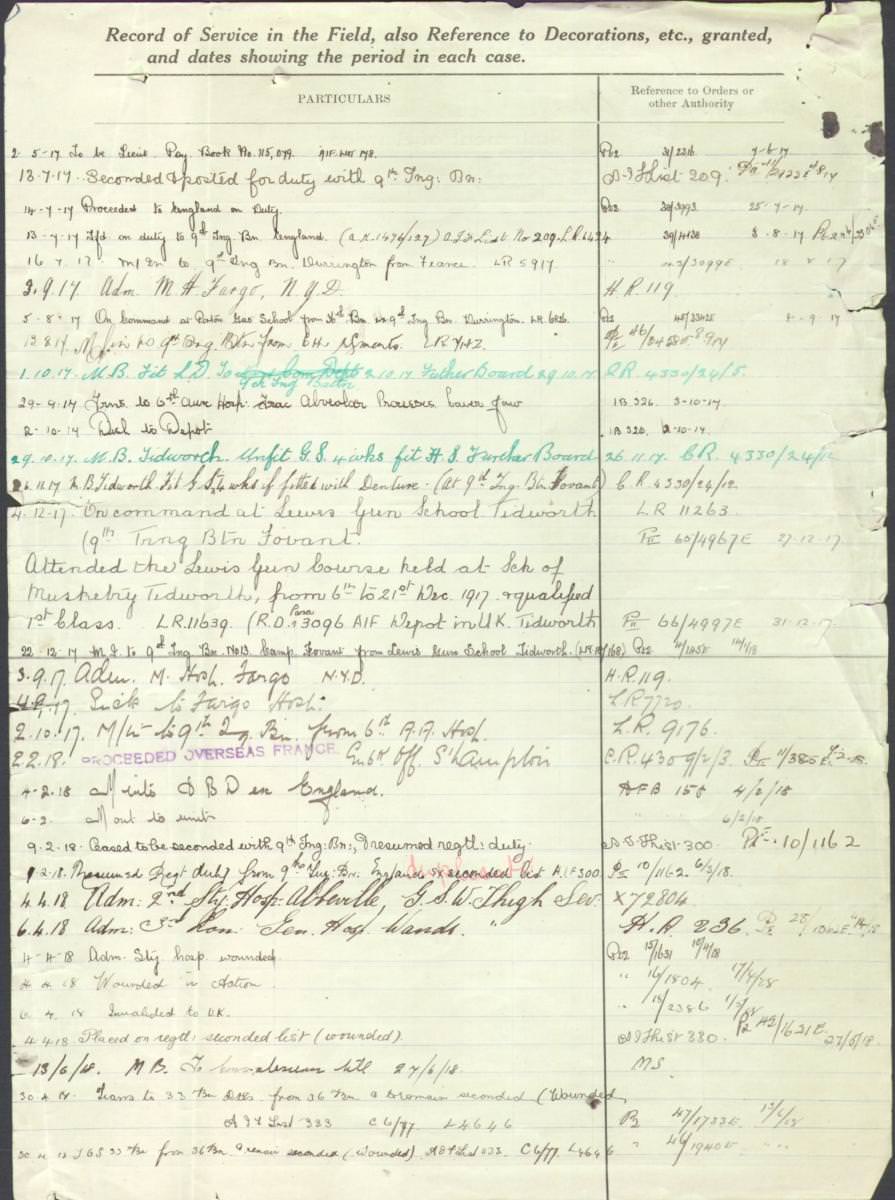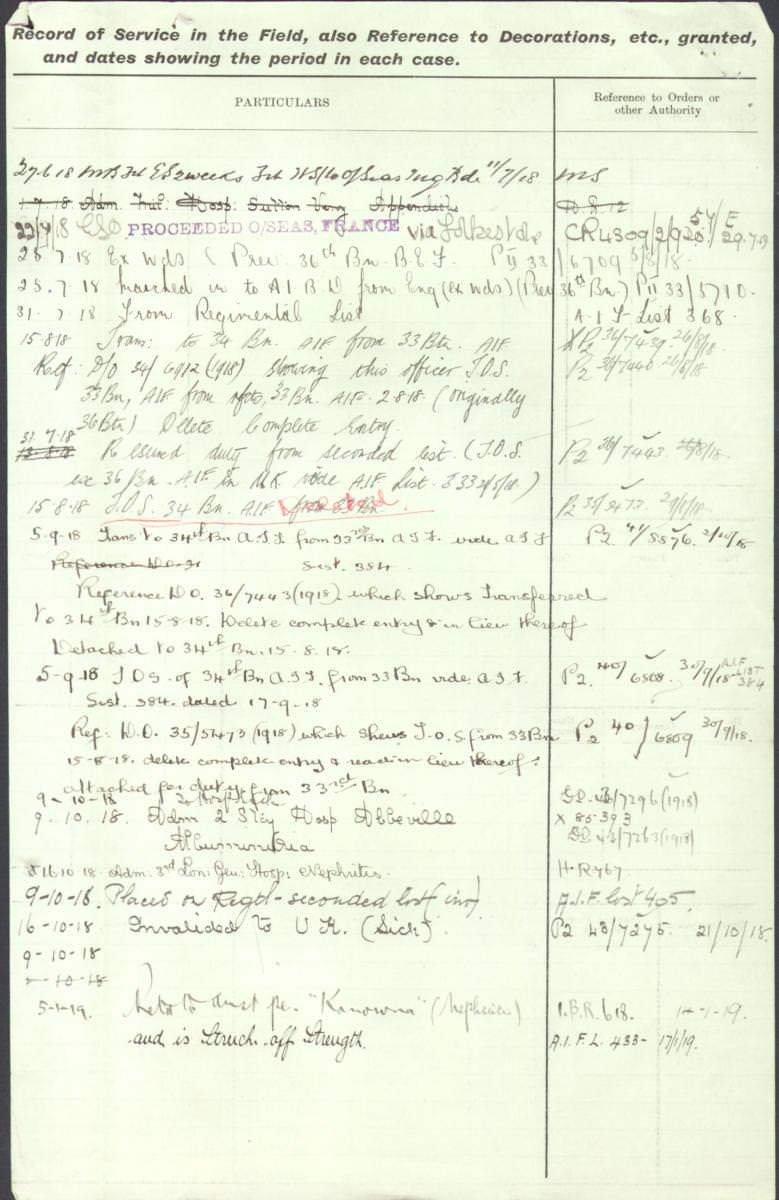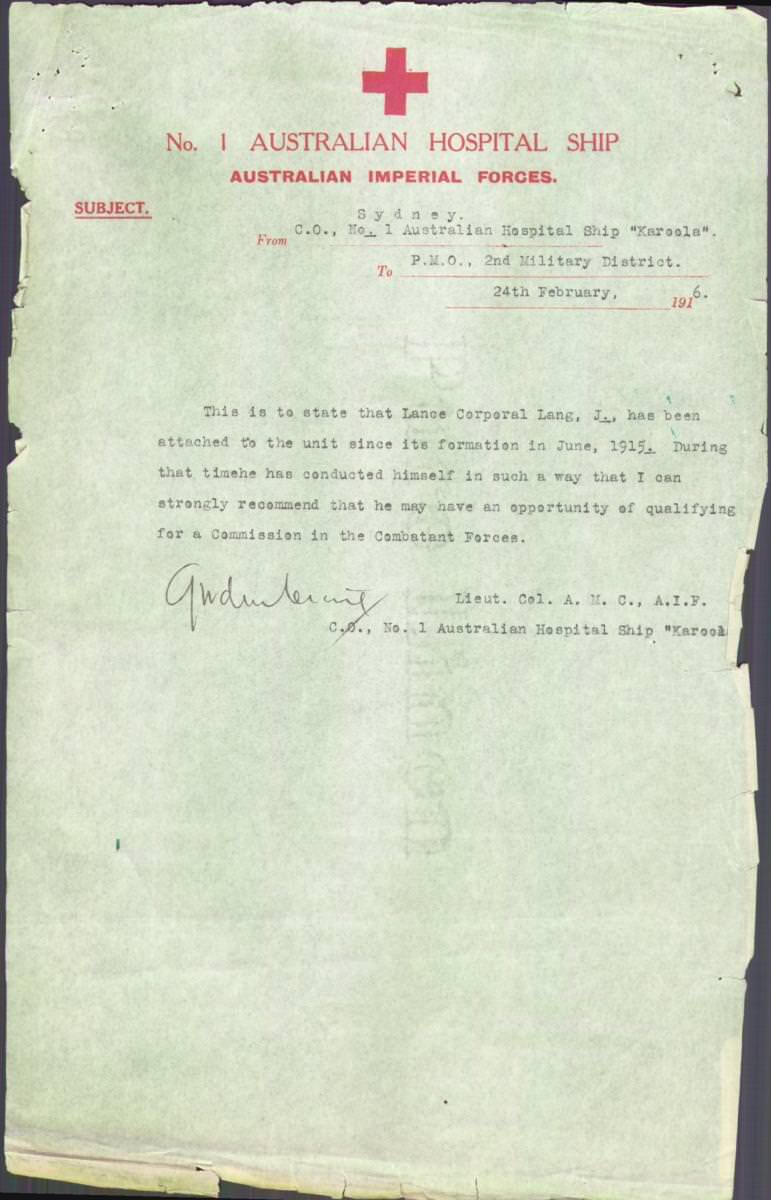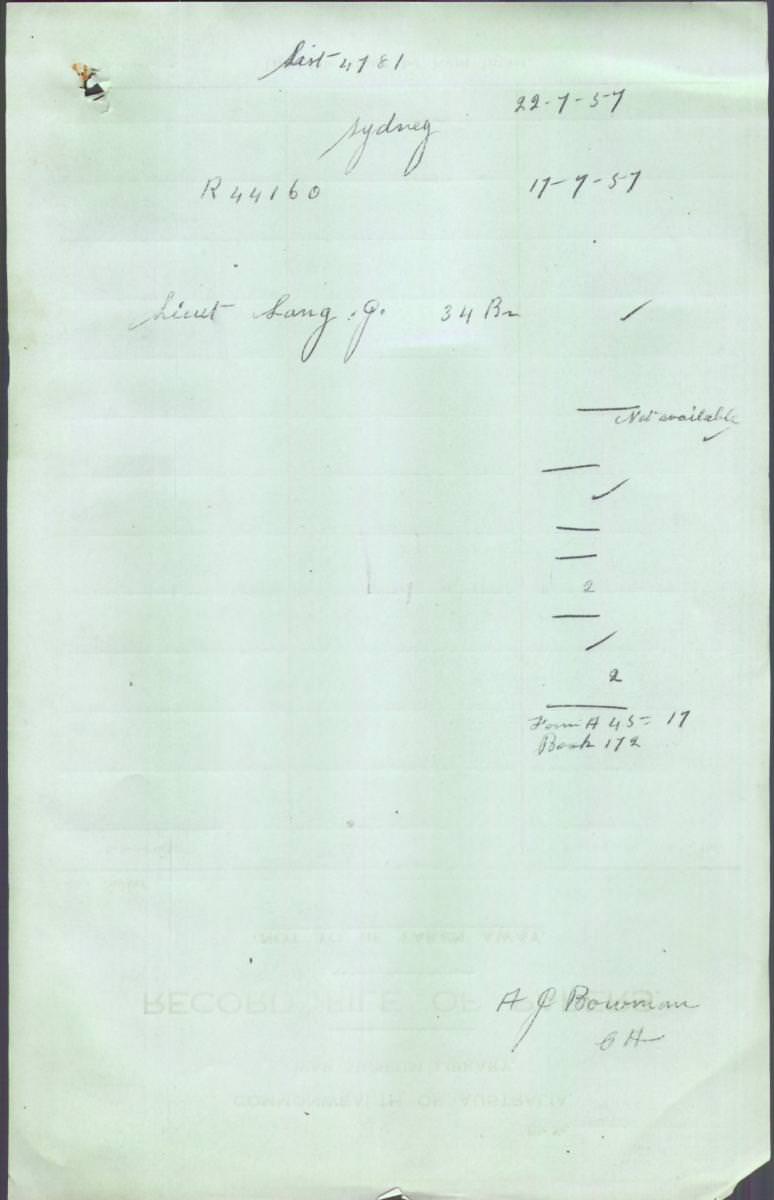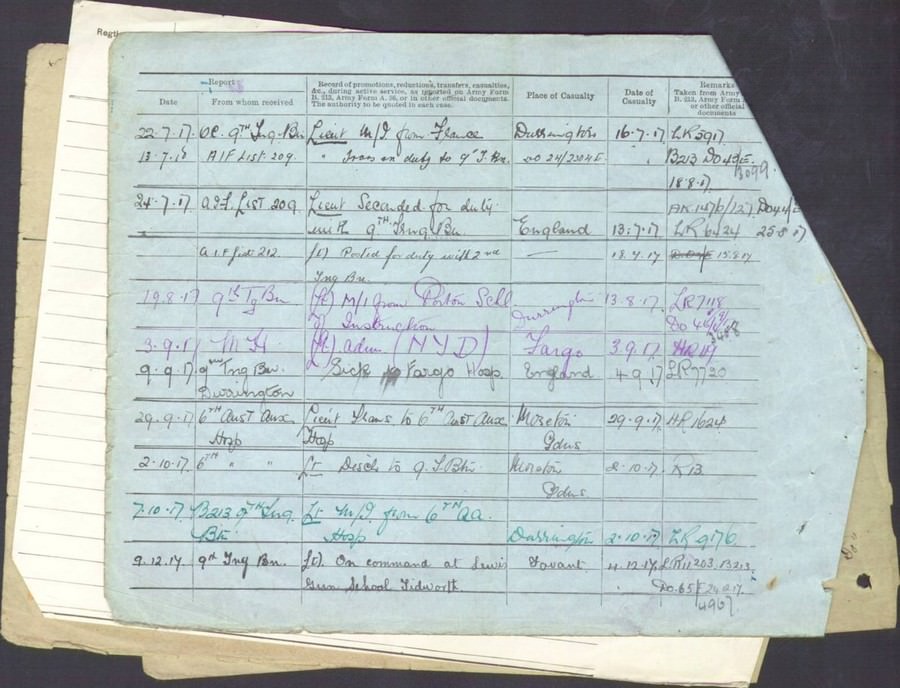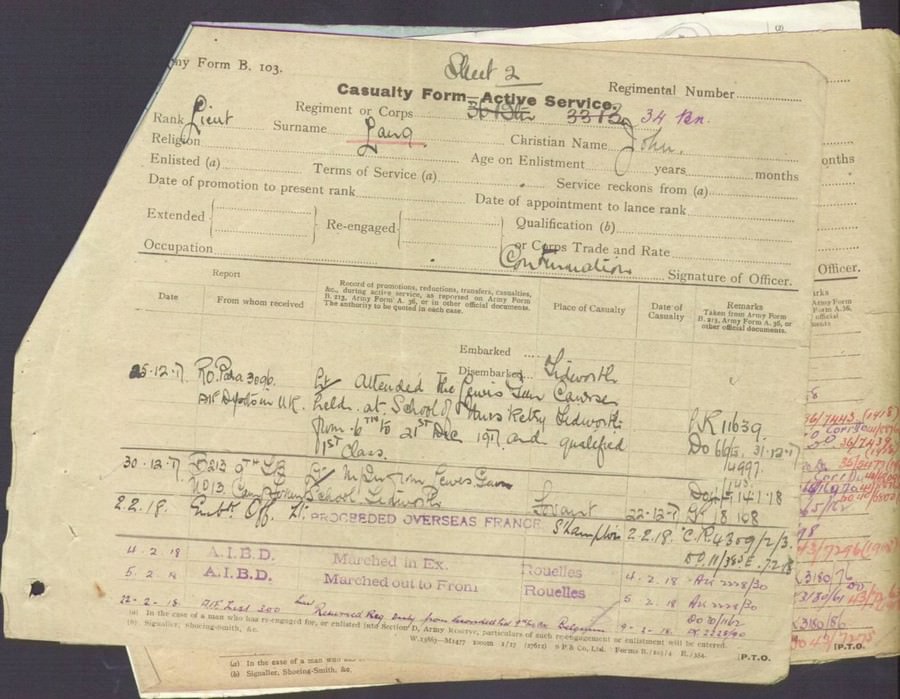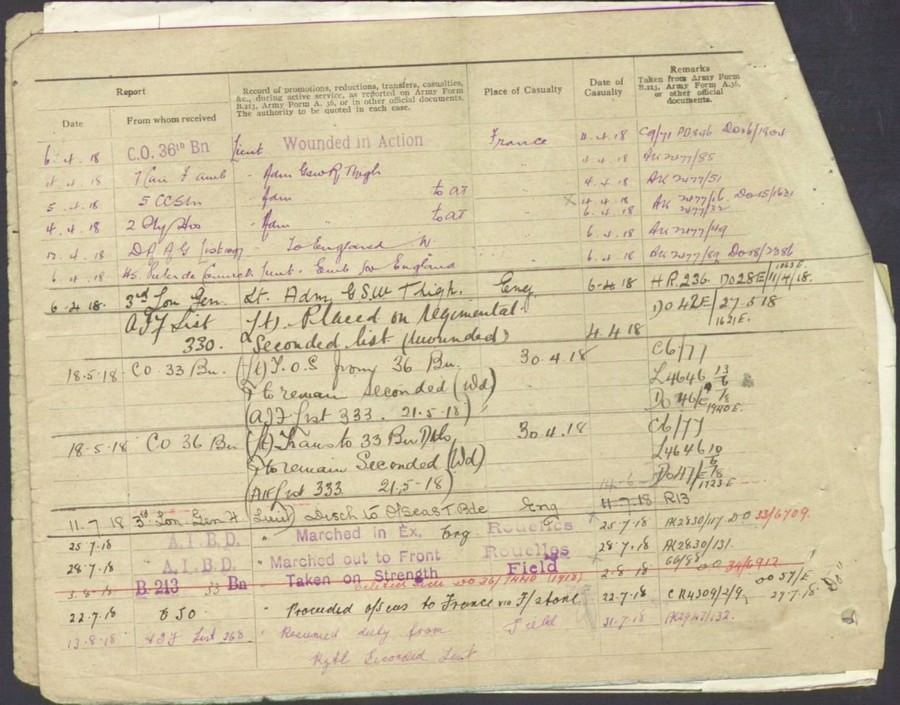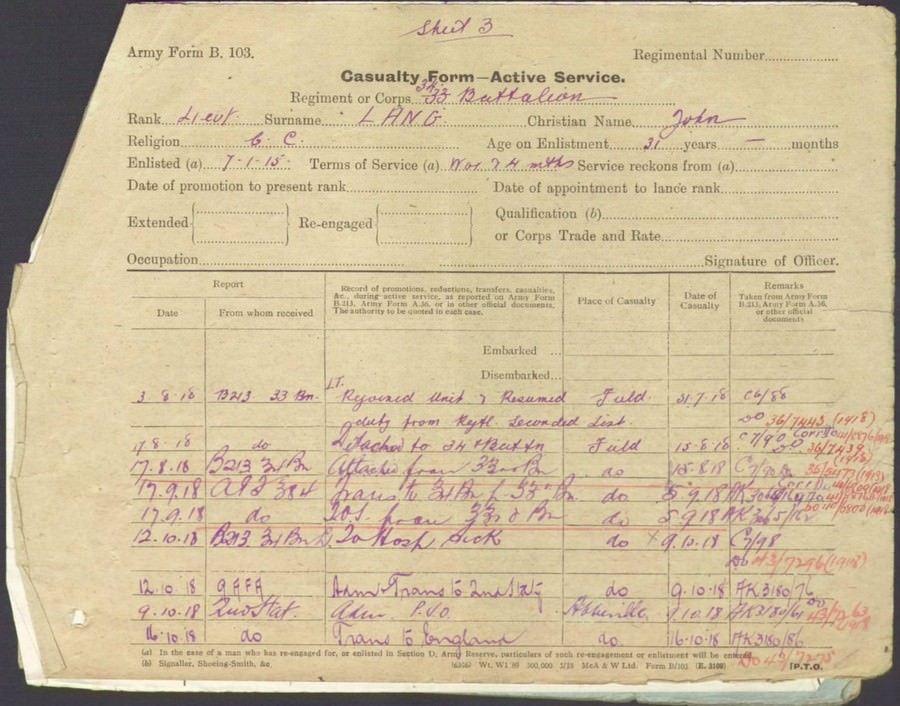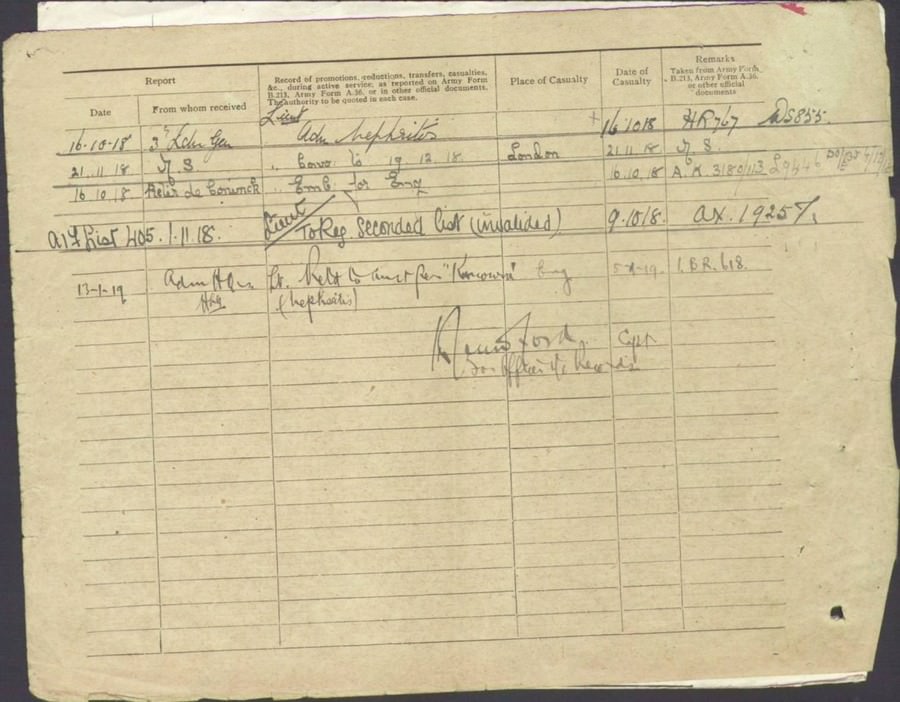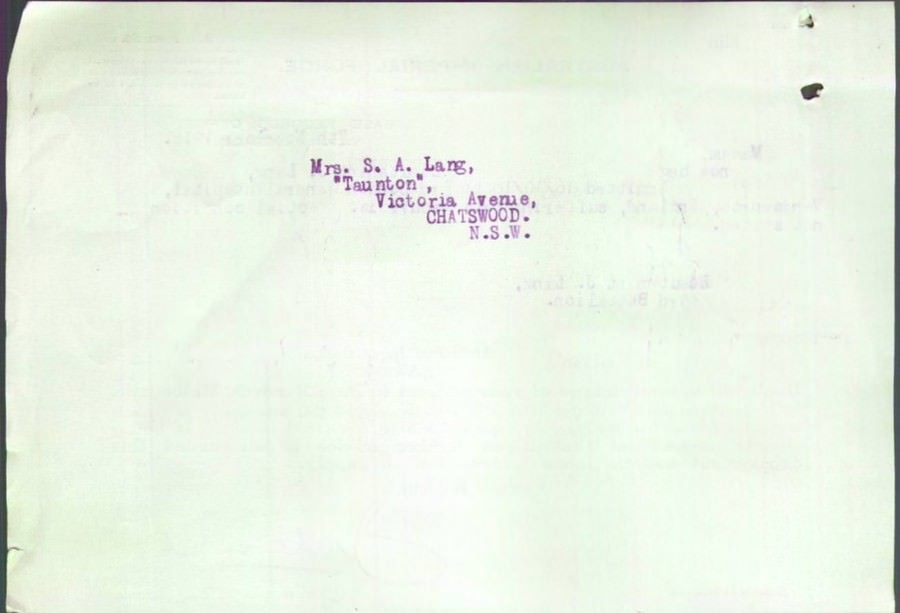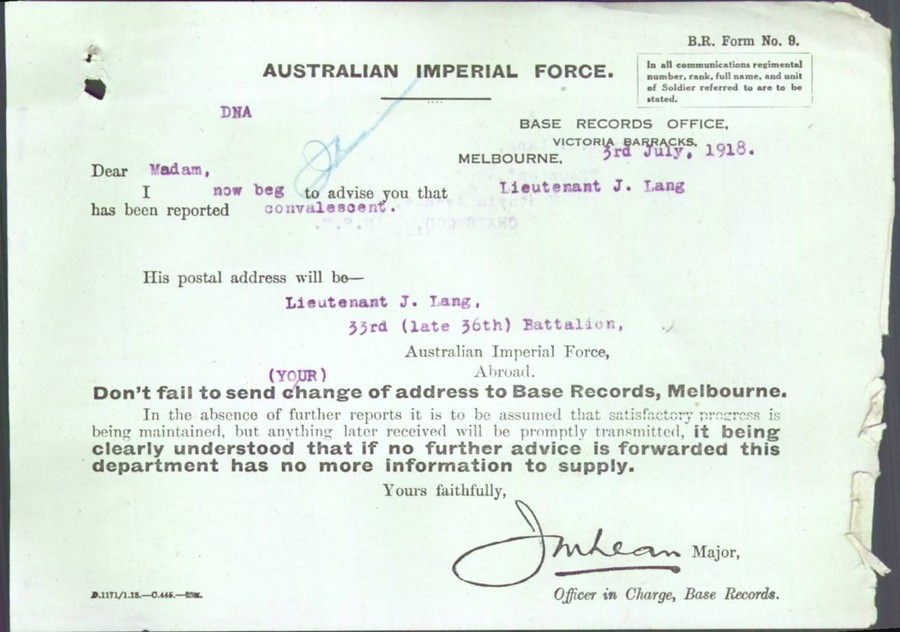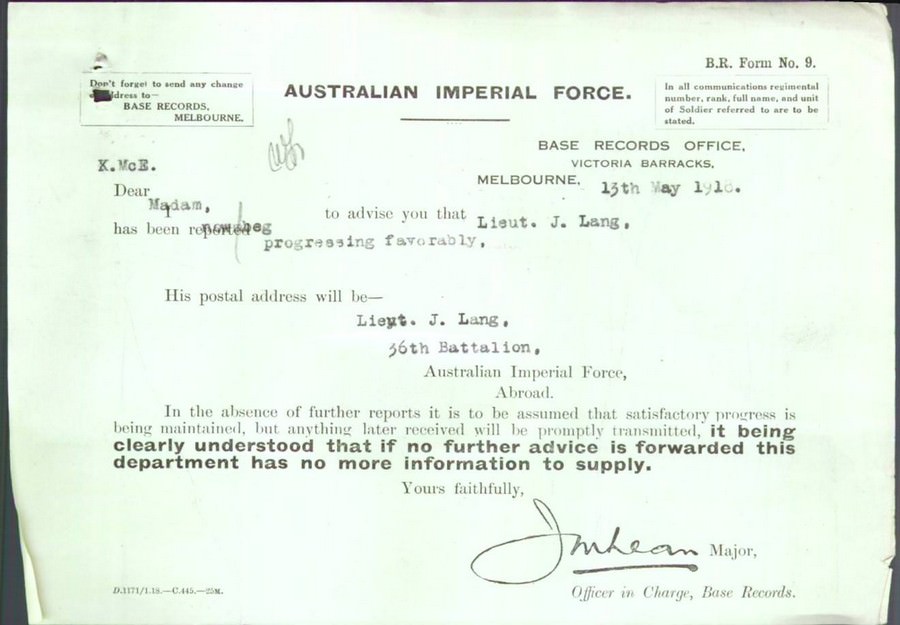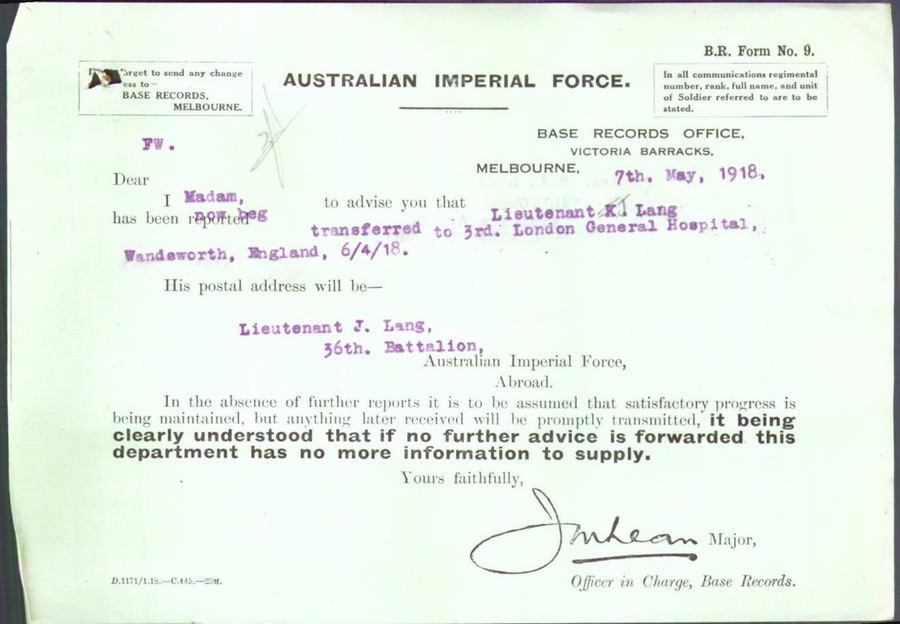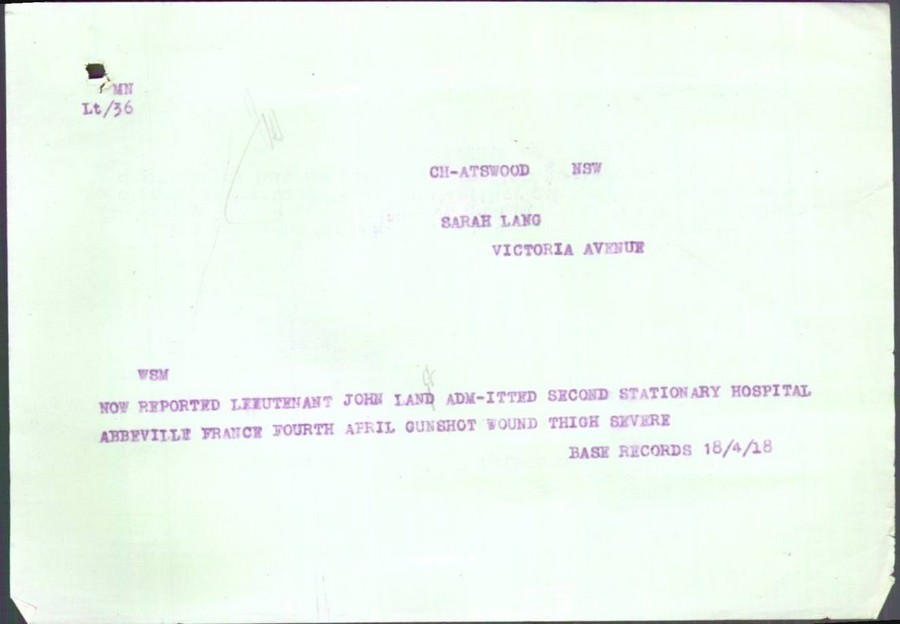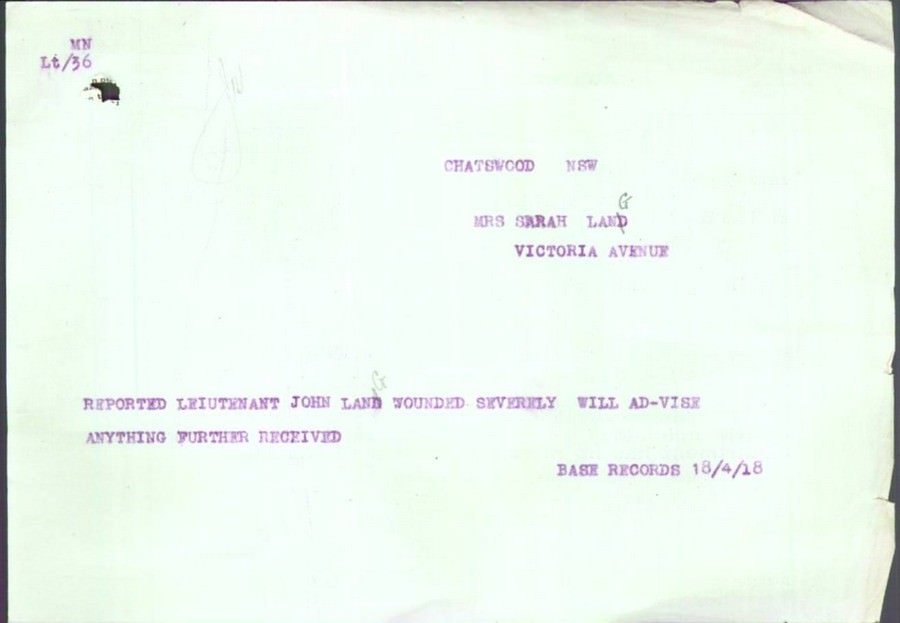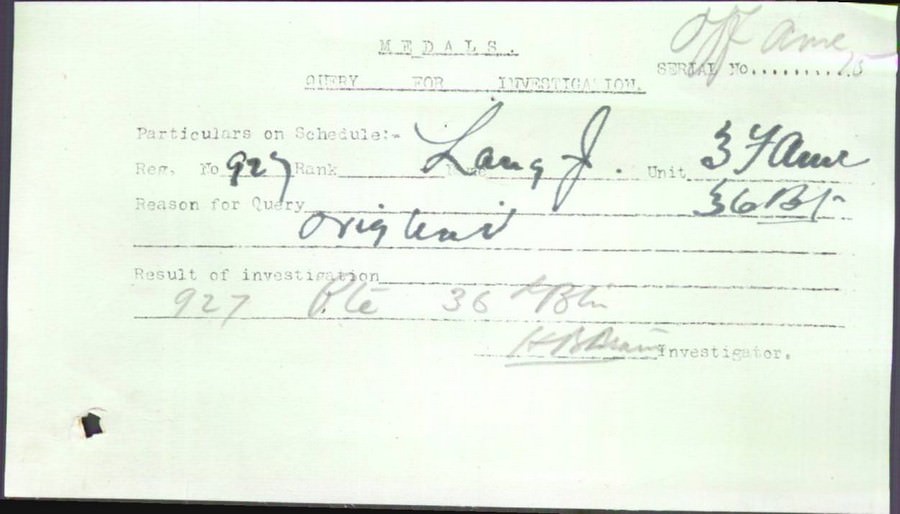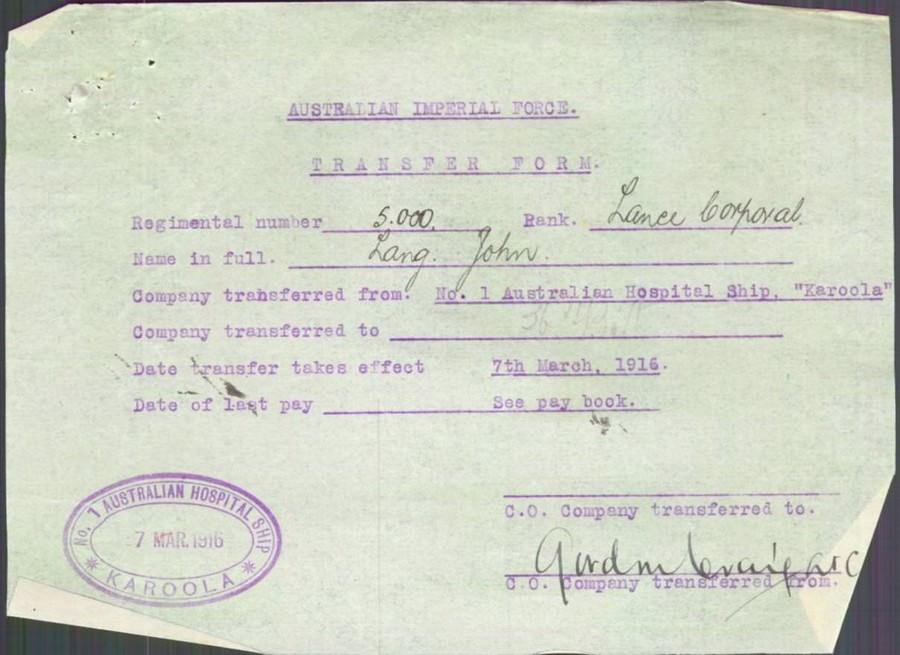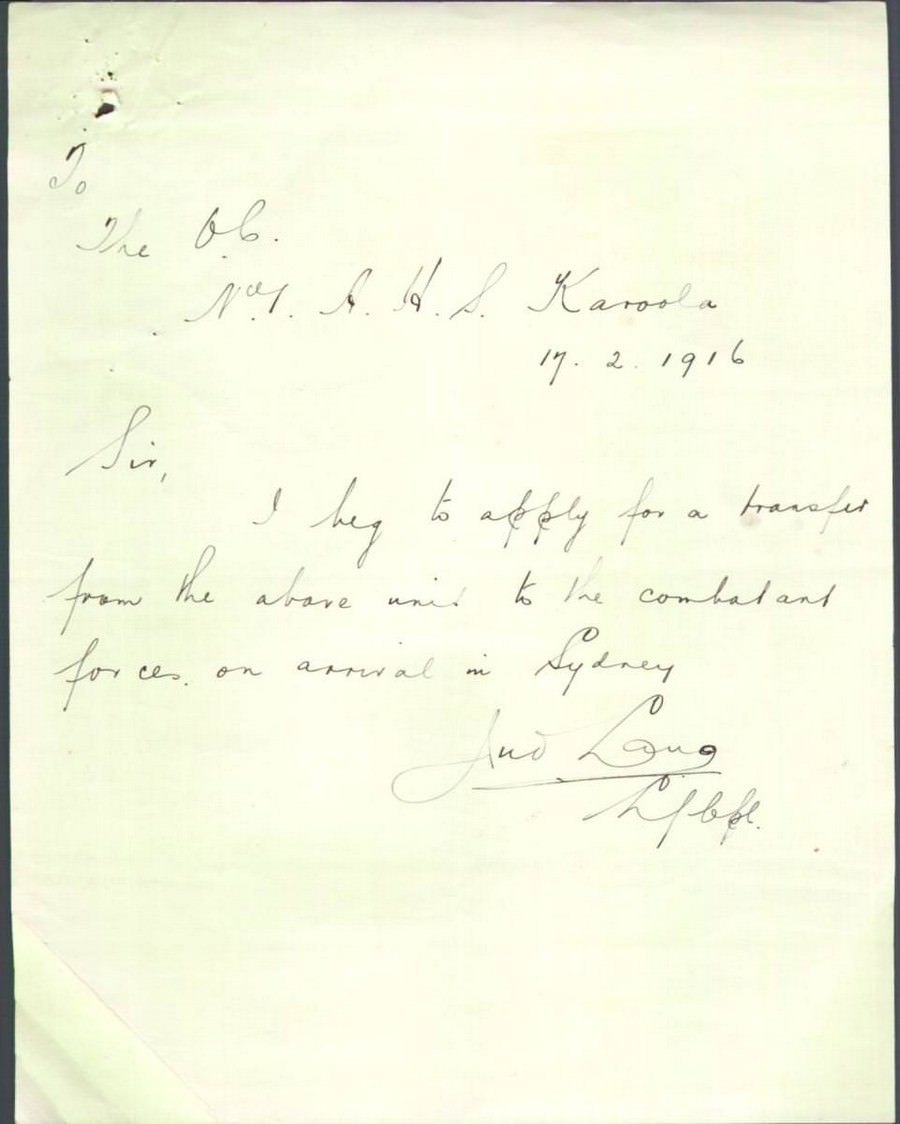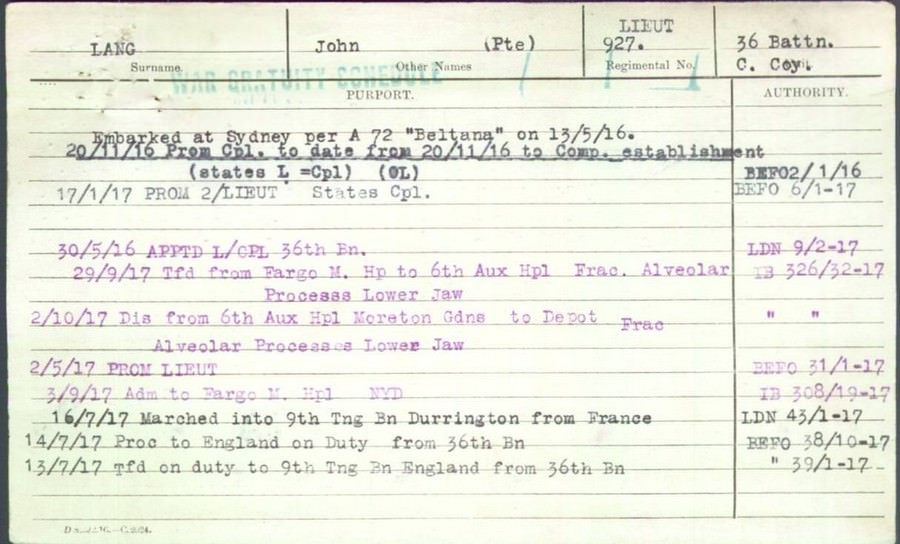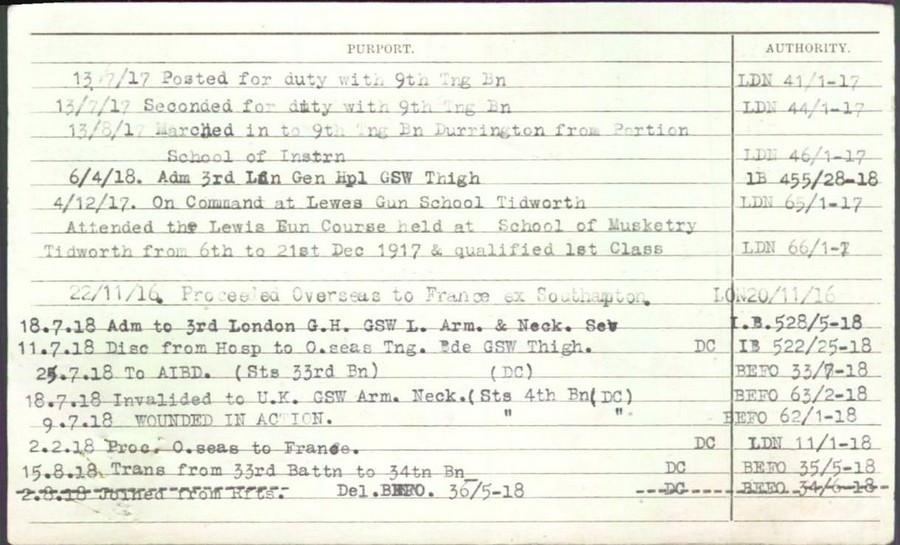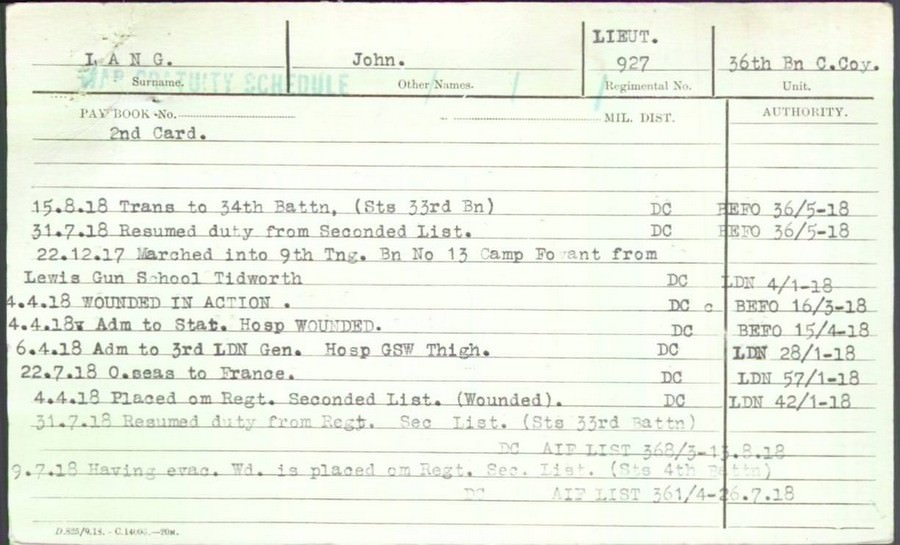
33rd BATTALION AIF
Lance Corporal: 736 Hector William CLARKE. M.M.
Born: 23rd August 1897. Glen Innes, New South Wales, Australia. Birth Cert:
Married: 2nd April 1930. Warialda, New South Wales, Australia.
Wife: Catherine Elizabeth Clarke. nee: Conway. (1908-1978)
Died: 4th December 1944. Toowoomba, Queensland, Australia.
Father: Andrew Clarke. (1866-1946)
Mother: Katherine Mary Clarke. nee: Sinclair. (1870-1946)
INFORMATION
Hector William Clarke enlisted with the AIF at Warialda, N.S.W. on the 13th January 1916 and was marched to Armidale where he en trained to the Rutherford Army Camp on the 14th February.

Rutherford Army Camp 1916
The 33rd Battalion became a part of the 9th Brigade of the 3rd Australian Division. The Battalion left Sydney on the 4th May 1916 bound for the United Kingdom aboard the H.M.A.T. A47 "Marathon".
 A SOUVENIR OF H.M.A.T. MARATHON. THE NORTHERN BATTALION'S TROOPSHIP.
A SOUVENIR OF H.M.A.T. MARATHON. THE NORTHERN BATTALION'S TROOPSHIP.
Mrs. C. Unverhau, of "Glenwood" Uralla, forwards us a souvenir of the Marathon's voyage, which she has just received from her son, Private: 1270 Harold Hayman UNVERHAU who is a member of the Northern Battalion. The title page contains a photograph of the ship and a statement of the troops on board. The rest of the letterpress is as follows: Perhaps one of the prettiest, and most affecting sights in the world is an Australian ship's good-bye, especially if the vessel be a transport. The devotion of relatives and friends is amazing. Besides undergoing the discomfort and inconvenience of a long journey to the port of embarkation, they also cheerfully endure the tedium of uncertainty and waiting about incidental to the dispatch of' troops. In this case the anxiety of attachment, saw some taking up a position of advantage a day previous.
Friends assemble on the quay with rolls of colored paper ribbons, one end of which is thrown to the departing one on board and the other retained by a friend ashore. As the vessel moves away; the rolls are unwound till hundreds of bright-hued streamers are suspended like a fairy-chain between the ship and shore till the whole length runs out or snaps asunder through strain. The "Marathon's" departure was particularly auspicious. Every soldier on the ship and every person ashore seemed connected by a rainbow. A thousand strands, irradiated in the morning sun. Not content with that, motor launches filled with well-wishers must needs follow her up some distance when under weigh. Within an hour of sailing the stormy winds were blowing and the ship—one of the most steady and reliable that ever left the docks—a-tossing. Sea legs and sea stomachs would have fetched any price. Misled by the alert appearance and uniform, unfortunately no one had anticipated ,the demand. The disappearing lights of Bondi synchronized with the dwindling spirits of the 33rd, now at a very low ebb indeed.
It was, nobody's fault that the voyage was a little tedious through being unduly long, accentuated a good deal by intermittent bad weather. To enumerate a few is to commence a really long list. Besides the daily parades for drill, etc., when the weather held fine, there were boxing bouts and sports, relieved by band performances and deck concerts . Some of the days, with calm sea and warm, radiant sunshine, were wholly delightful ; while cool moonlight evenings provided ideal conditions for pianofortes and vocal selections. Ports of call, too, gave opportunity to enlarge experience and profit by observation, though in several instances it was a case of distance lending enchantment to the view— one cannot see much on the deck of a steamer half a mile from an object on shore, which strangeness, of course, only heightens interest and foments desire to approach closer. Yet despite all drawbacks every man on the ship got the benefit of a passing acquaintanceship with towns and countries other than his own—a direct contrast, say, in comparing Central Africa with the Commonwealth or, to come nearer home, Western with Eastern Australia, and again his own with the Colony of South Africa.
Arriving in England in early July, the Battalion spent the next four months in training before departed from Southampton, England on the 21st November 1916 at 4:30 pm and traveled by paddle steamer ‘Mona Queen’ to France arriving November 22, 1916 at 7:00 am in Le Havre. The Battalion moved in to the No:1 Rest Camp just in time for the onset of the terrible winter of 1916-17.
 S.S. "MONA QUEEN"
S.S. "MONA QUEEN"
Hector went into the lines with the 33rd
9th April 1917.
On the 9th the 33rd once again took over the front line, again at L'Epinette. They moved to Senninghem on the 12th where they were headquartered until the 25th. Then once again they were on the march, via Renescure and Pradelle to Armentieres, Where, on the 28th they gained a well earned rest. On the 21st May the men of the 33rd were moved to Le Touquet to Ploegsteert Wood for the usual working parties, trench maintenance being high on the agenda for the coming offensive. Three days later they were at St Vyes for more of the same, relieved on the 26th May by the 34th Battalion and moved back to billets at Nippe.
(Never a Backward Step; Edwards 1996)
9th May 1917.
Informant; Lieutenant: 1205 William Alexander McLEAN. At 1:00 am I reached the bombing post and the left of "D" Gap. We were observing down the gap and saw movement 70 yards down the gap. We then saw three crouching figures with round caps making for our support line. I ordered the men to get there rifles and bombs ready and told them to fire. The three Germans dropped flat. Private: 5043 Albert Francis LANE of his own accord jumped out of the bay and got to a point 15 yards down the gap and commenced to throw bombs. The Lewis Guns then commenced to fire at the place where the men had been seen. We then saw 25 Germans making back to their own line. The Lewis Guns then fired three separate bursts at them and we saw at least 6 Germans fall, in NO MAN'S LAND 70 yards from our own front line. The Lewis Guns continued firing and were sweeping perfectly. We then saw a German limping 30 yards from our own trench; the Lewis Gun was turned on him and he fell.
Three men and myself went out immediately and found a German sitting in a shell hole. We brought him in although he was screaming with pain. The stretcher bearers were sent for and the German was taken to Company Headquarters, then to the Aid Post. Our party threw 24 bombs and fired 50 rounds from their rifles. The Lewis Gunners fired 10 magazines. The Germans made their entrance by means of the old trench which runs from our lines through NO MAN'S LAND. From the point where Private: 5043 Albert Francis LANE threw bombs the gap is heavily wired and we could make no progress to attack them. The Germans also left in a diagonal direction so it was impossible to get in NO MAN'S LAND and cut them off.
Officer of the Watch.
LE TOUQUET 1:00 am. Enemy silently raided our trenches and were driven off with Lewis Gun fire and bombs leaving 1 prisoner in our hands. Trench maintenance and repairs were carried out over the next 4 days.
33rd Battalion Unit Diary
7th June 1917.
THE BATTLE OF MESSINES
The 3rd Australian Divisions first major offensive was at Messines Ridge on the 7th June 1917. The Australian 3rd Division was a part of the II Anzac Corps which was allotted to the first assault. The 25th New Zealand, 3rd Australian Division with the 4th Australian Division in reserve. The 4th Division were battle hardened troops who had fought many major battles. The 3rd Australian Division were having problems getting to the "jump off" point. The day before the 9th and 10th Infantry Brigades were bombarded by German Gas-Shells around Hill 63 and Ploegsteert Wood. Many of the Aussies were not wearing gas masks, but despite this they pressed on even though they received 500 casualties.
They made it to the "jump off" point but only just with some of the men from the 9th and 10th going straight over the top without stopping. The mines went up and the attack commenced behind a protective barrage. The II Anzac Corps were attacking on the right with their objective being the southern shoulder of the ridge which included Messines, the Dover and St Yves areas as far south to the east of Ploegsteert Wood.
Major General Sir John MONASH's 3rd Division had to contend with a tricky 3 mile approach out of Ploegsteert Wood and after the German gas attack, but they were not deterred. The 9th Infantry Brigade under Brigadier General: Alexander JOBSON and the 10th Infantry Brigade under Brigadier General W R NICHOLL had just made the jumping off point but some of the men did not stop, going straight into the assault from the approach march.
Their objective lay between St Yves and the Douve. The mines at Trench 127 and Trench 12 at Factory Farm were laid to aid this task. The explosions erupted a few seconds before zero hour and created craters of 200 feet in diameter, completely obliterating the German defence line as the 9th and 10th Infantry Brigades went over the top. The mine crates forced the 9th and 10th Brigades to veer to the left and right which caused some confusion with the main assault. It is testimony to the quality of training that every man knew the ground, tasks and objectives so well.
Private: 1804 John CARROLL 33rd Battalion, rushed the enemy's trench and bayoneted four of the German occupants. He then noticed a comrade in difficulties and went to his assistance, killing another German. He then attacked single handed a German Machine Gun Team, killing all three of them and capturing the gun. He later rescued two of his comrades who had been buried alive by German Shell Fire, and in spite of heavy shelling and machine gun fire he dug them out alive and saved them from certain death. John was awarded the Victoria Cross.
The German forward zone was completely engulfed and taken by the main assault. The two supporting battalions of each brigade then passed the leading battalion to continue the advance. The men were constantly re-supplied and the ridge was taken. There were many German prisoners taken during the offensive. The 3rd Division was well ahead with the 9th Infantry Brigade pushing on beyond Grey Farm, and on the right the 10th Infantry Brigade were veering left towards Septieme Barn north of Douve.
The German resistance was heavy but was generally brushed aside by tanks and artillery before the infantry had to become too involved. The 4th Bavarian Divisions Artillery had made little impact, but as the day wore on the 3rd Division and later the 4th Australian Division received many casualties from German artillery. (70% of all casualties during WW1 were from artillery).
By 9:00am nearly 6 hours after the assault began the Germans were in disarray, but there was a major problem as the Australians received less casualties as anticipated and when ordered to dig into the ridge they had so many men, that some could not find shelter. the 35th battalion were dug in around Seaforth Farm.
The second phase of the operation was to take the Oosttaverne Line. The 3rd Australian Division would now be in reserve with the 4th Division attacking. The 9th Infantry Brigade (33-34-35-36Bn) were near Thatched Cottage facing Warneton. The river Lys was to their right and the Ploegsteert Wood was now behind them.
Once their objectives were taken the troops consolidated. A barrage to stop and counter attack was shortened and caught three battalions which had to retire. By 9:00 pm this part of the Oosttaverne Line was abandoned. At 10:45 pm General: Alexander John GODLEY ordered the 3rd and 4th Divisions to retake it. This they did by the early hours of the 8th of June.
The Battle for Messines Ridge during May-June 1917 saw 35 officers and 1,631 other ranks loose their lives.
9th Infantry Brigade Casualties.
| 33rd Battalion. AIF |
8 Officers |
382 Other ranks |
| 34th Battalion. AIF |
10 Officers |
378 Other ranks |
| 35th Battalion. AIF |
5 Officers |
431 Other ranks |
| 36th Battalion. AIF |
9 Officers |
421 Other ranks |
| 9th Machine Gun Company. AIF |
2 Officer |
17 Other ranks |
| 9th Light Trench Mortar Battery. |
1 Officer |
2 Other ranks |

FIELD DRESSING STATION, MESSINES 7th June 1917. 12th June 1917
Nueve Eglise was the billeting area for the battle-weary remnants of the 33rd Battalion, when finally they were relieved from Messines on June 12th 1917. After 2 short days of rest they were again marched to new billets at Douleu, where they stayed for the next ten days. By then Command must have considered them sufficiently rested for they were ordered back into the front line, to relieve the 10th Cheshire Battalion on June 23rd.
(Never a Backward Step; Edwards 1996)
Military Medal was awarded to Private: Private Donald Cranston MURRAY 33rd Battalion on the 28th June 1917.
12th July 1917.
MESSINES Relieved 41st Battalion in Sector u.11.b to u-5-b as per Bn 0.0.47 d/9/7/17 and Intelligence summary d/127/17. Enemy Shelled road south of MESSINES and caught tail of relief Killing two. Two men killed and others wounded. Trenches found to be in very bad condition. They had been very badly sited no attention having been paid to conformation of ground. The first principles of trench siding had not been observed and no attention paid to drainage. Communication trenches were straight, shallow and through not having been duck boarded when dug had become quite impassable in places an account of mud. Front Line had rifle on us field of fire and both it and the Support line were crude observation from WARNETON from whence they were directly exploded in places.
(33rd Battalion War Diary)
12th October 1917
THE BATTLE OF PASSCHENDAELE I
At 1:30 am rain showers began. By 2:30 am it was raining lightly but steadily, by 3:30 fairly heavily. the infantry moved through the pitch dark in single file. In some battalions each man held on to the equipment of the man ahead of him; if touch was broken, those in front had to come back. The news that the line as reported by the 66th division was not held only just reached the incoming troops. Accordingly, in the right brigade (9th) the leading Company Commanders Captain: Clarence Smith JEFFRIES. V.C. and Captain: Telford Graham GILDER M.C. both of the 34th Battalion stopped their men at the entrance to Broodseinde railway cutting, and themselves went to make sure that their column might not run into the enemy.
At Keerselaarhoek Cemetery they found the tape duly laid, and met the officer of the 36th Battalion who had laid it, and by 3:00 am the time set, the 34th battalion was extended on its jumping-off position. But during the previous halt and afterwards, as it lay on the tape, the battalion was persistently shelled and suffered many casualties.
The first shell killed three signallers. Lieutenant: Albert Leslie WATSON. a signal officer of the 34th Battalion, a brave and enterprising leader who also was at the head of the column was severely wounded and all his staff hit. After establishing a forward command post Lieutenant: Thomas Fraser BRUCE 36th Battalion was also killed. Lieutenant Colonel: John Alexander MILNE. 36th Battalion supervising the assembly was knocked down by a shell but continued to command. Captain, Chaplain: Charles MURPHY was also wounded.
(BEAN; History of World war 1 Vol IV p911) Charles Edwin Woodrow BEAN
Only one Australian Division, the 3rd, was wholly employed in the days offensive. but the division was to capture Passchendaele an in spite of the depressing conditions, it was eager to achieve the distinction of doing so. One unit carried the Australian flag,to be planted in Passchendaele, and although officers and men in general were not enthusiastic concerning such "stunts" the Commander-in-Chief had been informed, and had told General: MONASH that, when this flag was planted, the news would be immediately cabled to Australia.
Some keen spirits looked on the operation simply as a dash for Passchendaele. One young company commander of Monash's reserve battalion, the 33rd, in face of a strict prohibition, led on his company as soon as the barrage fell. Starting from a line 350 yards in rear of the general alignment, the 3rd Division was out of touch with its neighbours from the outset. The heavy shelling on the tapes had made orderly disposition there almost impossible, as German Machine-Guns, undisturbed by the barrage now opened immediately, no opportunity offered of restoring proper formation.
The 9th Brigade went forward in the utmost confusion and a terrible mix up as reported by Captain: Robert Derwent DIXON D.S.O 35th Battalion at 6:40 am and "Great Confusion" was the description given by Captain: Henry Vince CARR 35th Battalion. Even on the ridge, the mud was difficult, the hope, if there ever was one, of catching up before the quick barrage finished.
The 9th Infantry Brigade's intendered direction lay not along the ridge and the Passchendeale road, but diagonally across them, and parallel to the railway, which most of the brigade could not see. As the jumping-off line was practically at right angles to the ridge, the brigade tendered to advance alone the heights. The Machine-Gun fire at the start came, on the 9th Brigade's right, from the ruined house near Defy Crossing; on its centre from, "Hillside Farm"; and on its left from Augustus Wood.
The pillbox opposite the centre was supported from the rear by a trench in which were Germans with Machine-Guns, and here occurred a delay which threatened to wreck to whole attack. it was not until an hour after the programme time that these places were rushed by the neighbouring portion of the line under Captain: Henry Vince CARR and Captain: Robert Derwent DIXON. D.S.O of the 35th Battalion. The trench contained 35 Germans and 4 Machine-Guns. Part of the line was also held up by a pillbox close to Passchendaele road near the highest point of the ridge.
Here there was practically no shelter from attack, but Captain Clarence Smith JEFFRIES. V.C. of the 34th Battalion managed to organise a party, with Sergeant: 21 James BRUCE and another N.C.O Corporal: 2036 Vere Cummings STEVENSON and a dozen men, and outflanking it, charged the place from the rear, capturing 25 Germans and 2 Machine-Guns. These actions set free the advance. The pillbox captured by Captain Clarence Smith JEFFRIES. V.C. being not far short of the first objective, the 34th Battalion dug in there.
Great loss had been uncured; the 34th Battalion had only three officers left and there were wide gaps in the line. The right flank had swung far away from the railway, along which the 4th Division was attacking, but on the left Captain: Telford Graham GILDER M.C. of the 34th Battalion who had been wounded by a Machine-Gun bullet, but was carrying on found the 10th Brigade digging in slightly to his left under Captain: LATCHFORD, 38th Battalion, and fell back seventy yards to join it.
The Advance to the second objective was to begin at 8:25, the low clouds had opened, and fleecy cirrus with patches of blue were widening overhead and the sun had come out. The 9th Brigade had been so late in reaching the first objective that, while most of the 34th Battalion dug in, the 35th Battalion, allotted for the second phase, moved straight on. Standing on the Passchendaele road, Captain: Henry Vince CARR and Captain: Robert Derwent DIXON. D.S.O of the 35th Battalion endevoured to decide where the barrage then was; at first Carr thought it may be behind them, but finally decided that it was ahead.
The confusion at the start had split the brigade into mixed parties of all battalions and many of the 34th went on with the 35th, the main body of which, about 100 in all, now advanced along the south-eastern side of the ridge in order to catch the barrage. The hour was probably a little before that for the second advance. A German Machine-Gun in the gap between the brigade's right and the railway immediately opened with deadly effect.
Major: John Bruce BUCHANAN 36th Battalion, the senior forward officer was killed. At this critical juncture Captain: Clarence Smith JEFFRIES. V.C. of the 34th Battalion, again accompanied by Sergeant: 21 James BRUCE, led out a few men from the first objective and made for the gun. it was shooting in short bursts, and he was able to work up fairly close. Seizing a moment when it was firing to the north, he and his men rushed at it from the west. It was switched round, killing him, and sending his men to the ground.
But when its fire eased they worked round it, rushed the position, seized 25 Germans and 2 Machine-Guns. This gallant and effective action Captain: Clarence Smith JEFFRIES. V.C. was posthumously awarded the Victoria Cross for removing the chief danger to the advance along the crest, but as soon as the 35th Battalion crossed to the eastern side of the hill it became the target of a number of field and heavy guns which, from the hedges and other cover in various parts of the landscape, fired over open sights.
After passing a corpse on its right, the 35th Battalion settled down on what its officers took to be the second objective, although on the extreme right they were actually short of the first. Captain: Henry Vince CARR, now the senior officer on the spot, reported; 8:35. On objective, with about 100 Captain: Robert Derwent DIXON. DSO and three officers. Casualties 25 or 30 per cent. Captain: Henry Charles Dight CADELL M.C Lieutenant: Charles Teesdale MAIN Lieutenant: Keith Maitland DAY reported killed and Lieutenant: Frank HORNE Lieutenant: Christopher Kyffin MEARS Lieutenant: Charles John HENRY were wounded. Prisoners sent back 400-500. Contact on flanks uncertain, being heavily shelled.
Three posts were established under surviving officers, right Lieutenant: Norman Beade D'ARCY M.C centre Lieutenant: Joseph Francis ADAMS left Lieutenant: Harold Sydney WYNDHAM. In this brigade the battalion for the final objective was the 36th, and a report came along that it had gone through. Actually, it had advanced with the 35th, but, on the left, penetrated to the second objective, which bad been reconnoitered during the previous halt by the commander of the company Captain Robert Austin GOLDRICK. M.C.
He went up the road towards Passchendaele. The barrage, he said afterwards was no hindrance to him, although he left the line lying as close to it as possible "or where he thought it was." He was unable to detect the intensification of the barrage for the second phase, but led his men forward at the proper hour.
As no other battalion was there, he now established the line with its left on the road 600 yards from the church, about the point reached by the 66th Division's troops on October 9th. In front of the position Captain: Robert Austin GOLDRICK. M.C. and Lieutenant E.H FLEITER (39th Battalion) found hidden in a shell hole men of the 66th Division. One had a broken arm, the other trench-feet. They took the Australians at first for Germans. When reassured,"we knew the Australians would come," they said, 'We prayed hard."
From the direction of the church, which lay straight down the highway, no fire came. two Germans ran up the road and surrendered. South-east of the village, along the Moorslede road, were the Germans who seemed "very windy," and near the road two 5.9-inch howitzers began to blaze at the troops digging in.
The 9th Brigade had taken its second objective and the 10th its first, but the position of the officers in charge of these advanced lines was full of anxiety. On the eastern slope Captain: Henry Vince CARR 35th Battalion, the senior officer in this part of the 9th Brigade's front, could see the 4th Division somewhat ahead of its right, and by 10:55 he had discovered that the 36th was on the left, but farther left than the 10th Brigade was far behind on its first objective . The German Guns ahead were sniping with dreadful accuracy. Carr on the western slope, sent back for instructions: "what am I to do?"
Word of the true situation reached headquarters slowly. As on the 9th, the first news was all encouraging. General: MONASH in the Ypres ramparts heard shortly after 7 that both brigades were "well away"; but by 8:26 he had ample evidence that the first objective was taken. At 9:25 the intelligence officer examining prisoners (Lieutenant: Frederick Morley CUTLACK Official War Correspondent) reported having heard from the wounded men that the second objective had been reached.
At 10:28 headquarters was informed of a statement of a wounded man, that the 38th Battalion had gone through. A further report that Australians had been seen at Crest Farm although quickly contradicting but probably true nevertheless. Which confirmed Monash's impression that his division was succeeding. Concerning the New Zealand brigade on his left, however, there was no word until, at 10:50, there arrived the tragic information that the New Zealand Division was stopped by the enemy alone the entire front.
Monash has already heard at 9:55 that the 10th Brigade was held up by fire from Bellevue Spur. Believing that his division was still advancing, he asked that every gun that the New Zealand Division could spare should be turned upon that ridge to suppress the fire. Meanwhile, he would order the reserve (39th) battalion of the 10th Brigade to be ready to assist in holding the ground already won. The reserve battalion the (33rd) of the 9th Brigade he was still keeping back to assist in the capture of Passchendaele.
Shortly after noon news of the true situation arrived. Lieutenant Jackson of the 40th Battalion had established at Waterfields pillbox near the Ravebeek a forward report-centre from which a series of messages, admirably accurate, was flashed by lamp to the headquarters of Lieutenant Colonel Lord of the 40th Battalion. Thus Brigadier General McNicoll of the 10th Brigade was able to inform Monash of the precise position of Giblin's Line. He added that the situation was very serious and the casualties very heave. At the same time from the front line of the 9th Brigade arrived a pigeon message, sent by Captain: Richard GADD of the 36th Battalion.
We are on the Blue Line (second objective) with composite force all three battalions, both flanks in the air.
The New Zealand Division was to make a second attempt at 3:00 pm, and Monash was of the opinion that from the 9th Brigade, well forward on the ridge, patrols might still work northward around Crest Farm. His reserve, the 33rd Battalion (9th Brigade), was accordingly ordered to attempt this at 4:30 pm and the 10th Brigade's forward line being meanwhile reinforced by its own reserve, the 39th Battalion.
These orders went out, but none of them were fulfilled. The New Zealand Division had been defeated by obstacles which no hastily renewed bombardment could have overcome. no infantry in the world could have crossed the Ravebeek mud, penetrated the dense wire, and attacked the crowded pillboxes of Bellview with the assistance of a barrage which did not even screen the advance. No blame can attach to the artillery. Its commander, according to the New Zealand official history, had reported on the previous day that his guns might be unable to give efficient support.
This magnificent division, which lost nearly 3,000 men, had been held up in almost exactly the same position as the 49th three days before-the left brigade penetrating half-way to the first objective, the right stopped almost at the start.The Germans were reinforcing. The New Zealand battalion commanders knew that their men had no chance of succeeding by renewed attack, and the order was eventually cancelled.
As for the Australians, of the two battalions that MONASH had now ordered to participate, the 39th had already to a large extent been involved in the fighting, and the 33rd, endevouring to reach its position of readiness for outflanking Passchendaele,had suffered great loss. No less than 6 of its Officers were killed or mortally wounded. Captain: Wilfred Frank HINTON in command of the forward company, Lieutenant Leonard Rockley BROWNLOW Lieutenant: Thomas Acheson ARMSTRONG Lieutenant: Albert George KILPATRICK Lieutenant William REES-REYNOLDS and Lieutenant: Norman Francis GOBLE.
By the time Lieutenant Colonels Henderson DSO 39th Battalion and MORSHEAD attempted to carry Monash's orders, they found that the attacking force of both brigades was back almost at its starting point. What had happened was as follows.
Neither Major: GIBLIN near the Ravenbeek nor Captain: Henry Vince CARR on the ridge had received their messages sent several hours earlier. The 9th Brigade's line was still being battered by the German Guns. Captain: Richard GADD 36th Battalion, whose troops were being wiped out, informed Captain: Henry Vince CARR 35th Battalion that Lieutenant Colonel: John Alexander MILNE D.S.O 36th Battalion had now come forward to Hillside Farm. CARR accordingly sent Captain: Robert Derwent DIXON. D.S.O with GADD to explain to Milne the desperate nature of their situation. Milne said that he would try to get their troops relieved after dark, but till relieved they must hold on.
(BEAN; History of Word War 1 Vol IV page 921) Charles Edwin Woodrow BEAN
Meanwhile, however, the German artillery was annihilating some parts of their line. All leaders of Carr's three posts were out of action. Lieutenant: Joseph Francis ADAMS was Killed in Action and Lieutenant: Norman Beade D'ARCY M.C and Lieutenant: Harold Sydney WYNDHAM were wounded. Of the remaining officers of the 36th Battalion, Major: John Bruce BUCHANAN and Lieutenant: Fredrick William PUTNEY had been Killed in Action and Captain: Robert Austin GOLDRICK M.C wounded. Farther back Lieutenant: Sydney COOK had been Killed in Action and Lieutenant: William WAND and Lieutenant: Herbert Reginald MAILER were wounded.
At 3 o'clock rain began to fall steadily. at 3:15 pm Captain: Richard GADD 36th Battalion, thought agreeing with Captain: Henry Vince CARR 35th Battalion that to hold on meant annihilation, refused, in view of his Colonel's orders, to retire. Carr consented to wait while Gadd again sent word to Lieutenant Colonel: John Alexander MILNE D.S.O. Carr himself at 12: 30 had sent Captain Robert Derwent DIXON. D.S.O to the headquarters of the 35th Battalion at " Seine", from which no word had been received all day.
At 3:45 pm, no reply having come from Milne, and Dixon not having returned as he had been kept at 35th Battalion headquarters awaiting the arrival of an order from brigade headquarters concerning the projected operation by the reserve battalion, Gadd agreed to withdraw and Carr sent along the line a note: The 35th Battalion will retire.
When visiting Gadd, Carr had warned the troops of the probable order to withdraw, and he now saw that the left had already begun to retire. He told men whom he passed to get back as fast as they could to the 34th Battalion (which he believed to be on the first objective). Captain: William James GORDON M.C 36th Battalion, strongly dissatisfied with the order, went straight to Lieutenant Colonel: John Alexander MILNE D.S.O urged that the forward position was tenable, and with Milne and Major: John Martin HAWKEY M.C rushed out to stop the withdrawal. But it was too late.
The 34th was not, as Captain: Henry Vince Carr 35th Battalion, believed, on the first objective. The Commander of the line, Captain: John William RICHARDSON 34th Battalion, on hearing of the extreme weakness of the force at the second objective, had reinforced it. He and his only remaining officer's Lieutenant: James Clement BURGES Lieutenant: Bruce Gray McKENZIE Lieutenant: John Abbott LONGWORTH had all been Killed in Action while organising on the first objective, and the first objective now lay empty. The retiring troops, being without orders as to the position to be taken up, streamed back past Milne's headquarters.
All that Hawkey, Gordon, Gadd, and others could then do was to lead a fraction of them forward again to the first objective, where they remained during the night. Captain: Robert Derwent DIXON. D.S.O. with Captain: John Grieve PATERSON adjutant of the 35th, went up to organise the 35th there, but could find none of it's men. When eventually re-formed the remnant of the 35th was temporarily attached as a Company to the 33rd Battalion.
9th-12th October 1917 saw the 3rd Division, 9th and 10th Infantry Brigade in action during the Battle of Passchendaele, which saw massive losses and suffering in the Australian ranks. The casualties numbered 3,199 men in 24 hours during the height battle. The 34th Battalion lost every officer that day, either killed or wounded including their Medical Officer, Major: Gother Robert Carlisle CLARKE and some of his staff were killed while dressing the wounded. The spirit of some of the wounded is illustrated by the case of Corporal: 3170 Winsleigh Alexander MURRAY 35th Battalion, (formerly a Methodist Minister from Newcastle) gave up his place in a queue waiting for stretcher bearers and was never heard of again.
The Battle of Passchendaele saw 60 Officers and 1,322 other ranks loose their lives.
9th Infantry Brigade Casualties.
| 33rd Battalion. AIF |
11 Officers |
273 Other ranks |
| 34th Battalion. AIF |
15 Officers |
323 Other ranks |
| 35th Battalion. AIF |
18 Officers |
296 Other ranks |
| 36th Battalion. AIF |
15 Officers |
383 Other ranks |
| 9th Machine Gun Company. AIF |
1 Officer |
36 Other ranks |
| 9th Light Trench Mortar Battery. |
- Officer |
11 Other ranks |
Hector was Wounded in Action on the 12th October receiving a Gun Shot wound to his Right Shoulder and was treated by the 9th Australian field Ambulance before he was evacuated to the 5th General Hospital at Rouen for further treatment. He was invalided to England on board the Hospital Ship "Grantly Castle" on the 17th October.
Hector was admitted to Hospital for further treatments and upon his discharge marched in the 9th Training Battalion before being sent to the No: 3 Command Depot for overseas deployment .
5th November 1918.
Informant: Lance Corporal: 736 Hector William CLARKE. (C Company 12th Platoon 33rd Battalion AIF) "Private: 880 Robert SUTHERLAND also of (C Company 12th Platoon 33rd Battalion AIF). On the 22nd of August about 9 o'c in morning on Bray Corbie Road. We were digging in after our advance. SUTHERLAND was killed outright by Machine Gun fire, hit in the head and chest. I was along side of him at the time, I was in burial party. He had been a mate of mine for 15 years nick name Bob, came from Ashford, N.S.W. Private: C.J. WESTAWAY of (C Company 12th Platoon 33rd Battalion AIF) was killed alongside him and was buried in a separate grave at the same spot. Personal effects were handed in the Battalion Headquarters".
1st Australian Auxiliary Hospital. Harefield.
Upon his discharge from Hospital, Hector proceeded overseas for France on the 7th February 1918
3rd March 1918.
WARNETON
9:00 am. Weather dull and very cold. Our Artillery fairly active throughout the day, Enemy Artillery quiet. 11:45 am. 9th Infantry Brigade Raiding Party of 300 strong racked enemy trenches opposite 33rd Battalion Sector on our right. Raid very successful 1 Officer 11 other ranks being brought back prisoners. 34th Battalion casualties in the raid were 1 other ranks Killed 3 other ranks Wounded. There was no Artillery retaliation on our Sector.
(34th Battalion War Diary)
MILITARY MEDAL7th March 1918
Private: 736 Hector William CLARKE 33rd Battalion A.I.F. "For gallant service and devotion to duty on night 3rd/4th March 1918 during a raid on enemy trenches in vicinity of WARNETON. This man was wounded and had his rifle broken in NO MAN'S LAND. In falling he also sustained a sprained wrist. In spite of his wounds he was first in the trench, and seeing a rifle he carried out his duties of leading bayonet man to right assaulting party himself killing three enemy. He displayed the greatest bravery and fearlessness.
Inverell Times, Friday 14 June 1918, page 2
AWARDED THE MILITARY MEDAL
PRIVATE HECTOR W. CLARKE.
Lieutenant Colonel L. J. Morshead, Commanding Battalion, A.I.F., writing to Mr. A. Clarke, "Glengary," Coolatai, encloses the following extract from Routine Order No. 456, dated 21st March, 1918, respecting his son,
Private W. H. Clarke: "Under authority delegated to him, the Corps Commander has awarded the Military Medal to Private Hector William Clarke, for gallant service and devotion to duty on nights of 3rd and 4th March, 1918, during a raid on enemy trenches in the vicinity of Warneton. This man was wounded and had his rifle broken in No Man's Land. In falling he also sustained a sprained
wrist. In spite of his wounds he was first in the trench, and seeing a rifle he carried out the duties of leading bayonet man to right assaulting party, himself killing three of the enemy. He displayed the greatest bravery and fearlessness. The Corps, Divisional and Brigade Commanders desire their congratulations to be conveyed to the recipient. The Commanding Officer also desires to congratulate Private Clarke.
30th March 1918.
CACHY Orders were received during the early hours of the morning that the Battalion was to move its position in BOIS D'AQUENNE in order to launch a counter attack if required. Either in the direction of VILLERS BRETONNEUX or CENTELLES. The Battalion moved off to the wood at 10:30 a.m. and arrived safely. Rain came on but Companies were served with a good hot meal during morning, thus keeping the men warm and in good spirits. At 2:15 p.m. the order came that the Battalion was to move up and take the line (as per Operation Orders) The B Teams were to be left behind. The 34th Battalion was to be in reserve. Everybody was bust getting ready for the next half hour and then the Companies were formed up in mass and the C.O. spoke to them. 5 minutes afterwards at 3:14 p.m. the Battalion started off in great spirits for the scene of action.
The Battalion had the support of 4 squadrons of Cavalry who moved up with them, and it was a "Never to Be forgotten" sight to see the long column of infantry with the Cavalry on their right moving up together. Gradually the Cavalry outpaced the infantry and on their arrival at the BOIS D'HANGARD found the British Infantry retiring. They at once dismounted and advanced taking the retiring infantry with them drove the advancing Bosche back and re-established the line thus clearing the unnamed wood east of BOIS D'HANGARD before the infantry came up. In the meantime the Battalion came on in a column of threes (the visibility being bad) and deployed when they got behind BOIS D'HANGARD at 3:50 p.m Here they rested till the attack was launched at 5:00 p.m.
33rd Battalion War Diary
COUNTER ATTACK OPERATION. AFTERNOON AND EVENING MARCH 30TH, 1918.
33RD BATTALION A.I.F
At 10;30 a.m. on March 30th the 33rd Battalion moved from billets in CACHY to a position of readiness on the south Western edge of the BOIS D'AQUENNE. The enemy shelled CACHY from 10 a.m. but we suffered no casualties. At 2;15 p.m I reported to you at the Brigade Report Center at H.33,0,35,40 and received your orders to capture and establish a line from the Copse immediately South of the first c in MARCELCAVE to AUBERCOURT, and to capture AUBERCOURT which was in possession of the enemy. The 33rd would work in conjunction with the 12th Lancers, who were 400 strong, and would have the 34th in support.
The following orders were issued by me verbally to Company Commanders at 2;45 P.M. "B" Company Lieutenant: 5017 John Graham Antill POCKLEY will establish a line from the Oppue just South of the first C in MARCELCAVE to a point 100 yards east of the Crossroads to V.14.b. "A" Company Captain: John Lovelock FRY will establish a line from 100 yards East of the Cross Roads in V.14.b. to V.20.b.20.00. "D" Company Captain: James William SHREEVE. will capture AUBERCOURT and establish a line on the Eastern and Southern sides of the village. As DEMUIN is held by the enemy particular attention is to be paid to the roads loading over to do LUCE from BEMUIN and COUXCELLES. "C" Company Captain: Walter John Clare DUNCAN will be in reserve in the valley South East of the BOIS DE HANGARD and to be ready to capture DEMUIN.
Battalion Headquarters will be the Reserve Company "D" Teams, according to S.S. 156, will not take into action but will be sent to BLANCY TRONVILLE. At 3;10 p.m the Battalion marched under the command of Major: Francis George GRANT. from BOIS D'AQUENNE and moved across country to the West of VILLERS-BRETONNEUX - AUBECOURT road in U.12. This position was reached at 4;35 p.m. At 3;00 p.m I sent forward two patrols from the Platoon of the 9th Corps Cyclists to reconnoiter North and South of the wood East of BOIS DE HANGARD and then as far forward towards AUBERCOURT and MARCELCAVE as possible. I regret to report that the Platoon Commander Lieutenant: Phillip Charles GRATWICKE was killed.
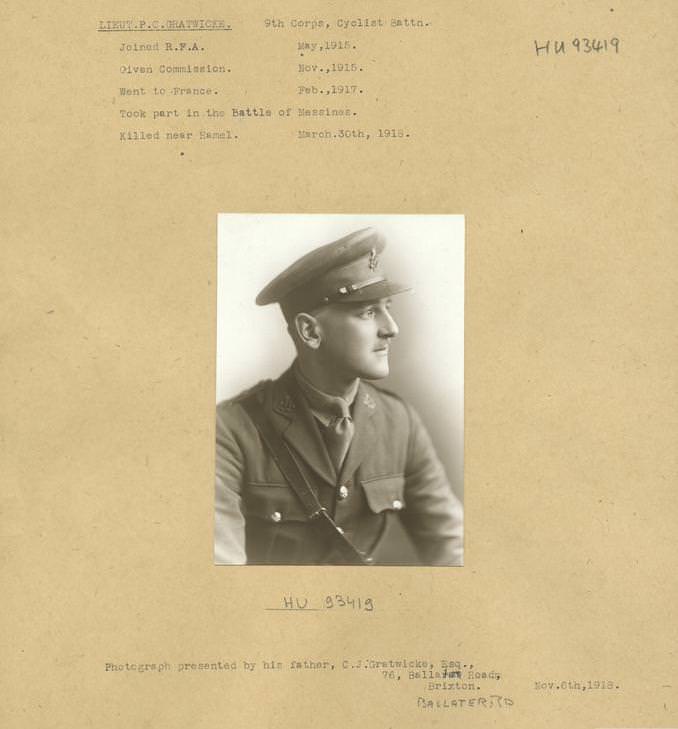
Lieutenant: Phillip Charles GRANTWICKE. 9th Corps, Cyclist Battalion. Killed in Action 30th March 1918.
The 12th Lancers proceeded the Battalion and reached the wood East of BOIS DE HANGARD at about 4;15 p.m.(This wood was in future be referred as LANCERS WOOD) My Adjutant, Scout Officer and Cavalry Liaison Officer went ahead with the Cavalry and reconnoiter the position. On our way to LANCER WOOD we passed several bodies of troops particularly had recklessly entrenched in queer places and large parties of stragglers. On reaching the wood we found the whole front line garrison East of LANCER WOOD withdrawing although there was no hostile fire of any kind and no signs of attack. I met two Brigadiers and a Battalion Commander in the wood and informed them what was happening at once. This they promised to do. The Cavalry Commander also helped in this matter by sending a Squadron dismounted to re-establish the line. The infantry went forward with the cavalry but in a reluctant manner. During the whole time we sore forward men constantly leaving the line. The seemed to be no effort to check this straggling.
It was a proud privilege to be allowed to work with such a fine Regiment as the 12th Lancers. Their approach march instilled in the mementos confidence and enthusiasm and I am glad to say greatly counteracted the effect of so much straggling. They lost no time in effectively clearing LANCERS WOOD and get there just in time as the enemy had obtained a footing on the southern and South Eastern edges. The Lancers protected the edges and allowed us to move forward to the attack. On seeing the cavalry there the enemy shelled LANCER WOOD very heavily, chiefly with 5.0s. paying particular attention to our fringes. Fairly heavy casualties to horses were inflicted there, the horses were soon led from the wood to a position West of the VILLER-BRETONNEUX - AUBERCOURT Road. The discipline during the heavy shelling was a subject lesson. During the attack the cavalry protected both our flanks, the left with two Machine Guns. They withdrew at about 7.00 p.m.
All ranks were eager to give every possible help to us, throughout there was whole hearted cooperation. The experience gained in this our first operation with cavalry was invaluable. One was able too judge of the splendid work they are doing for the Army at this present time and they cannot be too highly praised. The 33rd Battalion moved forward from the position of assembly at 3:00 p.m. The formation adapted by Companies was as follows; One Platoon in extended order, followed by two Platoons in line in Artillery formation; the fourth Platoon in reserve also in Artillery formation.
"B" Company moved along the Northern edge of LANCER WOOD and widened its front on clearing the wood. "A" Company moved throughout the wood. Owing to enemy shelling while moving through, the whole company was extended into three lines and resumed normal formation on clearing the wood. No casualties were sustained in the wood. "B" Company worked in single file along the brindle track near the Southern edge of the wood and formed up under cover of the terraced bank on the South East edge. Three casualties were sustained on entering the wood. "C" Company formed up on the sunken road in U.18.a. and not where was first ordered, owing to the hostile shelling.
The movement forward was splendidly carried out. On the right slight opposition was en counted but easily disposed of. no real opposition was not until we were about 200 yards clear of the wood when all three Companies came very heavy machine gun and rifle fire. They deployed at once and moved forward without flinching. All ranks displayed the greatest determination and eagerness to get to the Bosch with the bayonet, this eagerness was to some extent responsible for the heavy casualties as the principle of advancing under covering fire was not sufficiently observed. On the Left most progress was made in spite of heavy losses, and the enemy hurriedly retired but on discovering later in strength he reformed.

The enemy was well entrenched and in strong force as we had no artillery support his fire was consequently extremely heavy and unfortunately very accurate. Owing to such strong opposition we were not able to reach our objectives. The attached map shows approximately the line we established. The line is well sited and is a very good defensive position. With determined troops the enemy could easily be held, and any advance he attempted would be very expensive. Owing to casualties and to the wide front the Reserve Company to reinforce the right flank. This Company made good the gap between the right and centre Companies. At the same time I requested the 34th Battalion which was in support in U.18.a. and U.12.c. West of the VILLERS-BRETONNEUX - AUBERCOURT Road, to send a Company to reinforce the left flank. I instructed Company Commander Captain: Telford Graham GILDER. to reconnoiter the position first and then move forward at 6.00 p.m. This Company advanced in two lines of two Platoons each and took the newly-made enemy trenches about 250 yards East of the line then held by us, capturing two light machine guns one of which was damaged, and four prisoners belonging to 91st Oldenburg Regiment.
Wilhelm CONZE; Company-Leader in the 91st Infantry-Regiment (03 Apr 1917-14 Oct 1917) Wounded, in Reserve Hospital in Gotha (23 Mar 1918-22 May 1918) Transferred to the Replacement-Battalion of the 91st Infantry-Regiment (22 May 1918-01 Jul 1918) Company-Leader in the 91st Infantry-Regiment (01 Jul 1918-30 Sep 1918) In French Captivity (30 Sep 1918-14 Feb 1920) Released from Captivity and back with the Processing-Office of the 91st Infantry-Regiment (14 Feb 1920-29 Mar 1920)
Captain GILDER withdrew and made good the gap between the left and center Company's. At 10:00 p.m. I requested the C.O. 34th Battalion to send two company's forward, one to the sunken road in U.18.a the other to a position 300 yards North East of LANCER WOOD. At 11:00 p.m. the enemy attempted a local counter attack against my left company but was repelled. Heavy rain fell from early in the afternoon till late at night. Walking over the plowed fields under such conditions affected the Lewis guns and rifles. Every man was drenched to the skin and very cold, but this did not dampen his ardor. All maps were soon rendered useless and the writing of messages was extremely difficult. Our flanks were somewhat in the air, on our left the Warwicks were about 600 yard behind. The 66th Division were on our right, but touch with them was not obtained.
In order to secure my right flank the right Support company, of the 34th Battalion supplied a Platoon for patrolling and also to establish a post South of LANCER WOOD on the VILLERS-BRETONNEUX - AUBERCOURT Road. Our front was well protected by Vickers and Lewis Guns. We had five Vickers guns from the 9th Australian Machine Gun Company - two covered either flank and one the center, and we had 25 Lewis guns. We were relieved by the 10th ESSEX and the ROYAL WEST SURREY Regiment of the 18th Division this morning; the relief Battalion Headquarters were established at V.7.d.30.95. The Pre-arranged position was untonable.
Lieutenant Colonel: Leslie James MORSHEAD.
Commanding 33rd Battalion A.I.F.
4th-5th April 1918
The First VILLERS-BRETONNEUX
The Strength of the 9th Infantry Brigade was about 2,250 but their casualties during the 2 days of fighting numbered 30 Officers and 635 men either killed in action or missing.
9th Infantry Brigade Casualties.4th-5th April 1918
| 33rd Battalion. AIF |
3 Officers |
82 Other ranks |
| 34th Battalion. AIF |
5 Officers |
120 Other ranks |
| 35th Battalion. AIF |
9 Officers |
282 Other ranks (including 44 missing) |
| 36th Battalion. AIF |
12 Officers |
133 Other ranks (including 1 missing) |
| 9th Machine Gun Company. AIF |
1 Officer |
18 Other ranks (including 4 missing) |
Hector was promoted to Lance Corporal on the 1st July to complete the Battalion Strength after Land Corporal SMITH was evacuated.
8th August 1918.
The approach was made in two stages. The 33rd Battalion moved from VIEW SECTOR on the night of August 6th/7th to AUBIGNY and rested there for 24 hours. On the night of August 7th/8th the Battalion passed the starting point at C.3.C.70.20 at 10.20 pm. "A" track was used. The marking of the route was not sufficient, consequently it was picqueted by 30 men, including the band, under an officer. The march was made without incident or interruptions and we suffered no casualties. the head of the column reached the jumping-off line at 1.10 am. The march discipline throughout was excellent.
"A" track was laid to our left flank, consequently a tape line was laid to the center of the Battalion front. "A" and "B" Company's wheeled in single file to the right, and "C" and "D" Company's to the left. As shown in the attached map, the jumping line was in rear of our outpost line in places. There was plenty of room in the front line (BARRABOOL TRENCH) for the whole Battalion to be under cover. The original plan was to remain in this trench until zero minus 5 minutes. But the situation was so quiet that the Companies were able to take up their dispositions in their ordered formation, and so rest in the open.
This assembly was completed at 2.10 am. We had no casualties before zero hour. Lieutenant: 129 Walter Gilligan MASON. (A Company Scout Officer) had charge of laying the tapes and did this work very well. Six direction tapes each 100 yards long were laid, one on each flank of the Battalion and one in the centre of each platoon front. These proved of the greatest value owing to the fog. The 33rd Battalion Scouts relieved those of the 38th Battalion who were holding the sector at 10.00 pm. At 10.30 they encountered an enemy post at P.21.B.30.20; the enemy threw bombs and wounded five of our men. Ten minutes later the 38th Battalion had an Officers patrol in NO MAN'S LAND but no further trace of the enemy could be found.
The Assault at about 4.00 am, as a dense fog arose, so dense was it that it was impossible to see more than 10 feet ahead. The whole artillery opened fire with great precision, and the barrage was very accurate. The fog made it extremely difficult to keep direction and to maintain formation, consequently the advance resolved itself into small parties moving on their own initiative. Only the first of the special ACCROCHE WOOD Signals could be seen, the smoke accentuated the fog. Even the barrage could not be seen.
ACCROCHE WOOD was strongly garrisoned and contained an abnormally large number of machine guns, but the garrison offered no resistance and readily surrendered. The attack was quite unexpected, and the fog was certainly to our advantage. The enemy remained in his dugouts during the bombardment. He gave us very little occasion to use bombs as he readily came forward with his hands extended above his head, one would almost think this was one of his favorite P.T. exercises.
Most of the guns in LONE VALLEY got away they were aided by the fog and all that we could do was to open fire on them. We captured only three guns in this valley, three 4.2's south of RAT WOOD. HAZEL WOOD was captured without difficulty. The GREEN LINE was reached according to schedule and consolidation immediately commenced. On the left protective barrage at 8.20 am when the 4th Division passed through us to the second phase of the attack, this line was re-sited and ran from Q.25.B.40.80; to Q.20.A.40.10; We were in touch with the 35th Battalion on our left and the 18th Battalion who did not occupy their allotted front. The sector was organised into four Company Sub Sectors each with two Platoons in the front line and two in support. Battalion Headquarters were established at P.23.D.50.50; The re-organisation and refitting of the Battalion was carried out without delay.
The barrage was excellent, not a single short being reported. All ranks are most enthusiastic in their appreciation of the exceedingly fine work of our artillery. The movement forward of our batteries to assist in the second phase was splendidly carried out. Special mention too must be made to the good work of the 10th and 9th A.L.T.M. Batteries and the 5th and 6th A.M.T.M. Batteries. One expected to see many more enemy dead in the area, not more than 50 were seen. The enemy's resorting to deep dugouts and his good form in athletics accounted for this.
The enemy's artillery was surprisingly feeble. At no time was his fire effective. When he eventually did learn something of the situation he lost no time in beating a hasty retreat. In the early stages the tanks were no assistance, being behind our troops most of the time. When the visibility allowed the tanks to go forward they did excellent work. Only one tank reached the green line with our troops. When they did get in front they were handled to great advantage. Their effect on the enemy's moral greatly delighted our men. The supply tank formed our dump 300 yards in rear of our line. The value of getting such large supplies forward so early and saving of infantry carrying parties cannot be overestimated.
The work of our machine guns could only be heard. Their fire appeared to be well concentrated and undoubtedly must have been accurate. Only one means of communication was possible, namely runners, and they had very great difficulty in finding their way; On the fog lifting viability and telephonic communication was established. The liaison patrols with the 5th Brigade on our right did not function.
Seven officers, 500 other ranks were captured. This is a conservative estimate and much below the totals submitted by the Companies. 457 can be definitely accounted for these having passed through Battalion Headquarters. 4 x 4.2 Howitzers and 6 x 77 MM Guns. These were captured by Lieutenant: 3072 Frank Albert HUTCHINGS M.C. and party and were marked and tagged. This party worked in the Second Division's area and captured these guns just north of LA MOTTE-en-SANTARRE. On returning in the afternoon to ascertain the number they found, that the guns had been taken away. The remaining there were captured at LENA WOOD. 30 machine guns. Of these 16 have been sent to the HAMELET dump. We have not the numbers of the remaining 14, but the total of 30 is a low estimate. a number of our guns were removed by other units which did not take part in the attack. 1 x Anti-Tank gun. 10 light Minenwerfers, 2 medium minenwerfer, 1 horse, 2 typewriters, large quantity of shells, rifles, equipment, documents and war material.
Casualties 10 Killed in Action, 50 wounded.
(33rd Battalion Unit Diary)
21-22 August 1918.
"Zero Hour, August 21st, at thick fog lay across the front. The allied 3rd Army's Guns were clearly audible to the north. As reports filtered to the waiting Diggers, they learned that the Germans had been surprised, all objectives had been achieved and 2,000 prisoners had been taken. Because of the comparative ease of the victory of that first phase, it was decided to extend the second phase of the objectives. Gellibrand issued orders to continue the assault if the British 47th, on the Australian left flank, were successful and Bray was cleared. Unfortunately these orders, being last-minute, did not arrive at all units.
For the Australians their first active involvement in the action was planned for dawn on the 22nd August, at 4:45 am. Zt 2:20 am the Germans, possibly anticipating an attack, opened up with a barrage of artillery which went for an hour. The 33rd was being held in old trenches near Tallis Wood. It was a bright moonlit night, and officers and scouts laying tapes to mark the jumping off point could plainly see the advancing Battalions 800 yards away. A second enemy barrage fell at 4:00 am. This time the 33rd were caught on the Meaulte-Etinechem Road where they had assembled. The men flattened themselves as shells landed around them on the road., continually showering them with dirt. For some reason a forward German post asked their Gunners to lift their range, to the great relief of the 33rd, but it wasn't such a good move for the 3rd Division Machine Gunners who were formed up in the rear ready to cover the flanks, nor for the reserve 11th Brigade. Both reported casualties from the shelling. The 33rd had been lucky to receive only twenty casualties, the 35th a mere six.
The road, well behind the forward posts, had been chosen as the starting point for the simplicity's sake. These posts were withdrawn just before the opening barrage, which began on schedule. From there the 'creep' was slow, the barrage advancing only a hundred yards in four minutes. A number of phosphorous shells were dropped along the way to form a smoke screen, and this, combined with the dust and early morning mist, cut visibility to only ten yards. The enemy counter barrage was fired within two minutes of the opening, but before the area was taken the Germans had cleared out. The 33rd met with a few enemy Machine-Gun posts in the valley bottom, but these were quickly outflanked and subdued. A forward German Battalion Headquarters, of the 124th Imperial Reserves , was also captured, along with its commander, liaison officers, forty men and four Machine-Guns.
Shortly afterwards our own wounded commenced to arrive at the Dressing Station and the Regimental Medical Officer Captain: William Johnstone BINNS. and staff commenced to get busy. He was assisted by Battalion Pardre Chaplain: 12991 Walter Emra Kingscote BIRKITT who was an old field ambulance man. Lieutenant: 2559 Robert Horner FLETCHER- wounded by an aerial bomb - was the first officer to appear and he was able to give us some idea as how things were going. About this time word was received that Captain: Thomas William TOLLIS of C company and Lieutenant. Alfred Gordon FARLEIGH of B Company had been killed by shots from our own barrage".
(Never a Backward Step; Edwards 1996)
30-31st August 1918
St QUINTEN
On the northern flank the 3rd Division's attack had been arranged at short notice after a day exhausting to both infantry and artillery, and in the face of other particular difficulties. The timing of the attack was to be taken from the left where the 58th Division, somewhat further back than the 9th Brigade, started at 5:10 am behind a very slow barrage to attack Marrieres Wood. The 9th Brigade using the 33rd Battalion, started at the time arranged, 5:40 am, but the artillery had not yet received its orders and though it fired, the barrage was thin and machine-guns in the south-west corner of Road Wood stopped the 33rd.
One Company was late, but Captain: Walter John Clare DUNCAN. M.C. had swung his Company into its place. Major: Cedric Errol Meyer BRODZIAK. D.S.O. was now killed while referring to his map.But within twenty minutes the artillery greatly increased its fire. The 33rd were able to raise their heads. A private Private: 726 George CARTWRIGHT. V.C. stood up and from the shoulder fired at the troublesome German gunner and then walking forward shot him and the two men who took his place.
Next, covering his run by exploding a bomb shot of the trench, he rushed the gun and captured 9 Germans. The 33rd stood up and cheered him, and then advancing by two's and three's entered the wood. Private: 792 William Allan IRWIN. D.C.M an Australian half-caste, after attacking like Cartwright, was mortally wounded and Died of Wounds on the 1st of September 1918.
The 33rd was now considerably behind the 6th London (58th Division), having chased the Germans from Marrieres Wood, was held up by fire from Wary Alley which curved up the gully between the woods. Coming through the south Company Sergeant Major: 967 Louis John MATHIAS. D.C.M & Bar. cleared the Germans by fire from a Lewis Gun.
The 33rd now set to bombing up the old trenches leading up to the upper end of the 1916 Spur where the Peronne-Bapaume Road also ran through. On the nearer side of the road a German battery commander with his gun crews and some infantry was blazing with six field-guns into the Australian groups everywhere they left shelter.
From the southward side Lieutenant: 559 Edward Allen TURNBULL. and Lieutenant: William Alexander McLEAN. M.C. of the 33rd-the latter greatly helped by the leaders of the 10th Brigade Sergeant 1007 E E Walters. D.C.M, 39th Battalion and Corporal 5024 A V GRINTON. D.C.M, 38th Battalion, worked up and presently rushed the guns, the German Battery Commander fighting to the last with his revolver. He was shot by Lieutenant: 559 Edward Allen TURNBULL.
Captain: Walter John Clare DUNCAN. M.C. reaching realised that the old quarry beyond it was a commanding position and accordingly took it and 40 German prisoners and placed a post on its eastern rim. He then went back to Wary Alley, and finding some of the 6th London Regiment, got Captain: S T COOKE M.C, and 20 men to garrison the quarry while the 33rd lined the Bapaume Road on the right.
Hector was Wounded in Action; 2nd occasion receiving a Gun Shot Wound to his Left Shoulder on the 31st August and was evacuated to the 37th Casualty Clearing Station and invalided back to England. He was again admitted to Hospital and upon discharge granted a furlo in London and upon his return he was demobilized for return to Australia 4th January on board the "City of York" and returned to Australia on the 27th February and discharged from the AIF on the 20th April 1919.
Family InformationHector was a single 18 year old Labourer from "Glen Garry" Warialda, N.S.W upon enlistment.
Military Records


































 © Commonwealth of Australia (National Archives of Australia)
© Commonwealth of Australia (National Archives of Australia)
Under Construction: 28/10/2016-28/04/2018.
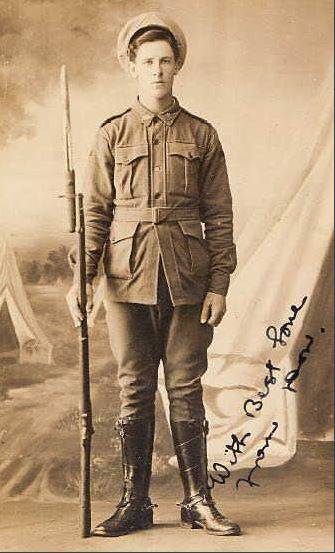
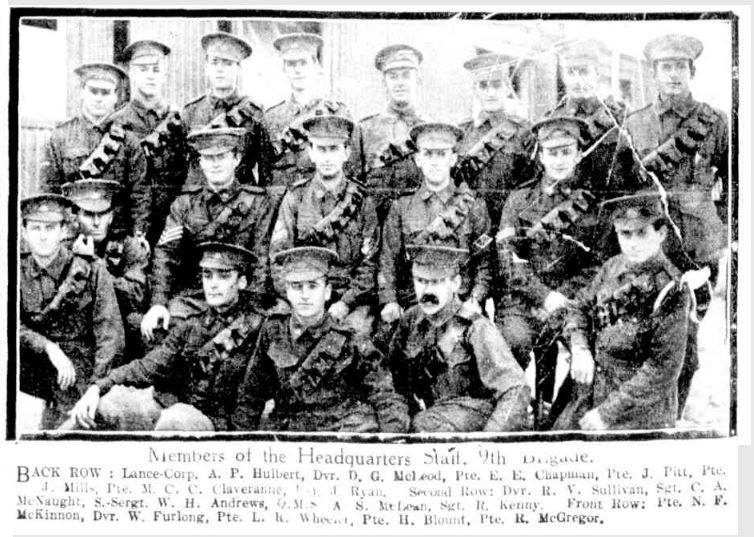


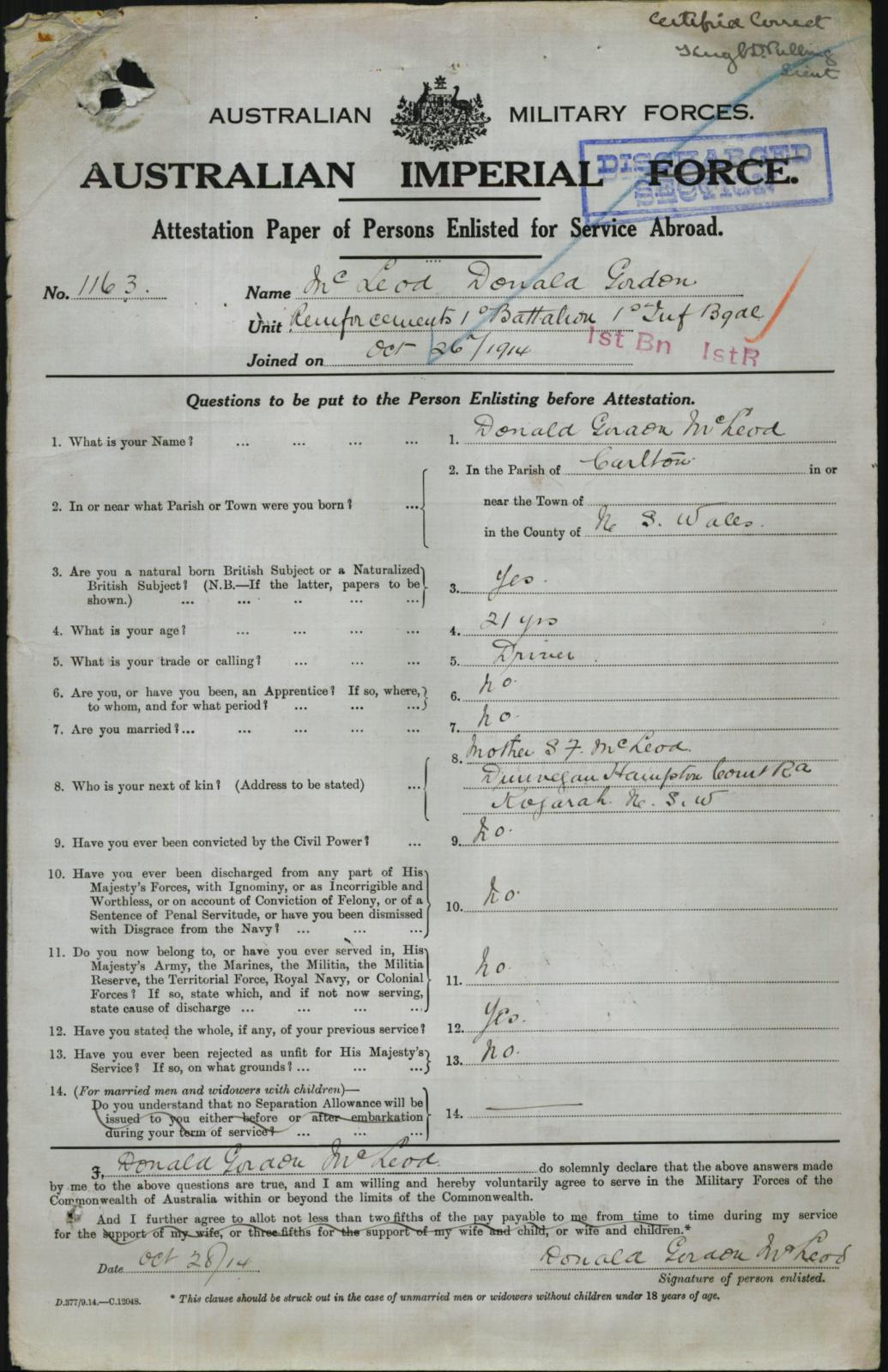

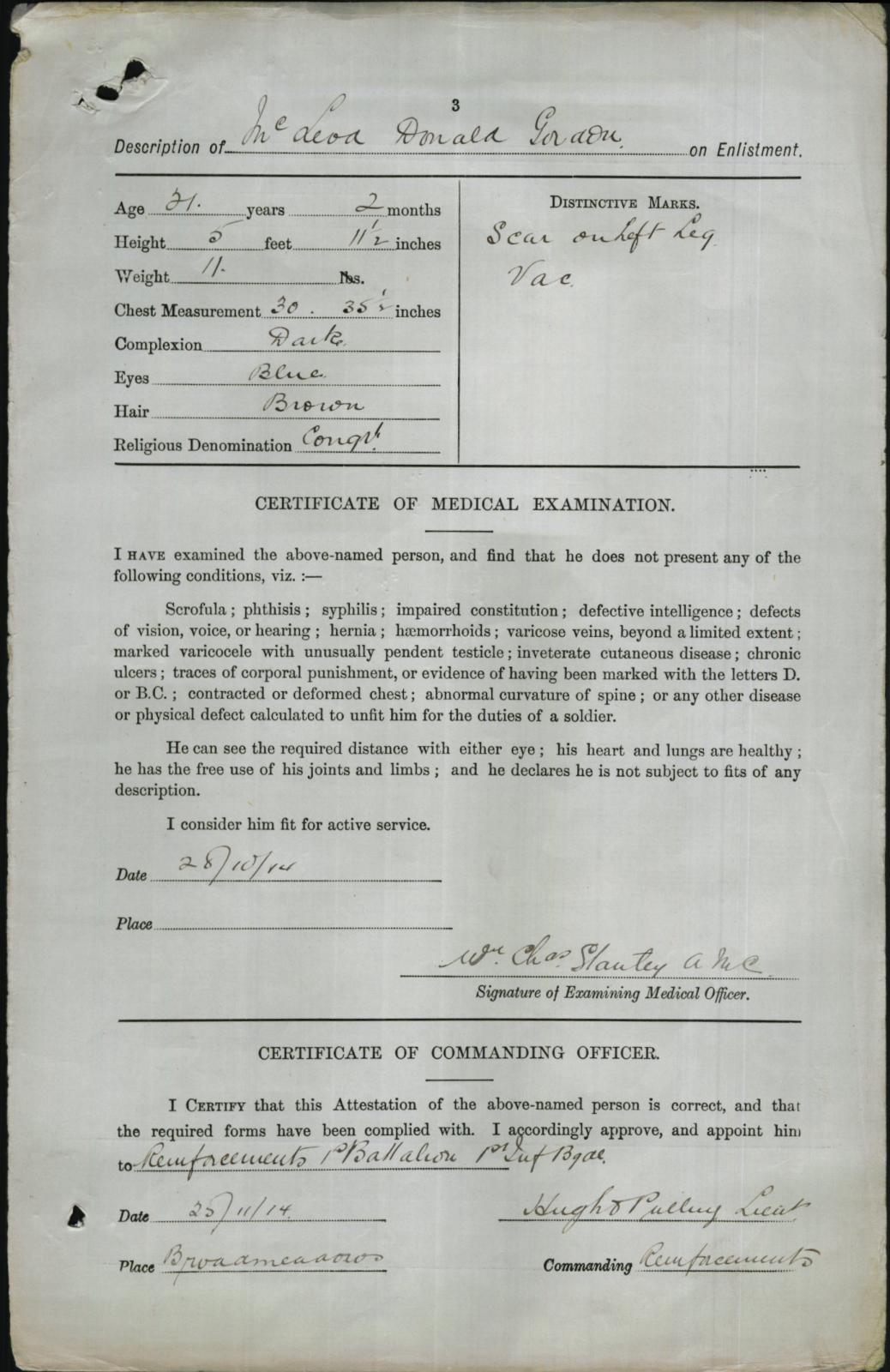
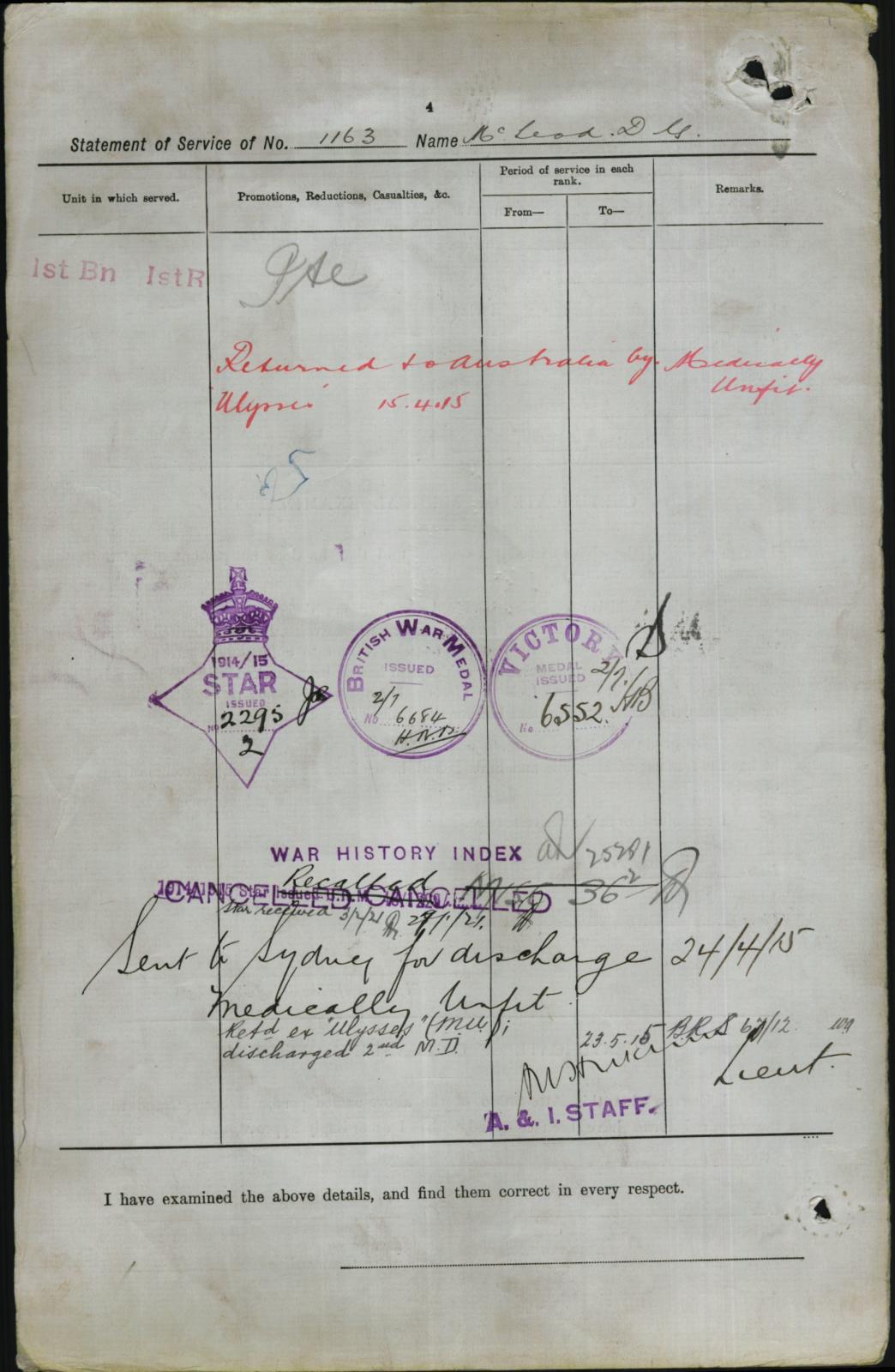
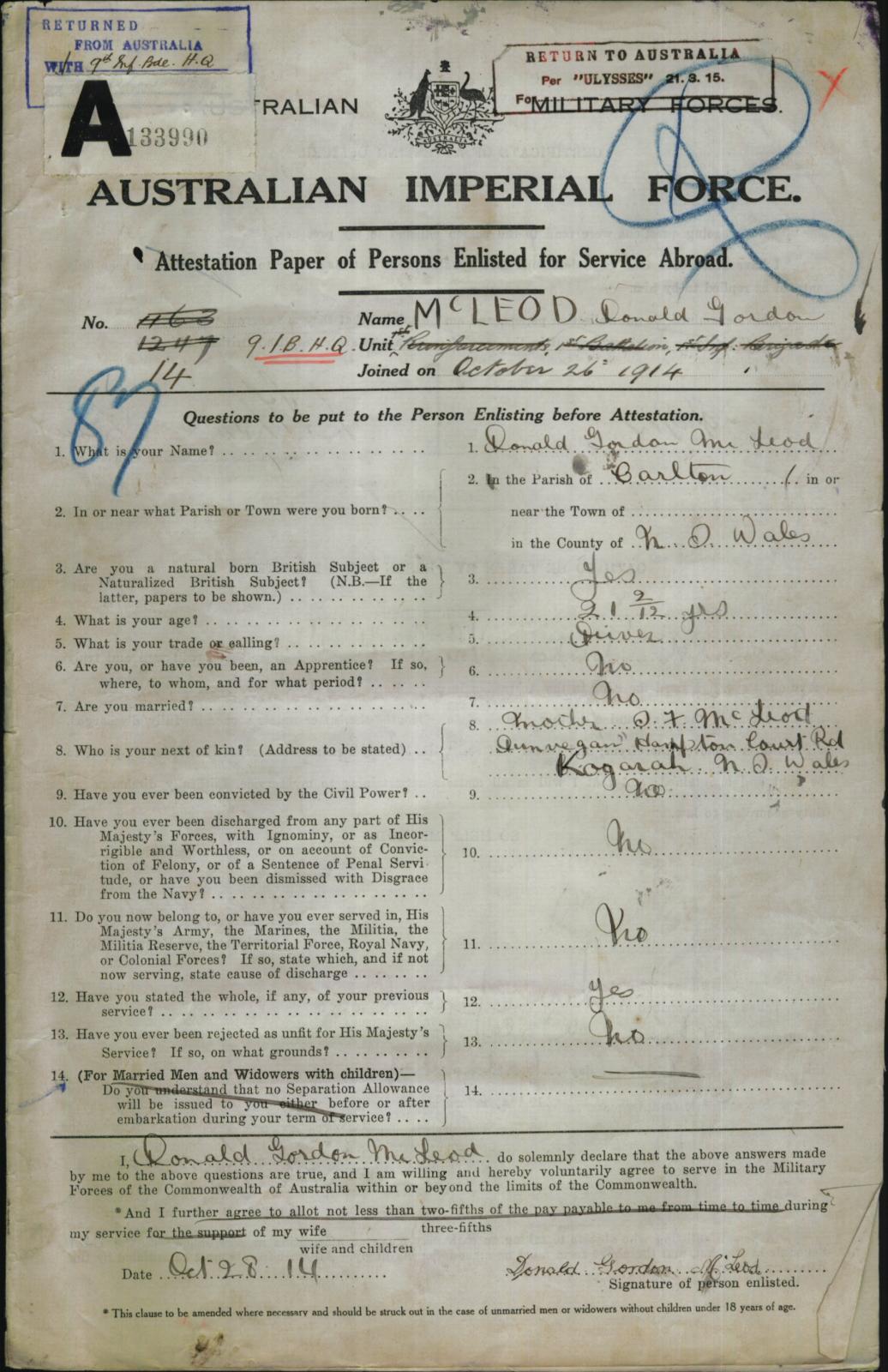
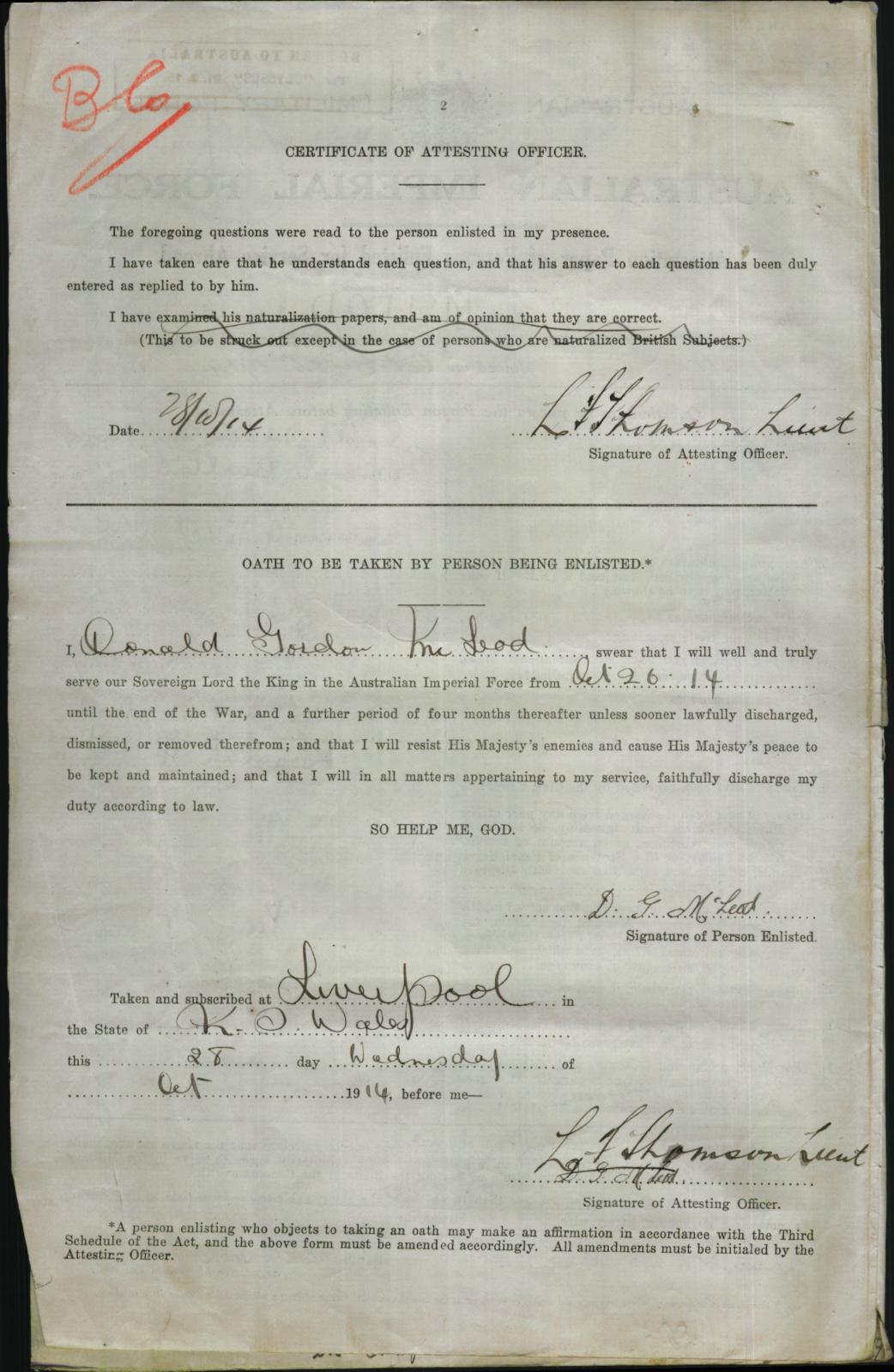
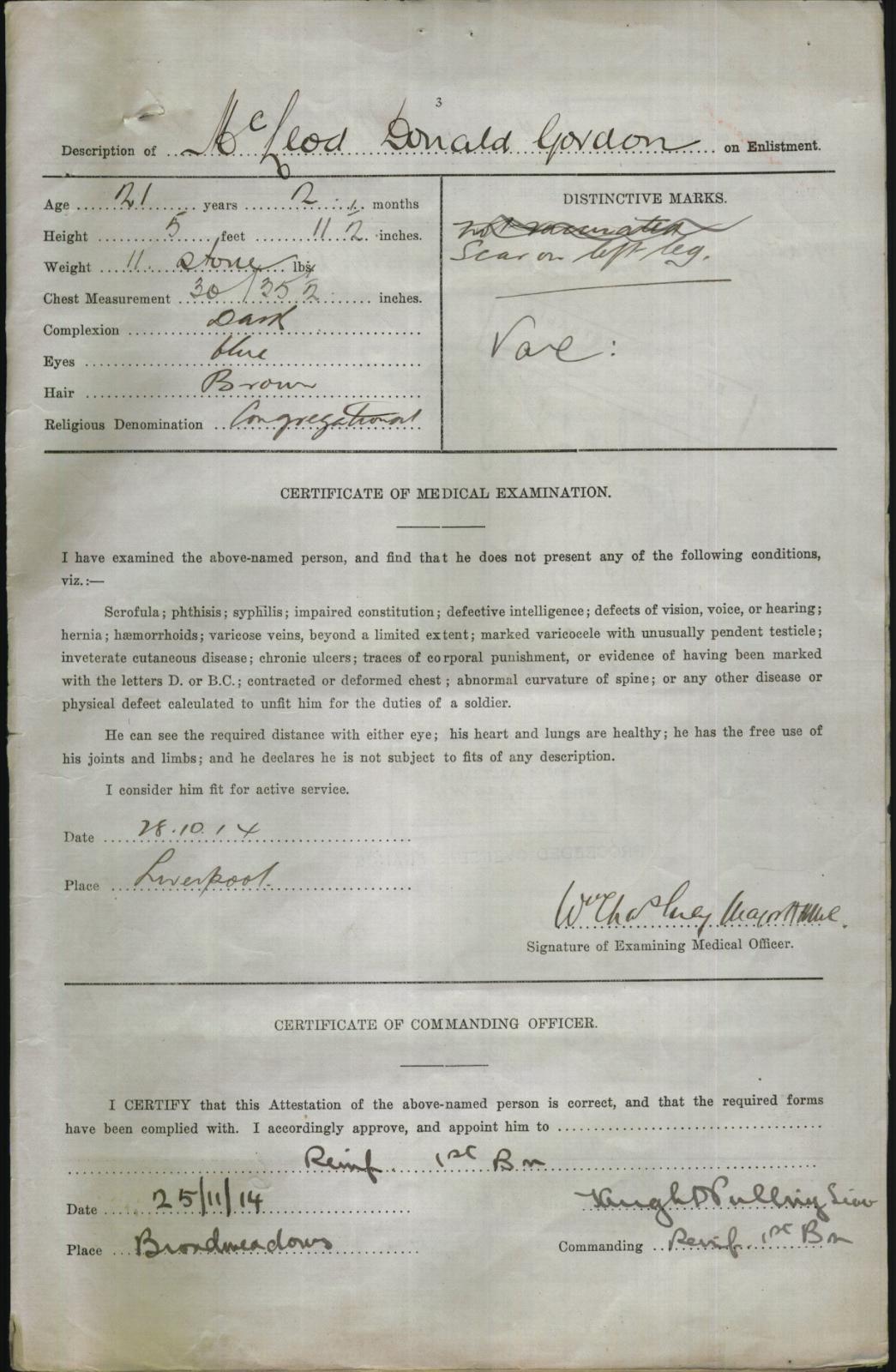
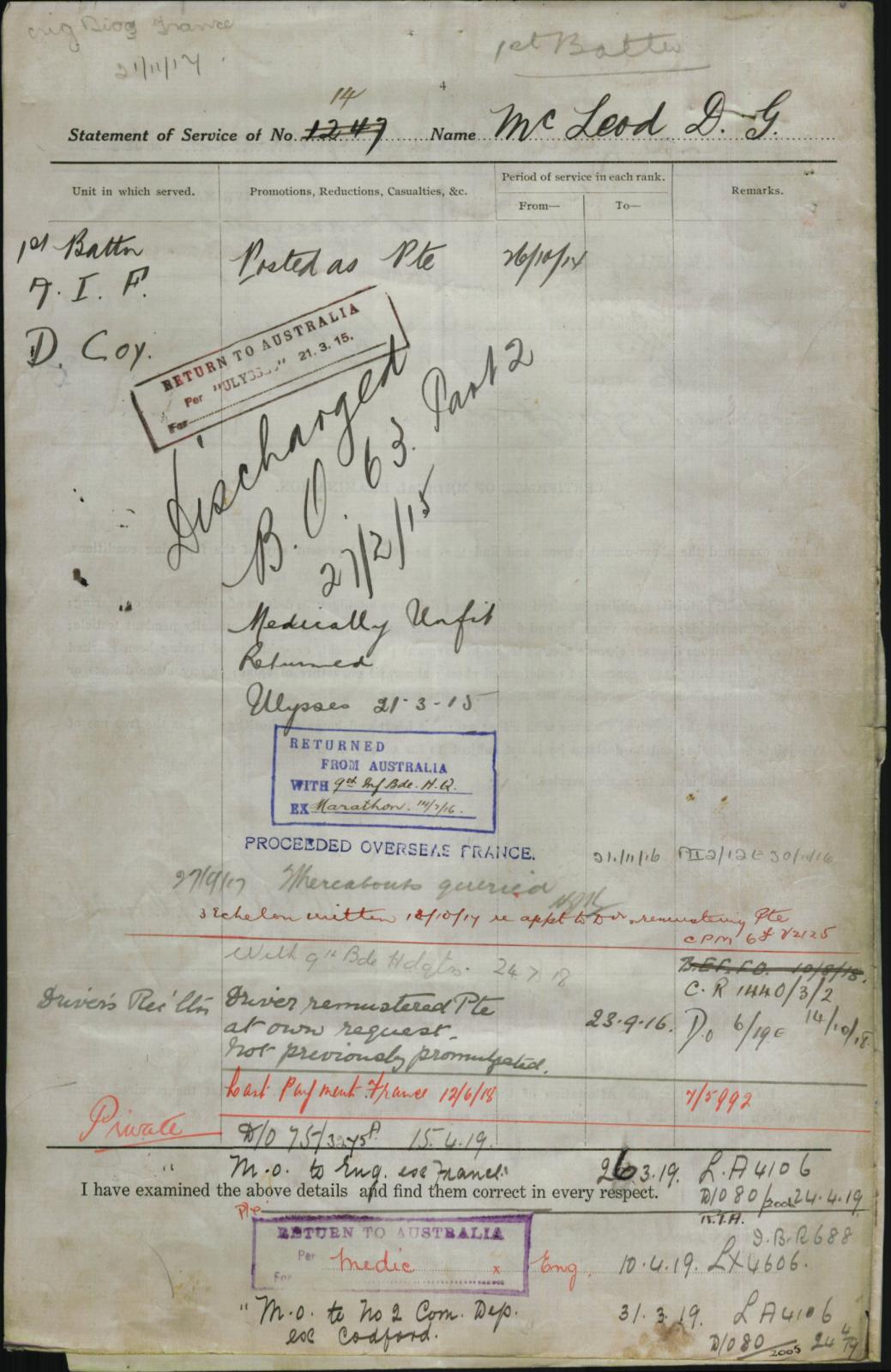
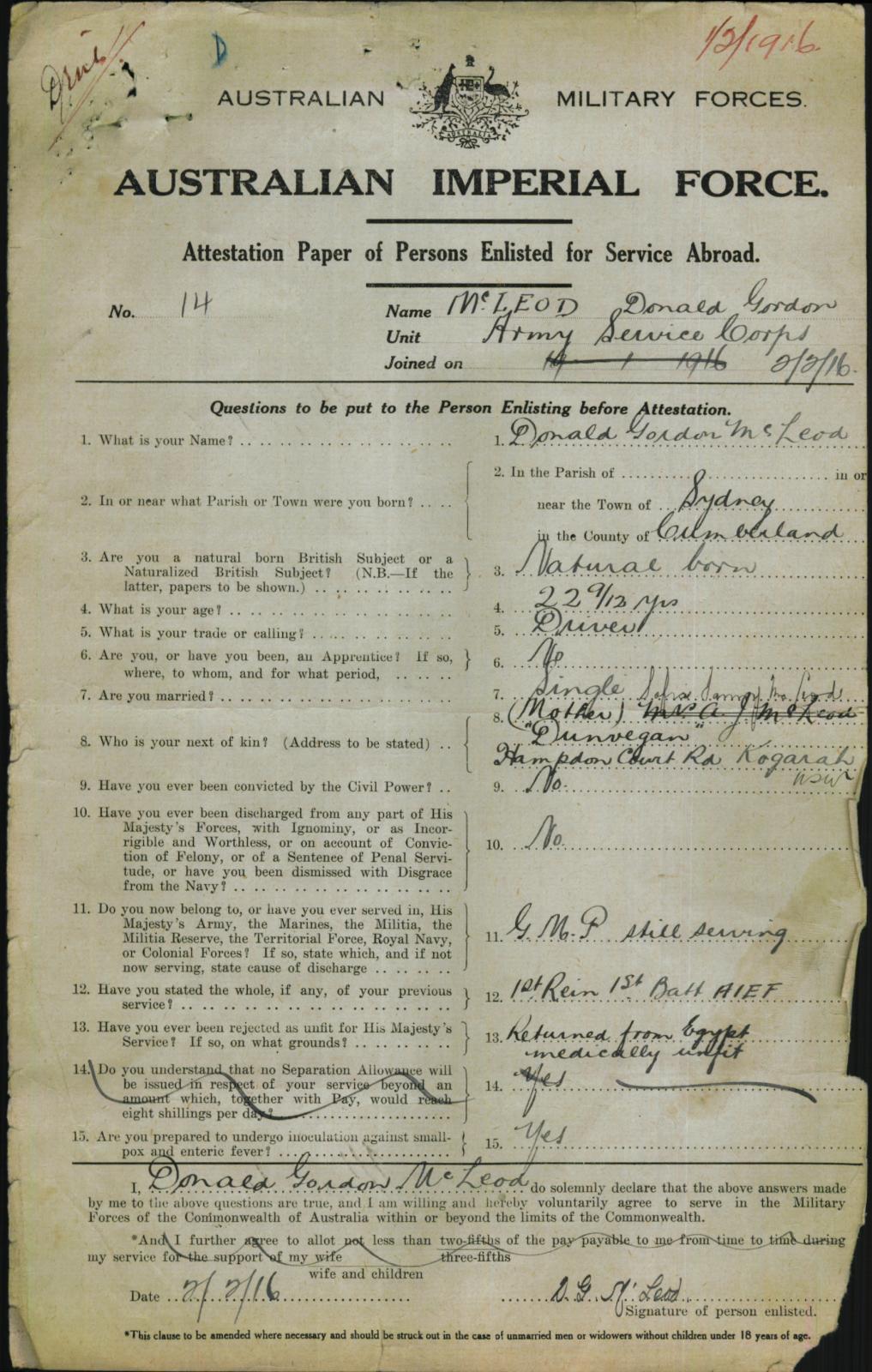




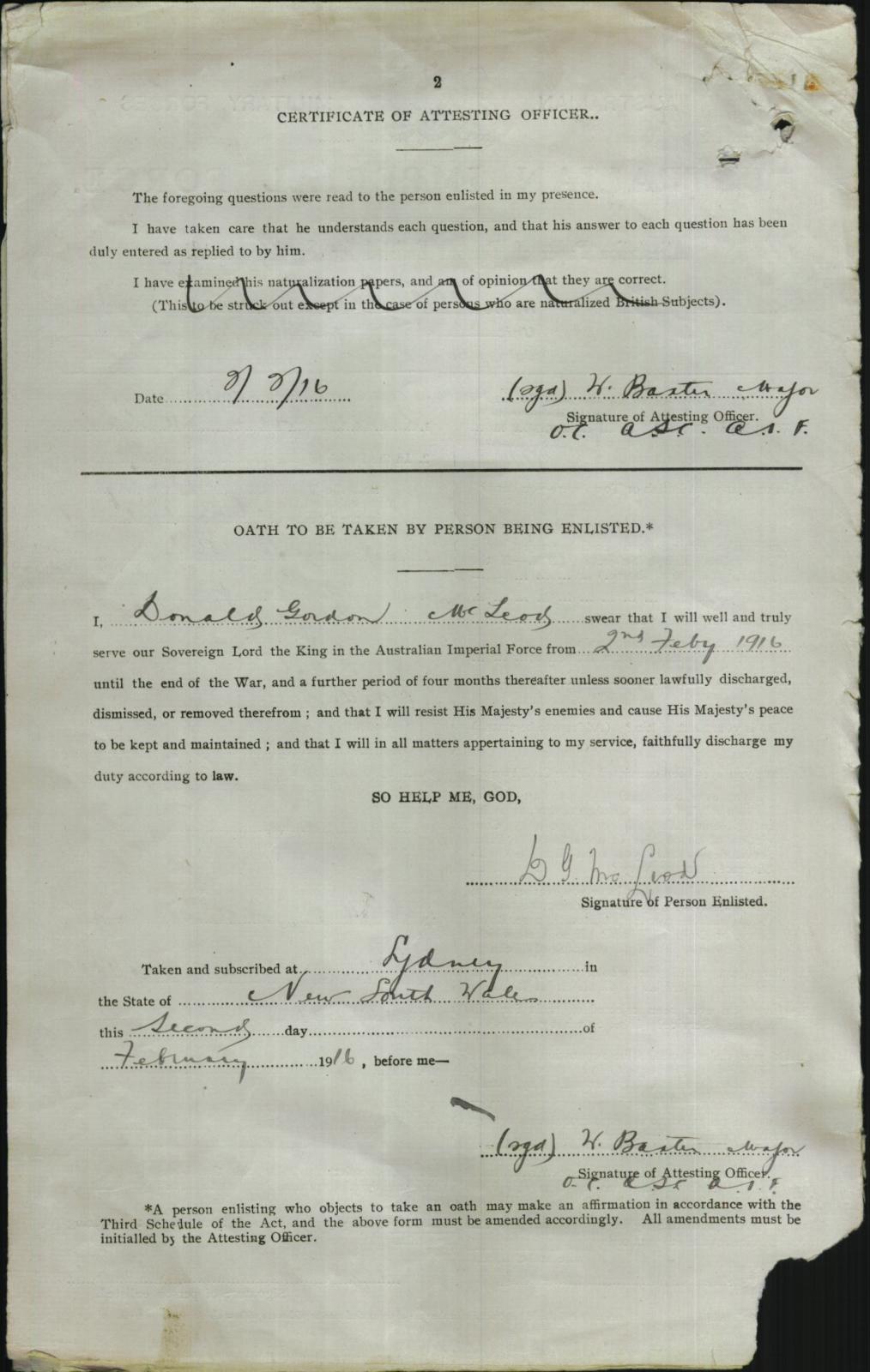
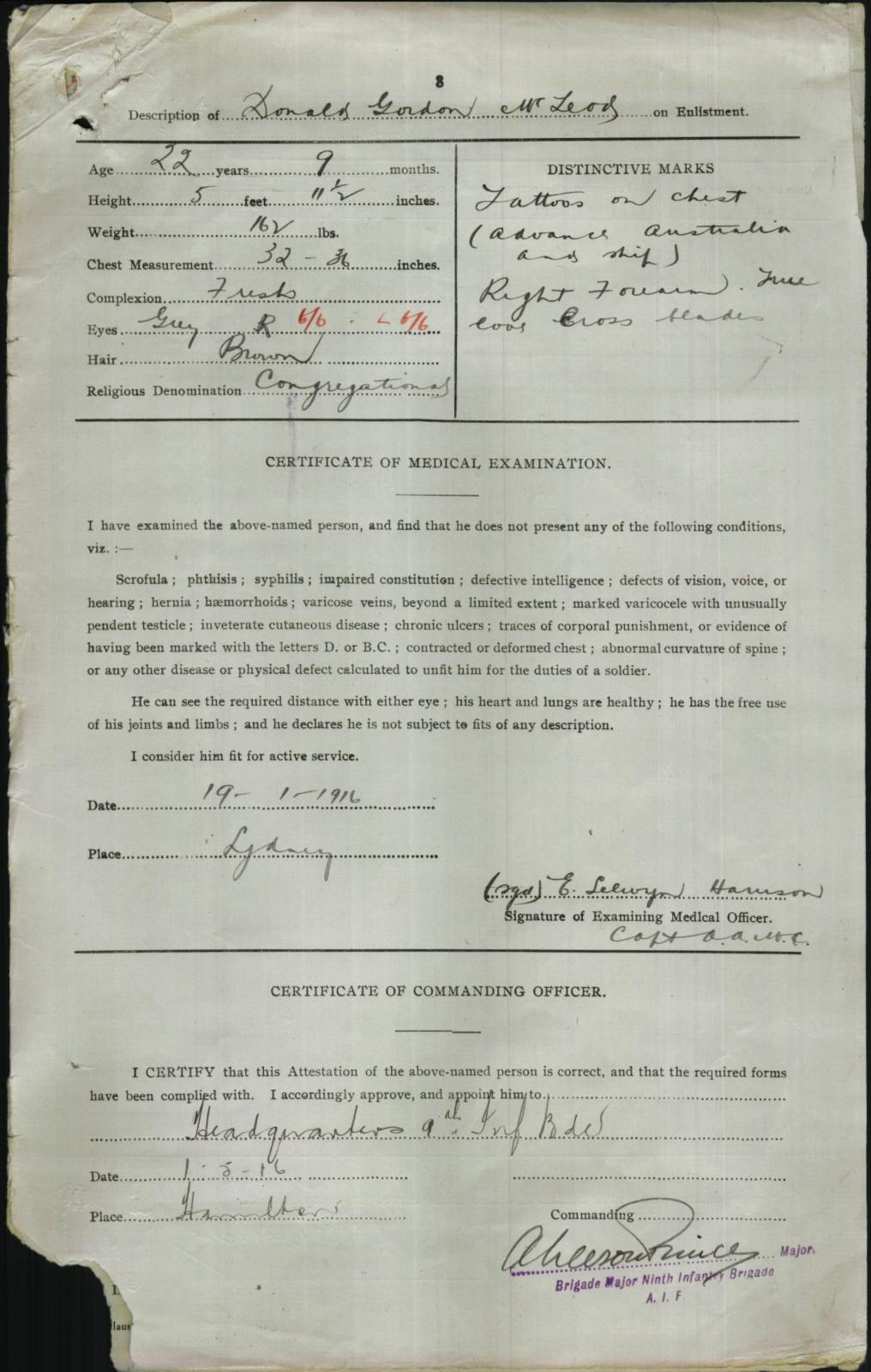
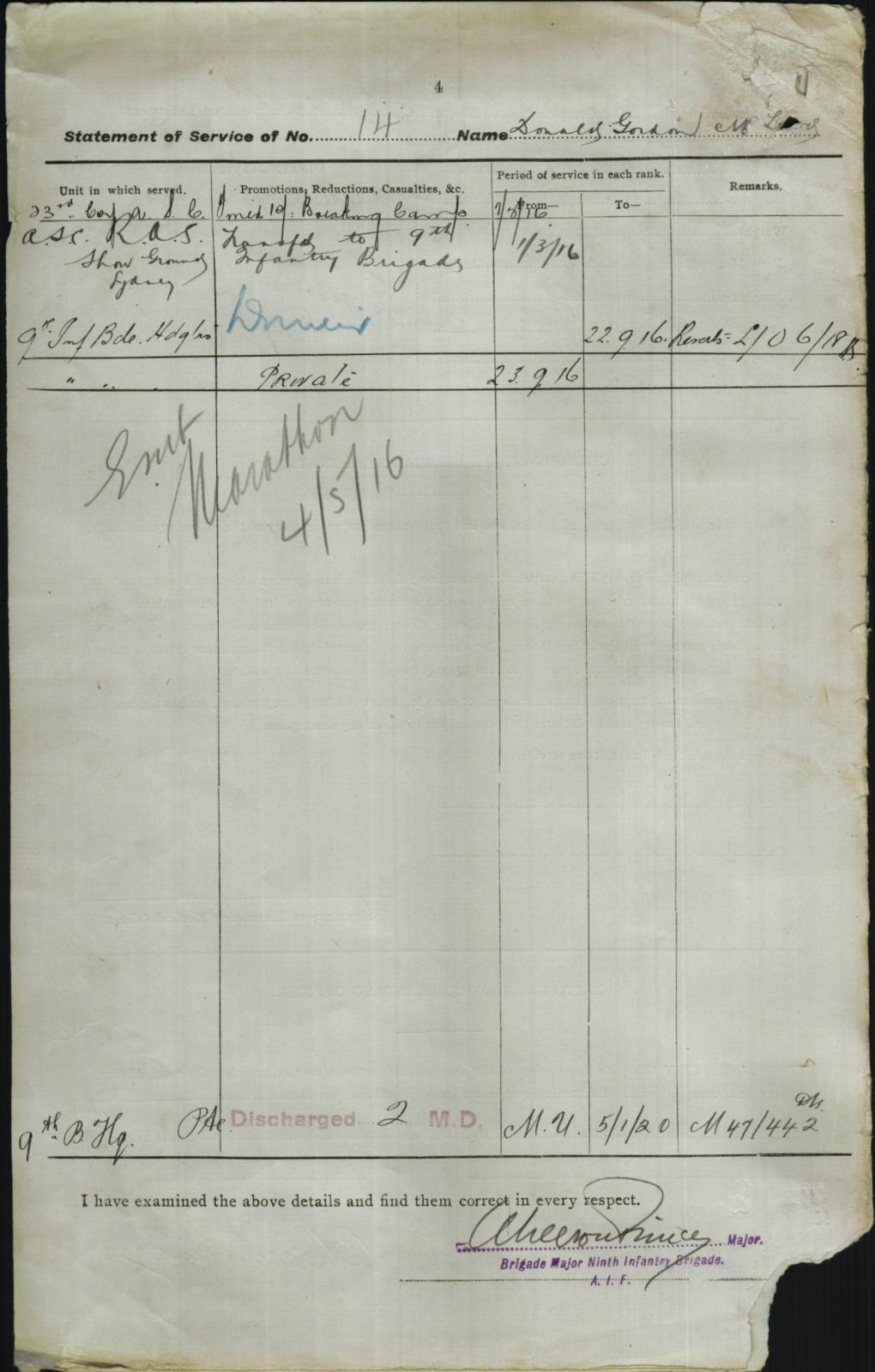


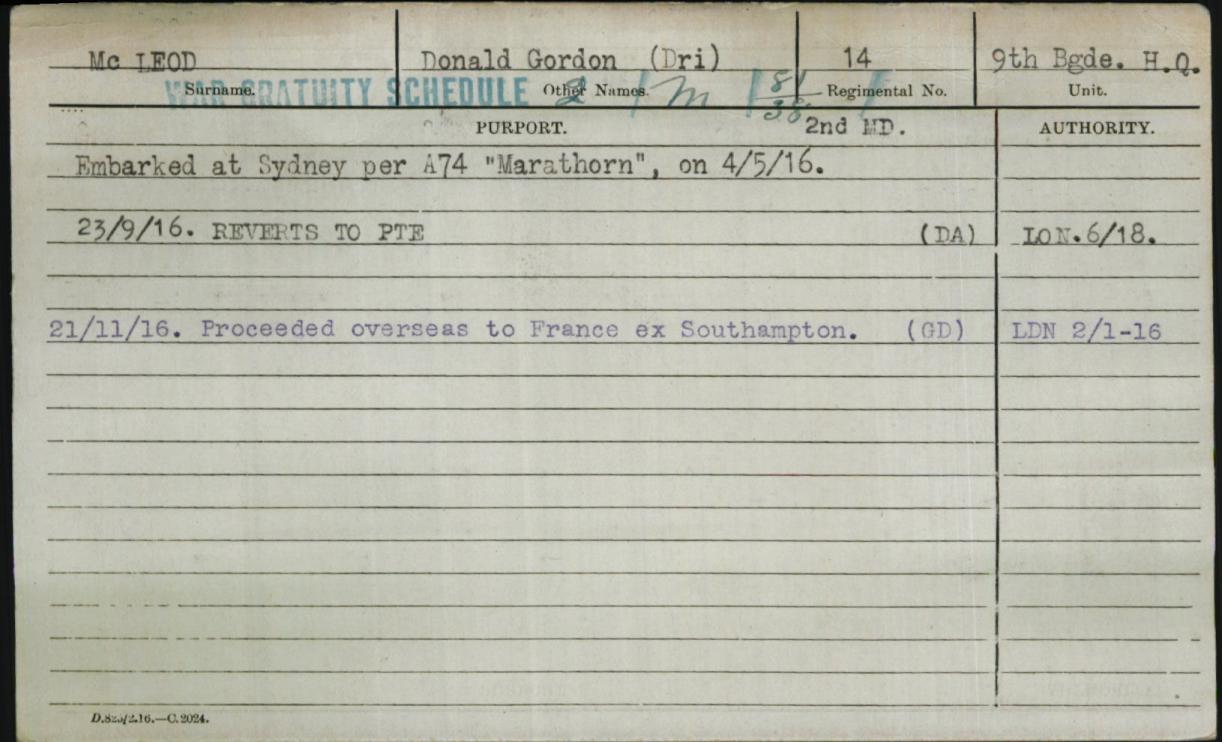



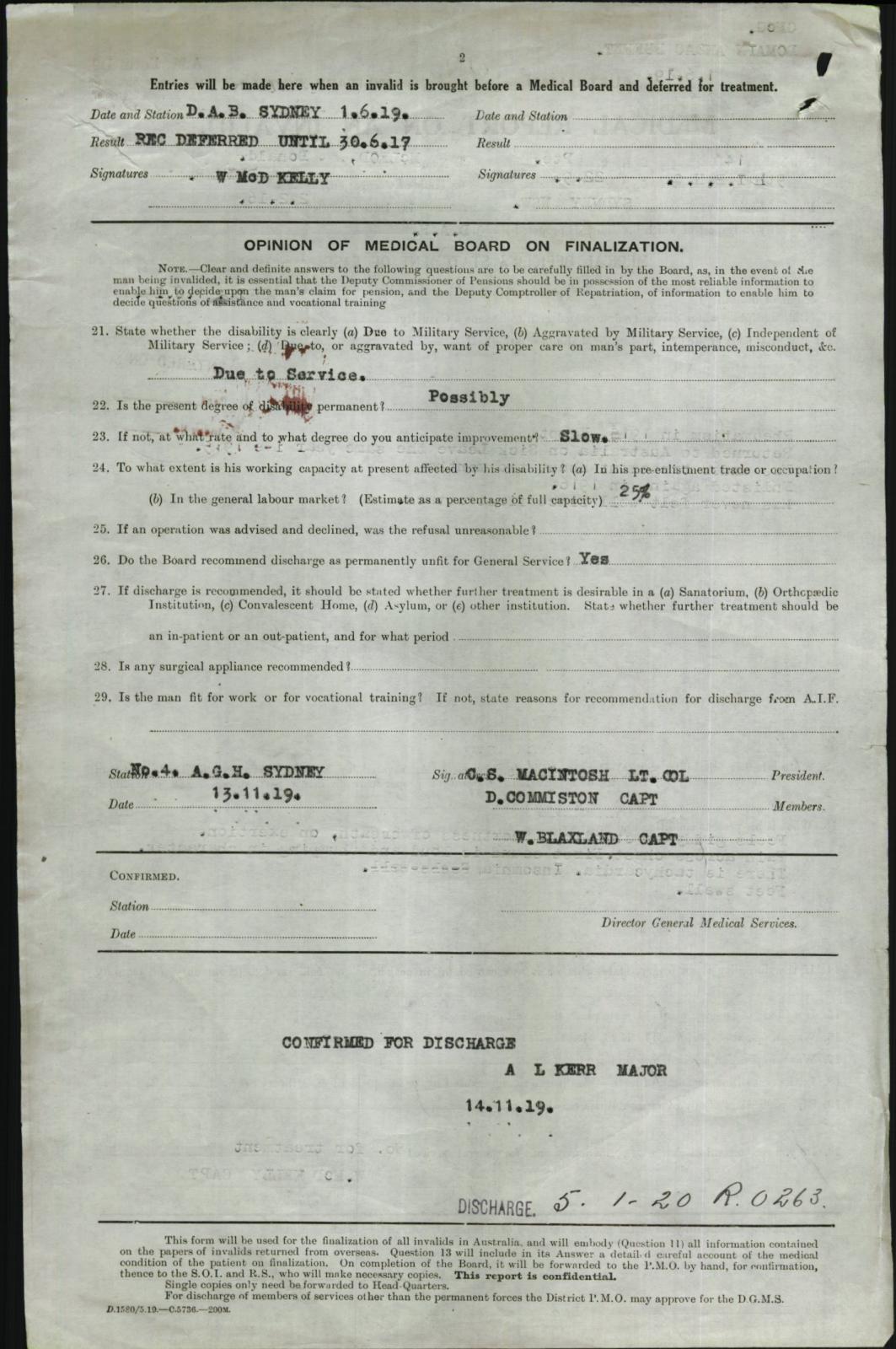

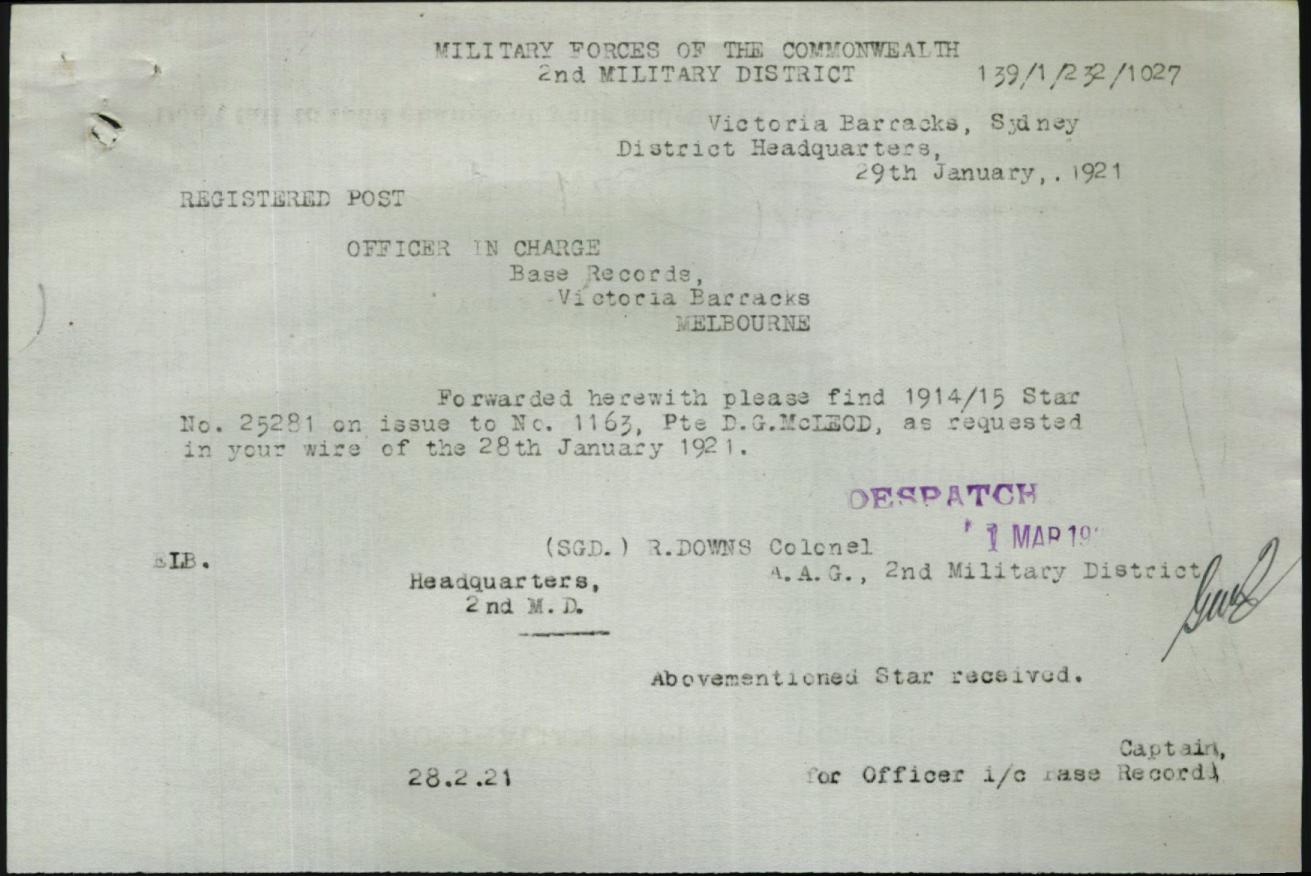

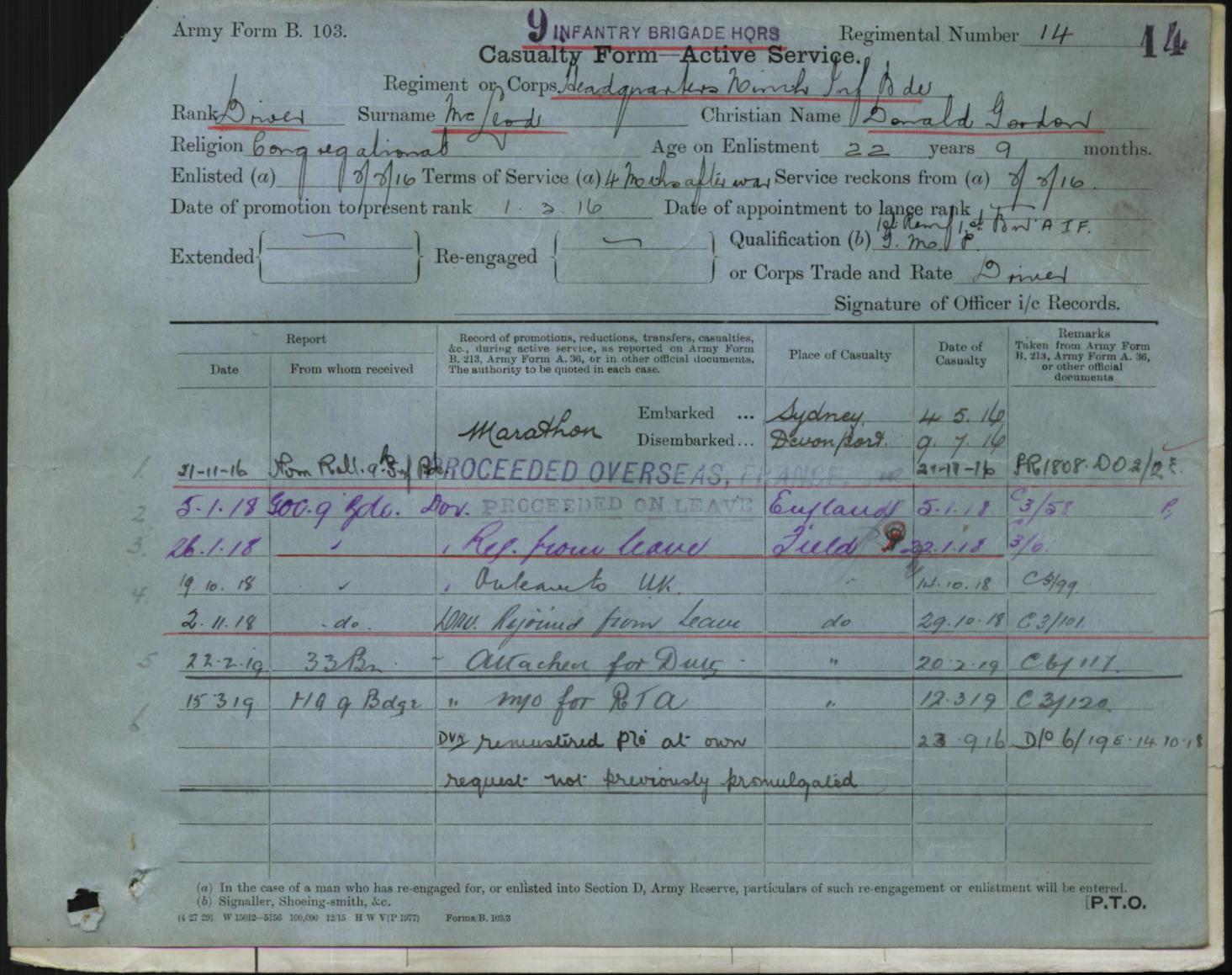
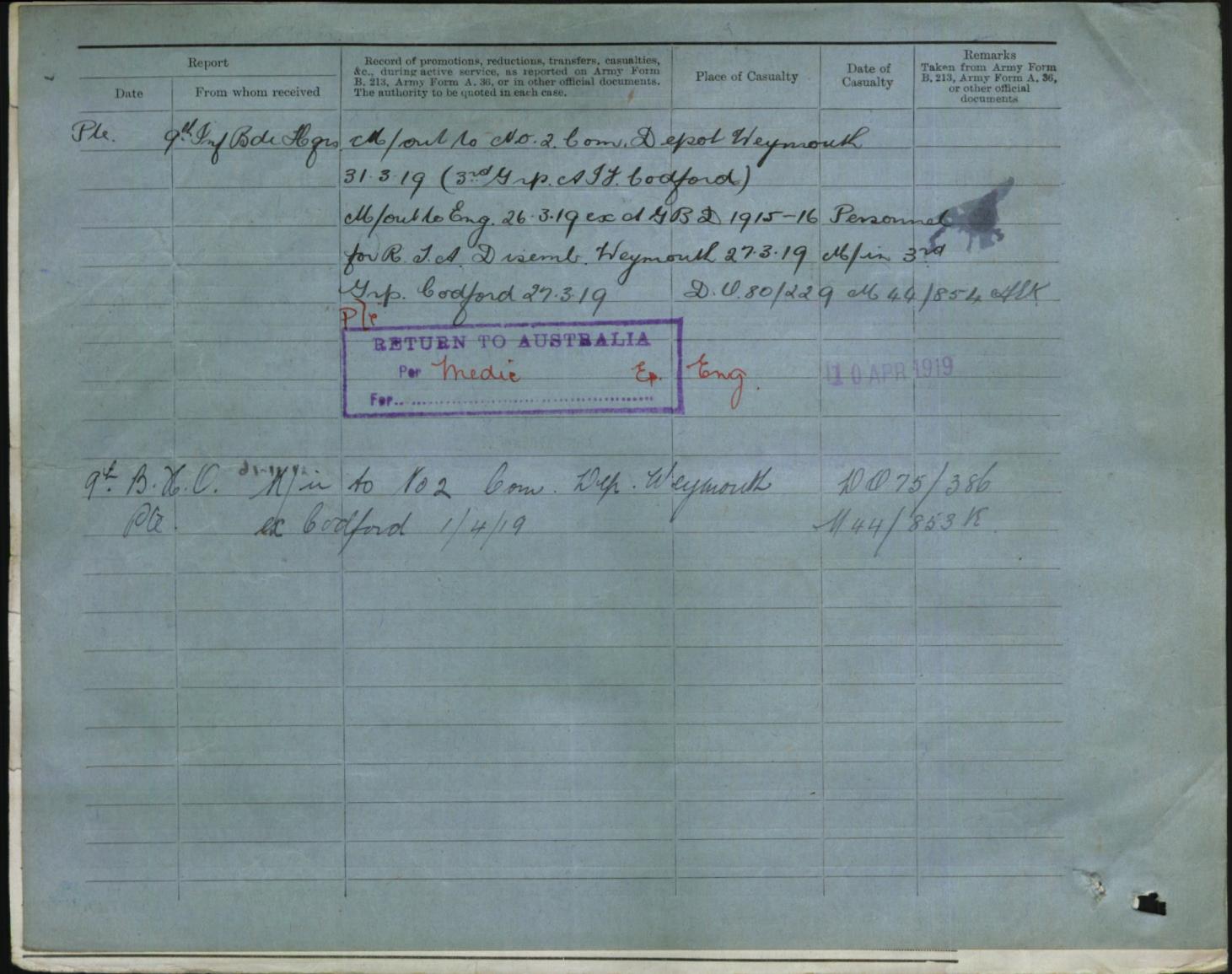
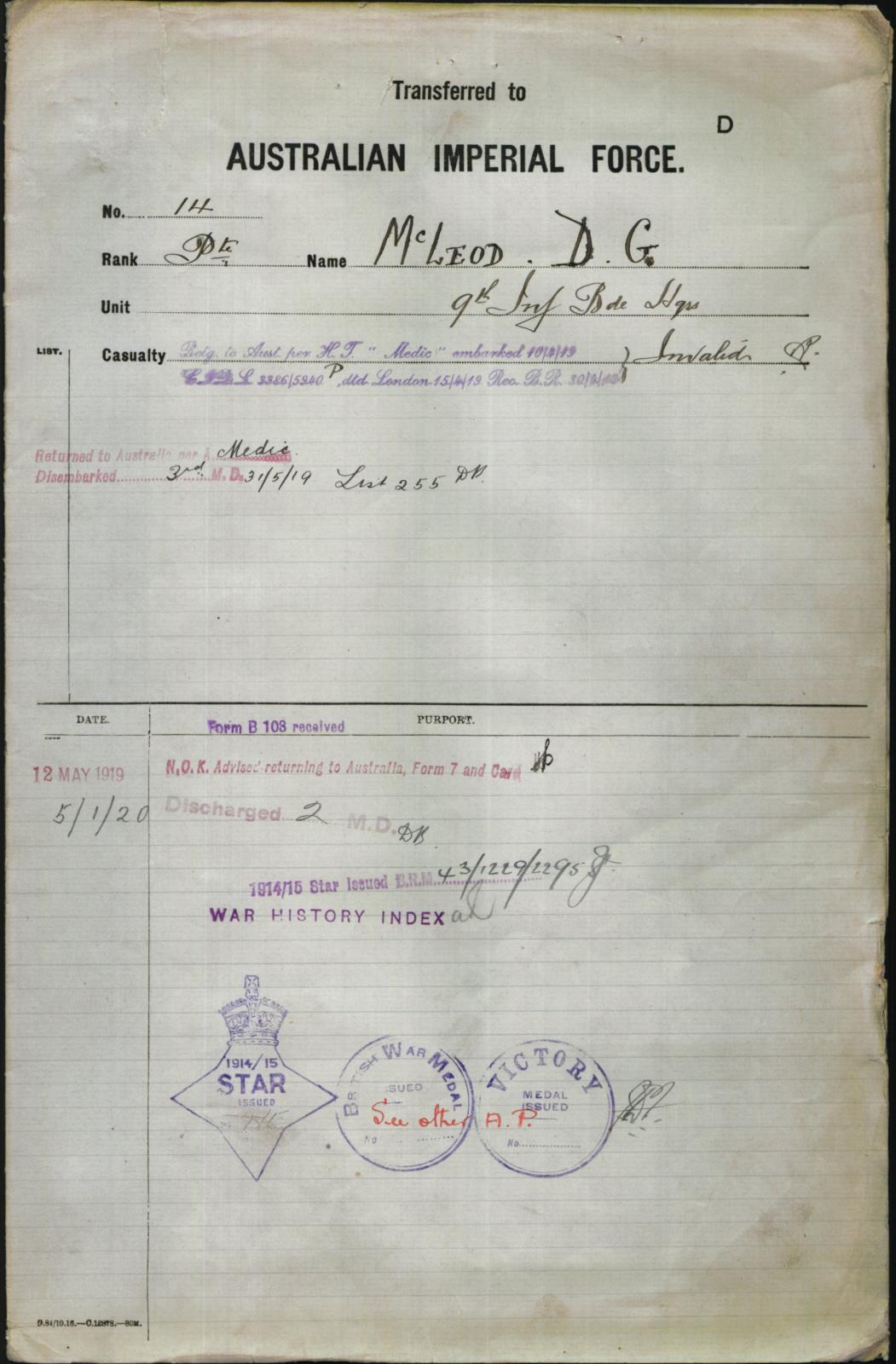
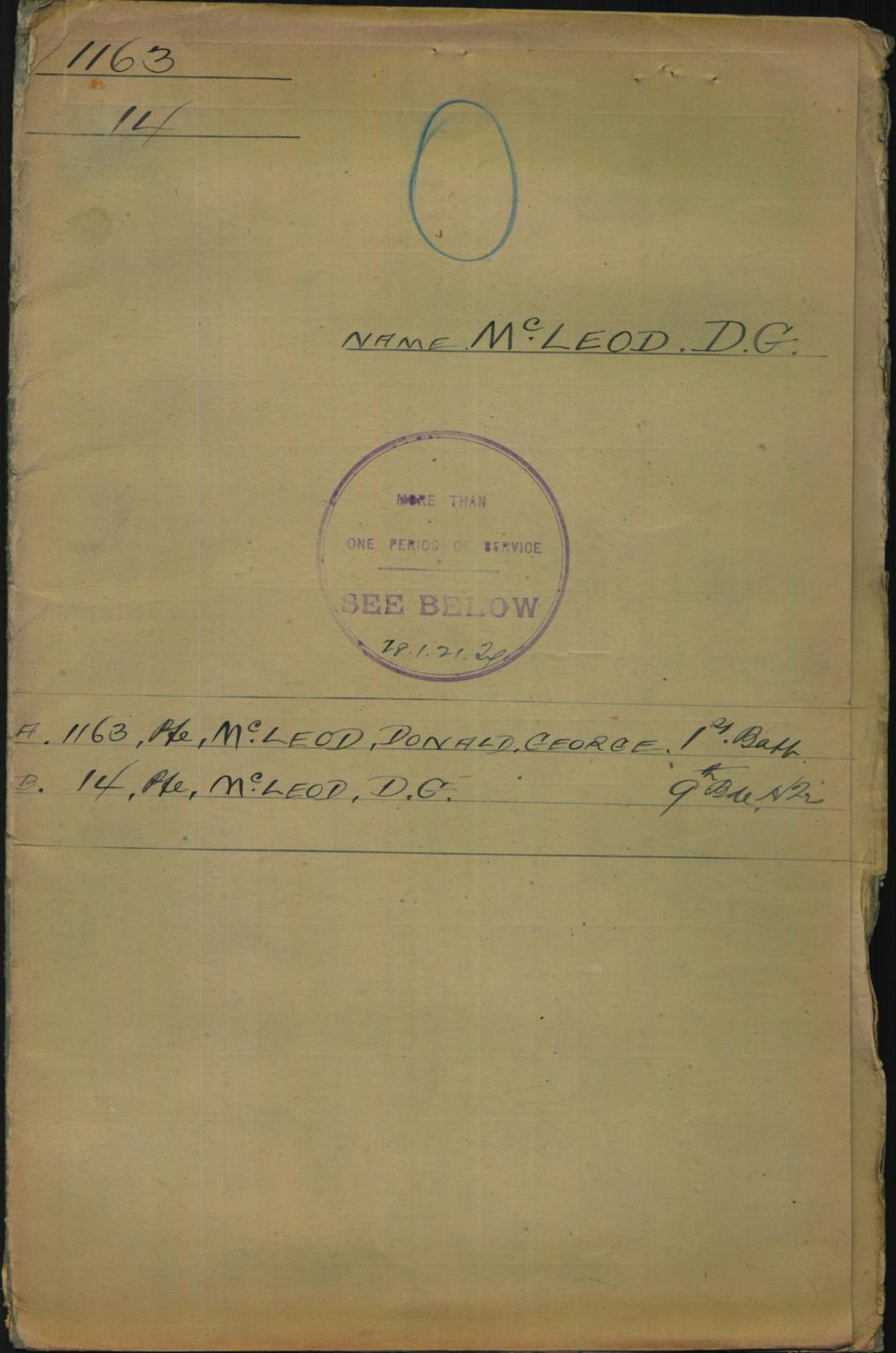
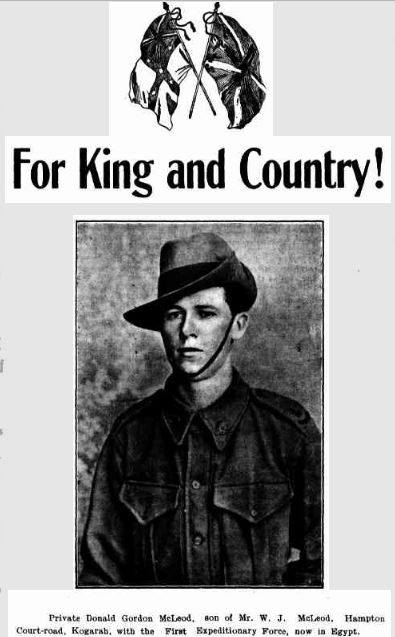

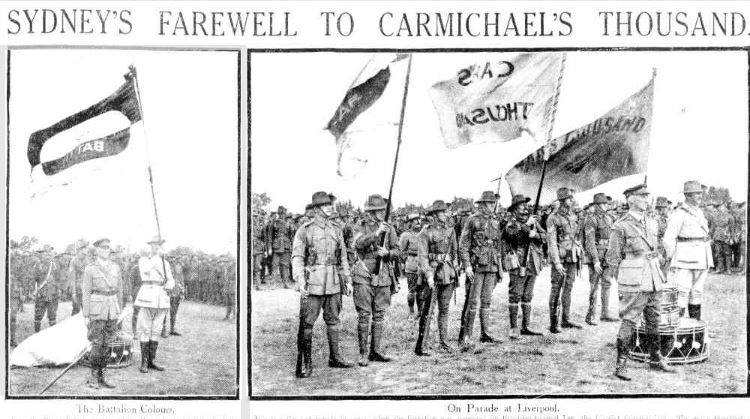

 36th Battalion's last Parade before being disbanded. 30th April 1918.
36th Battalion's last Parade before being disbanded. 30th April 1918.



















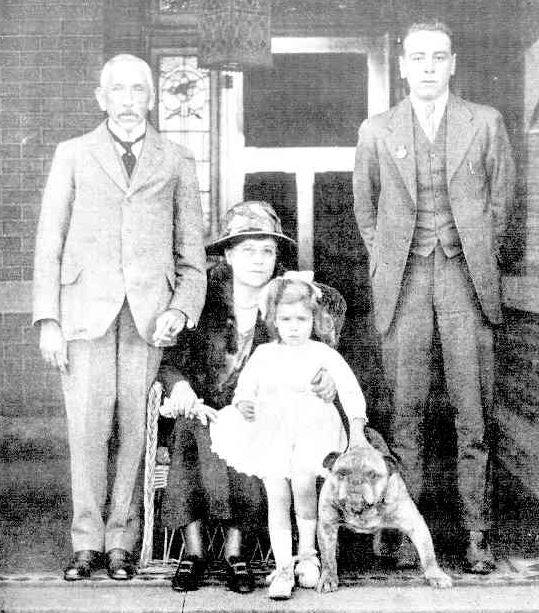
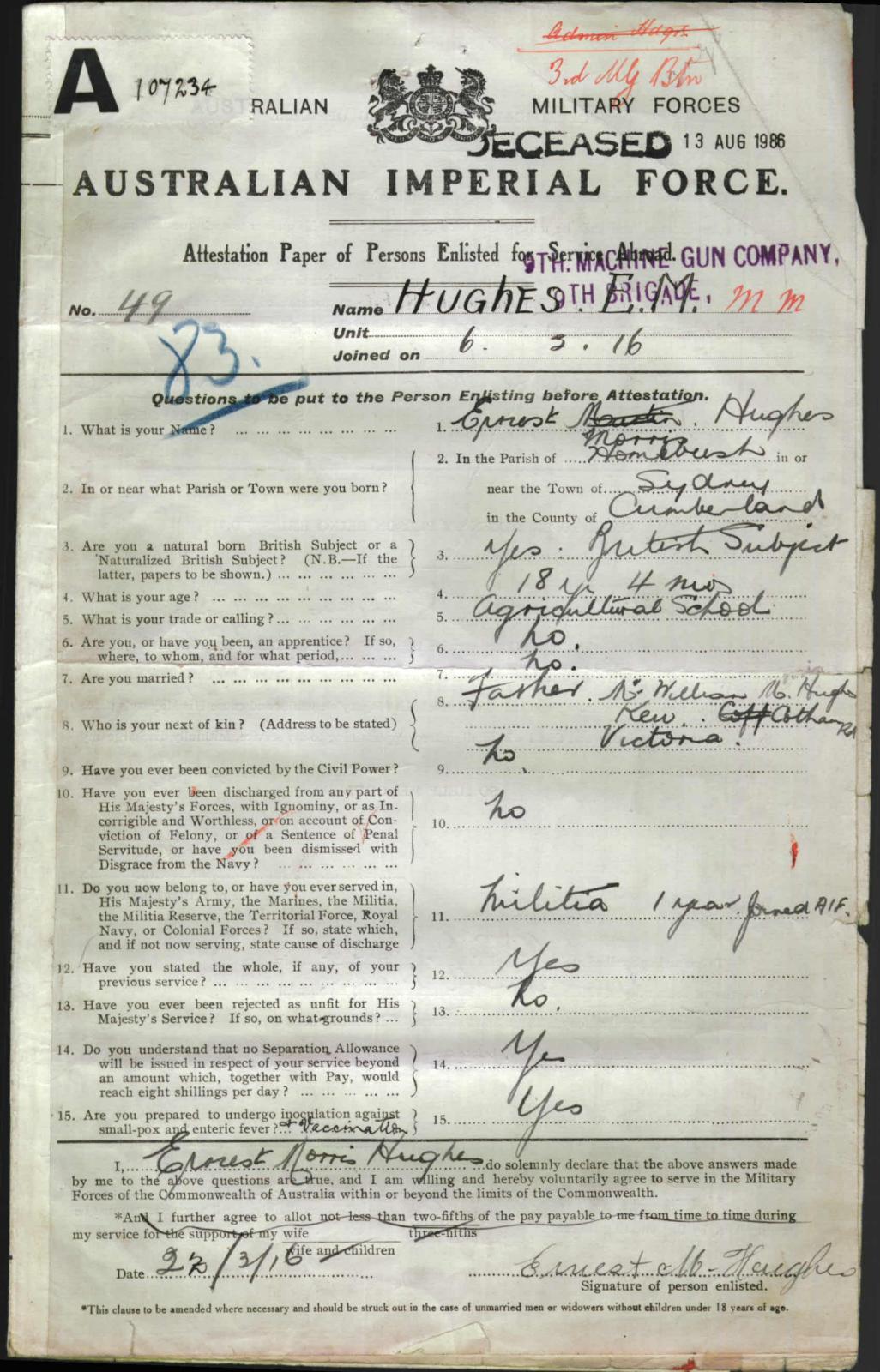

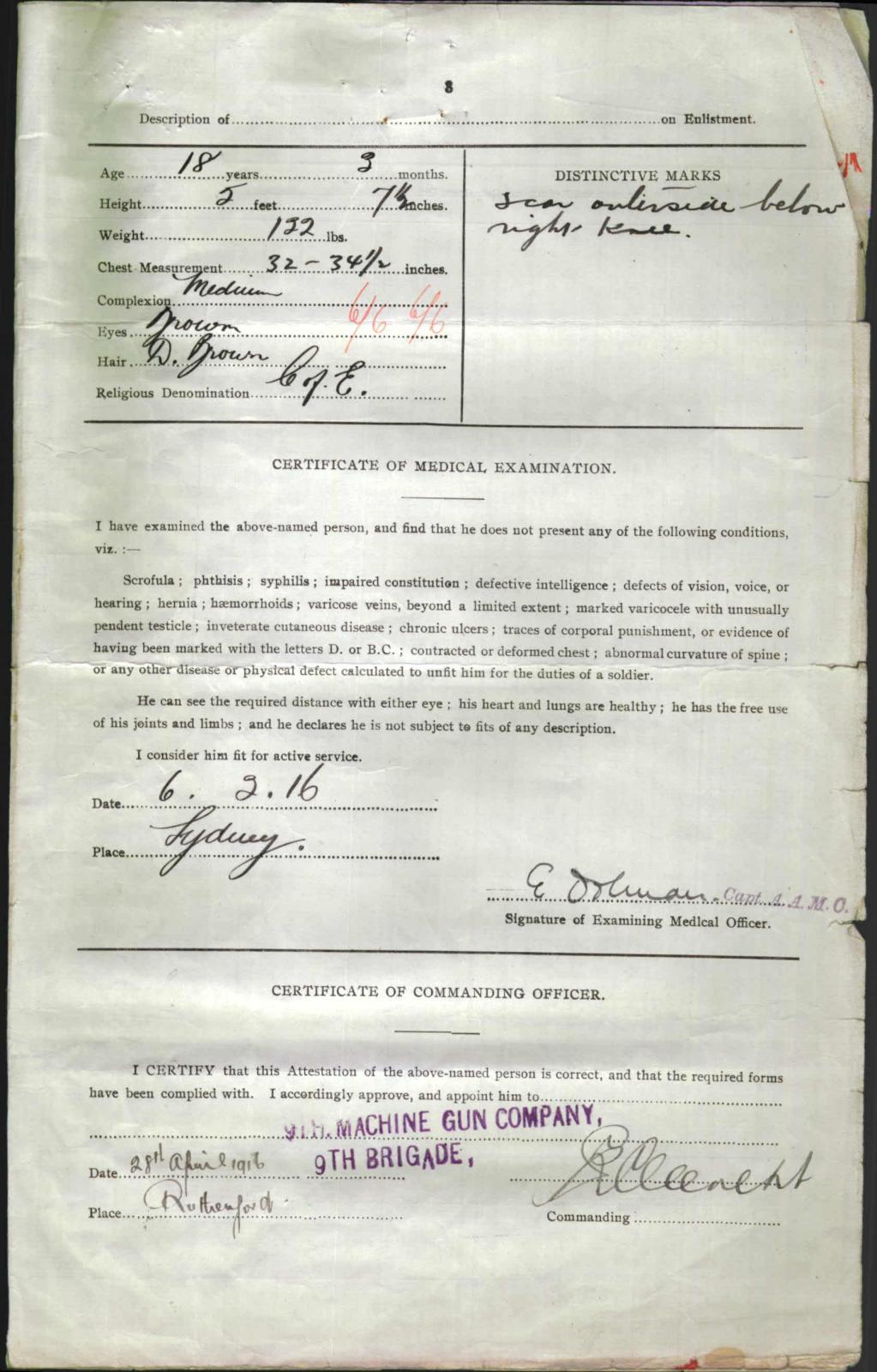
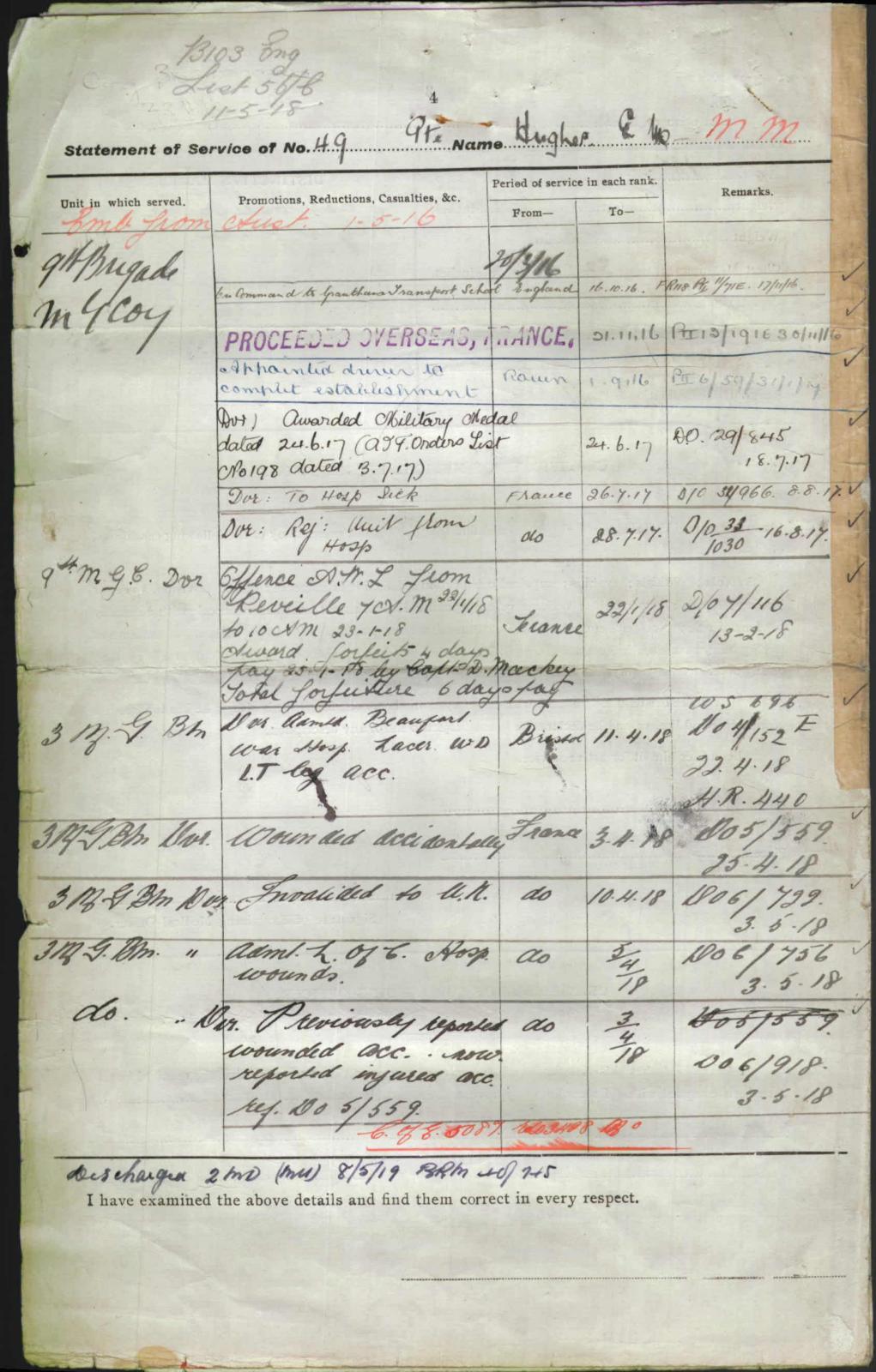




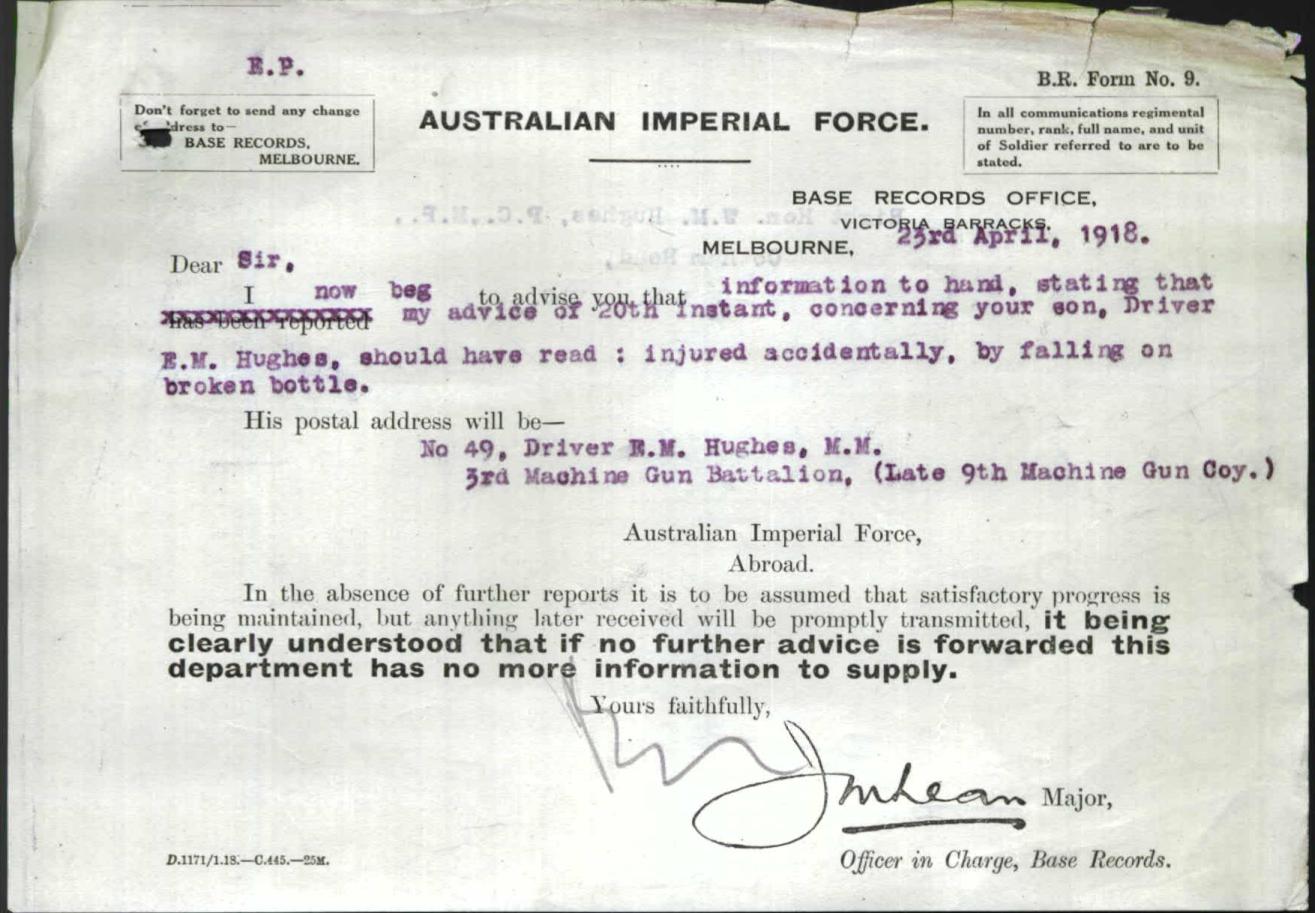

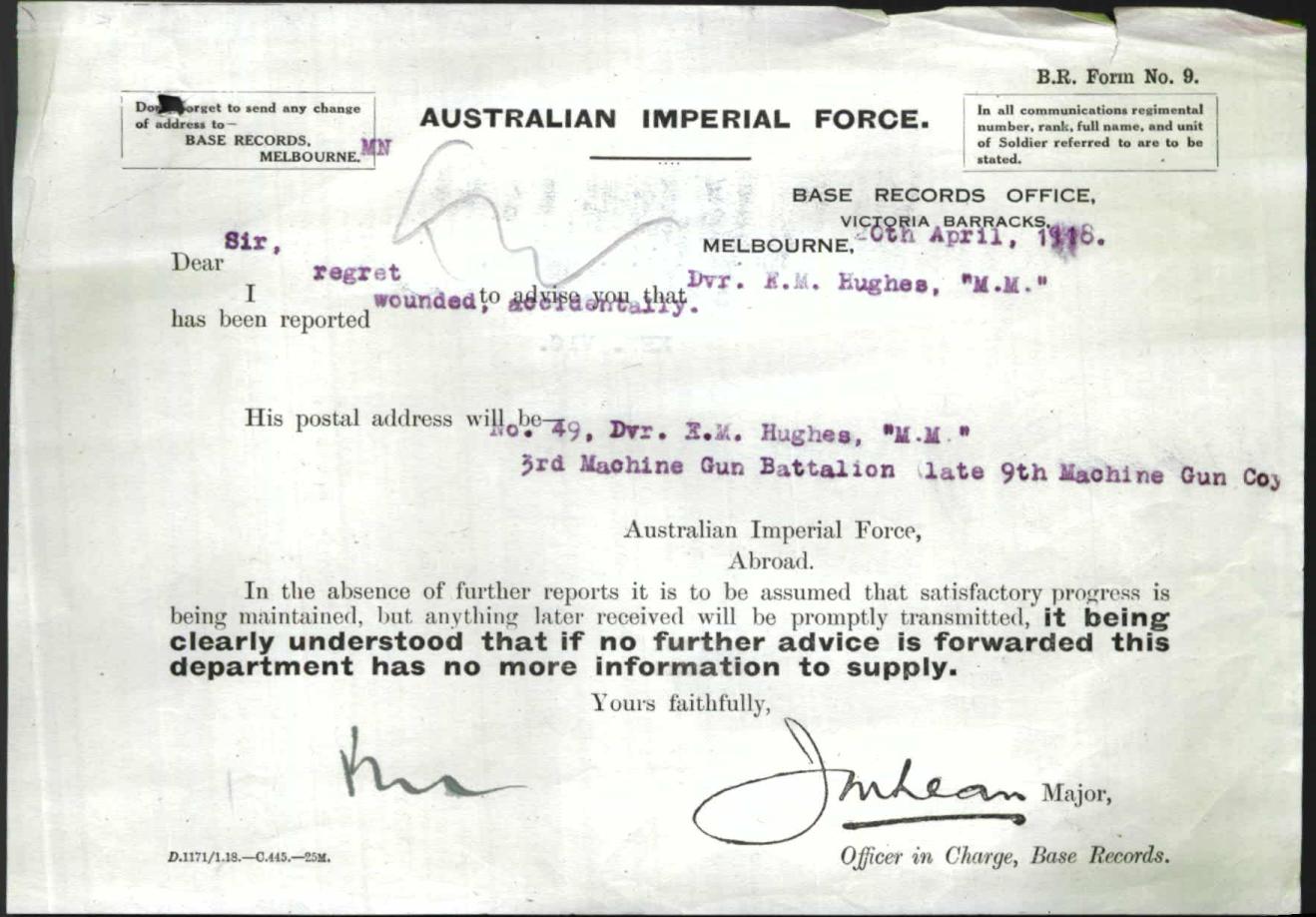
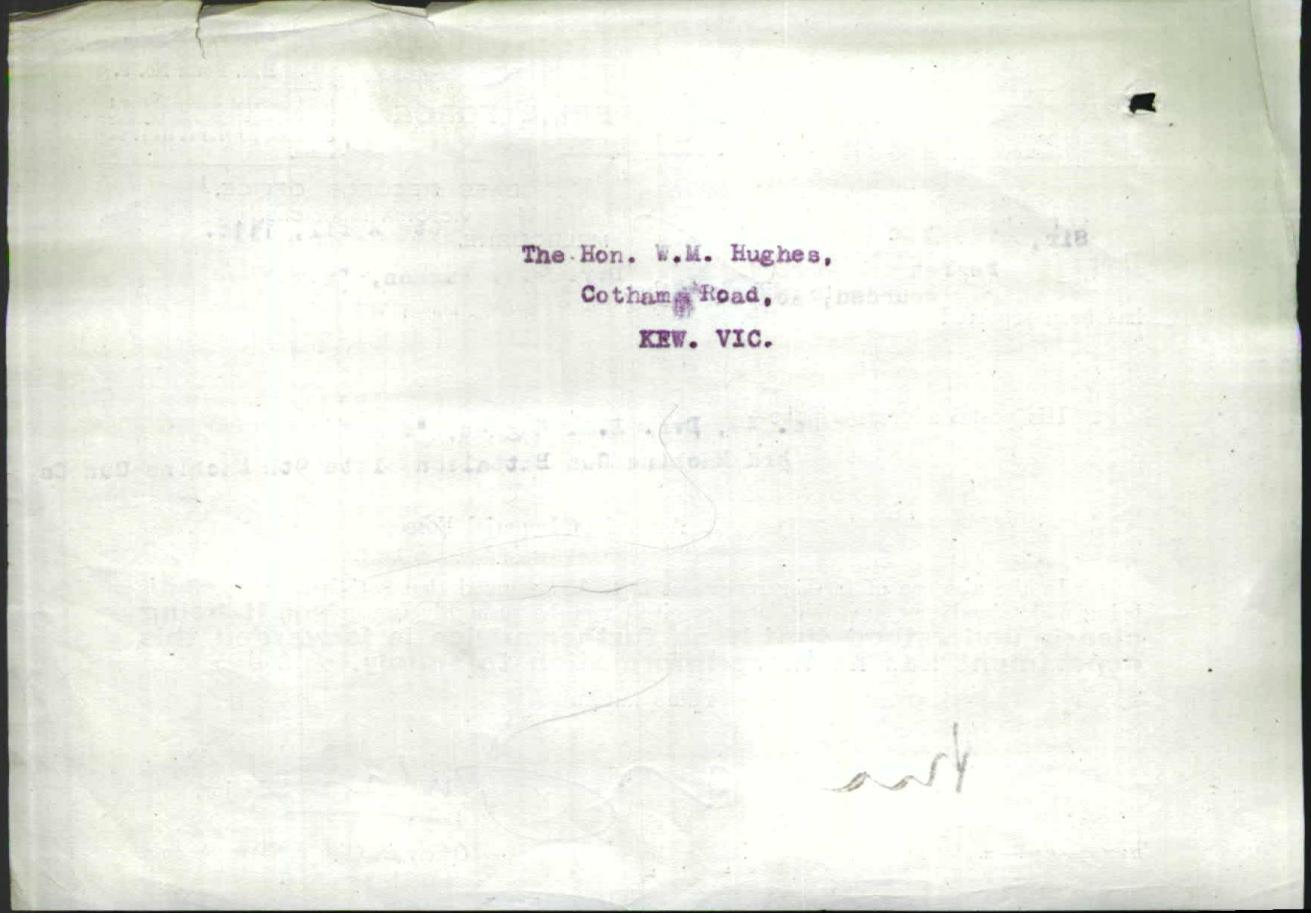
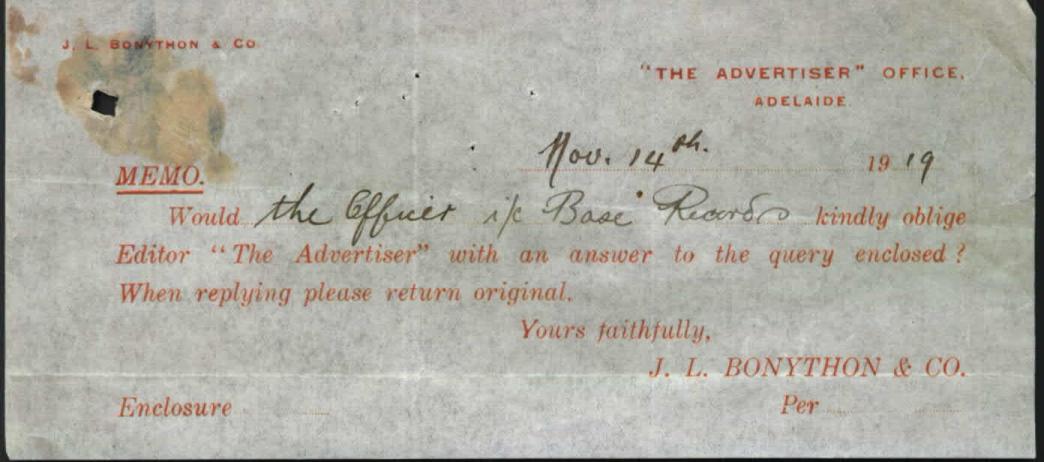

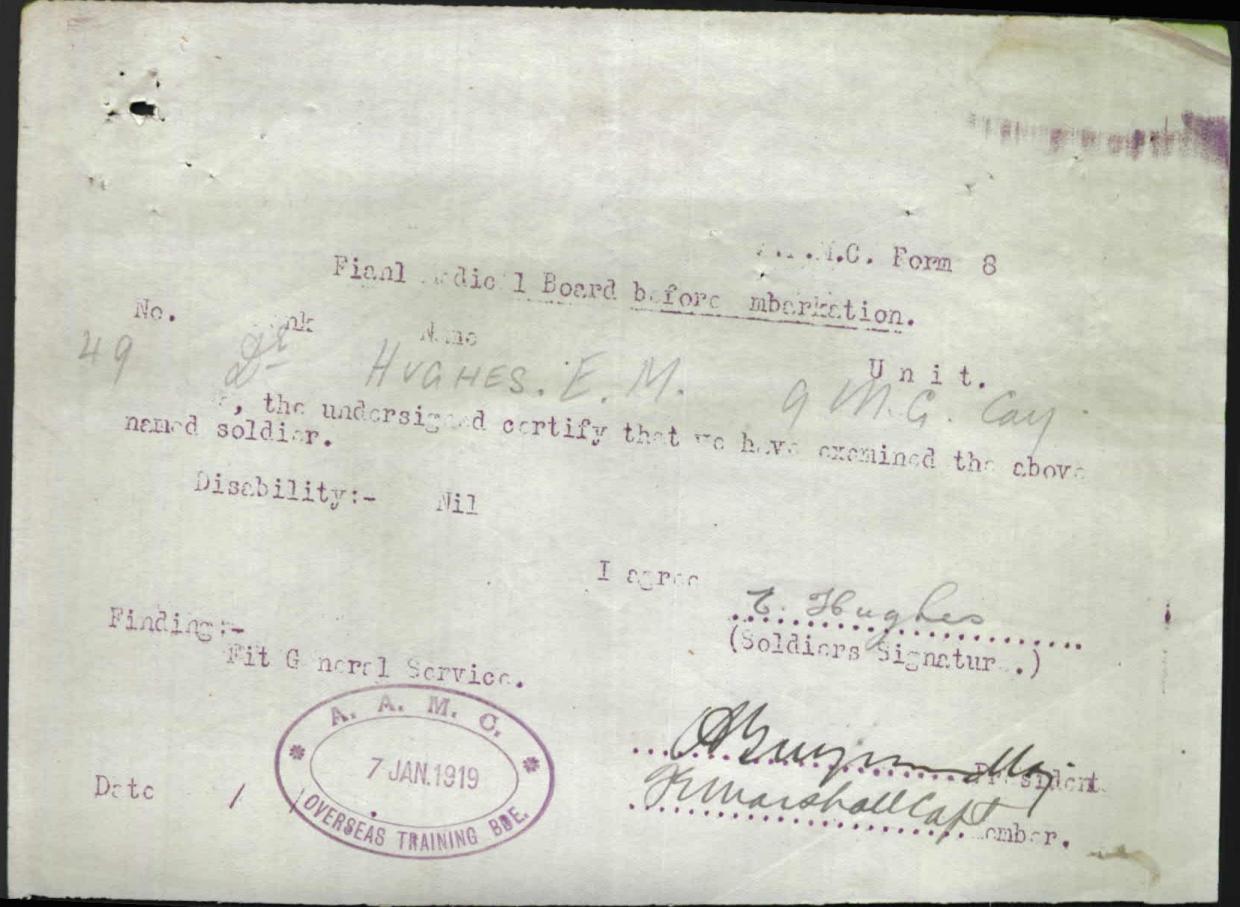



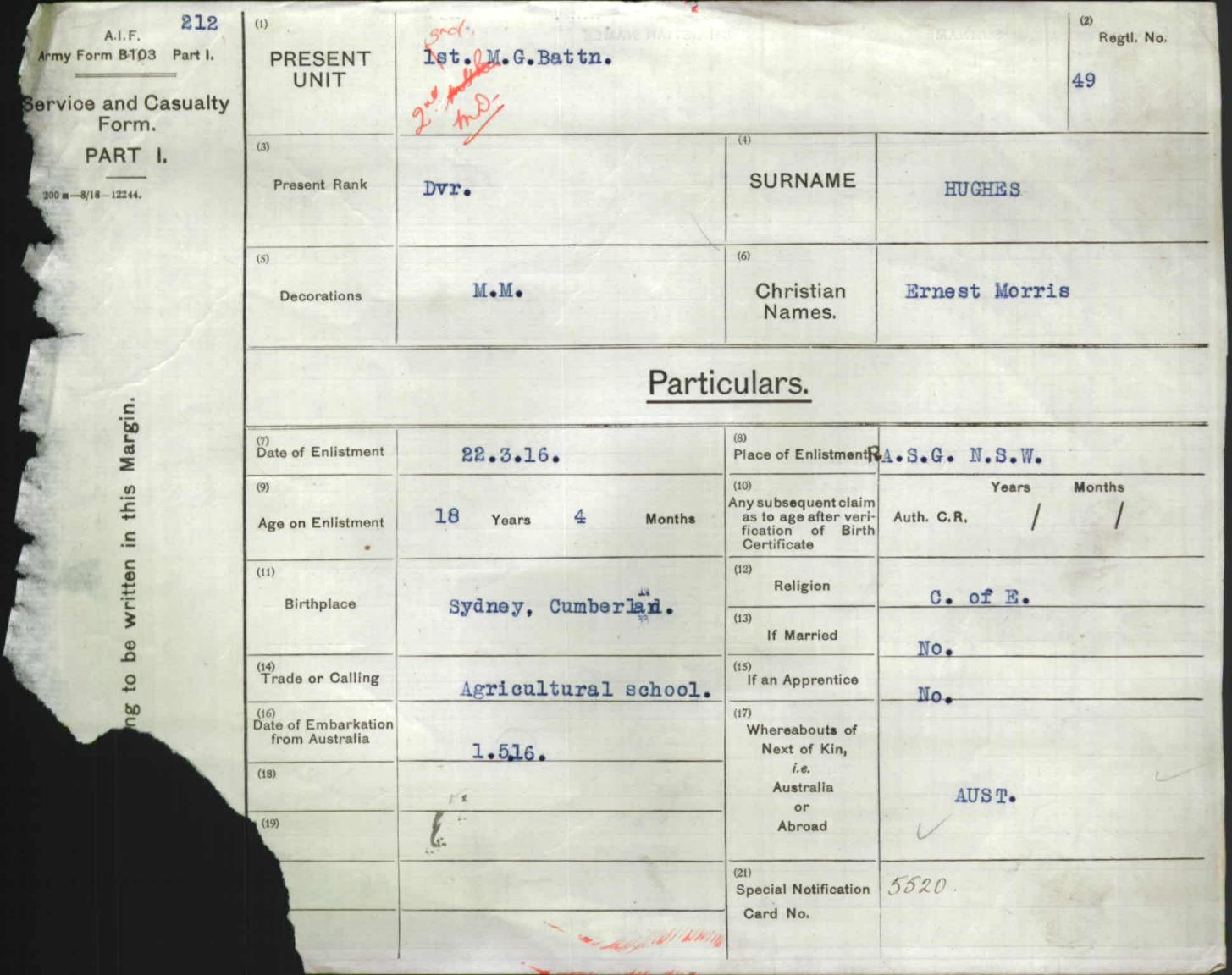
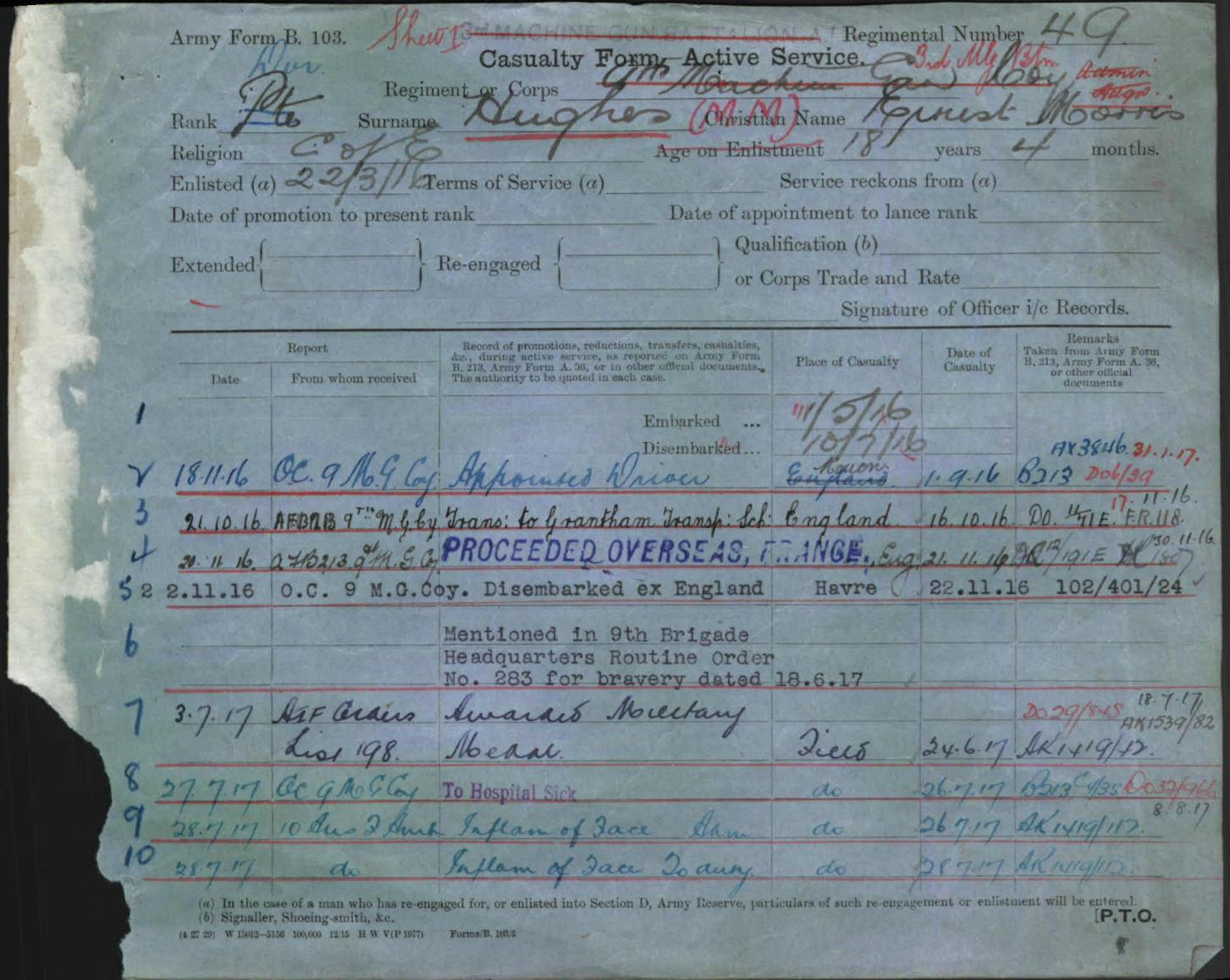


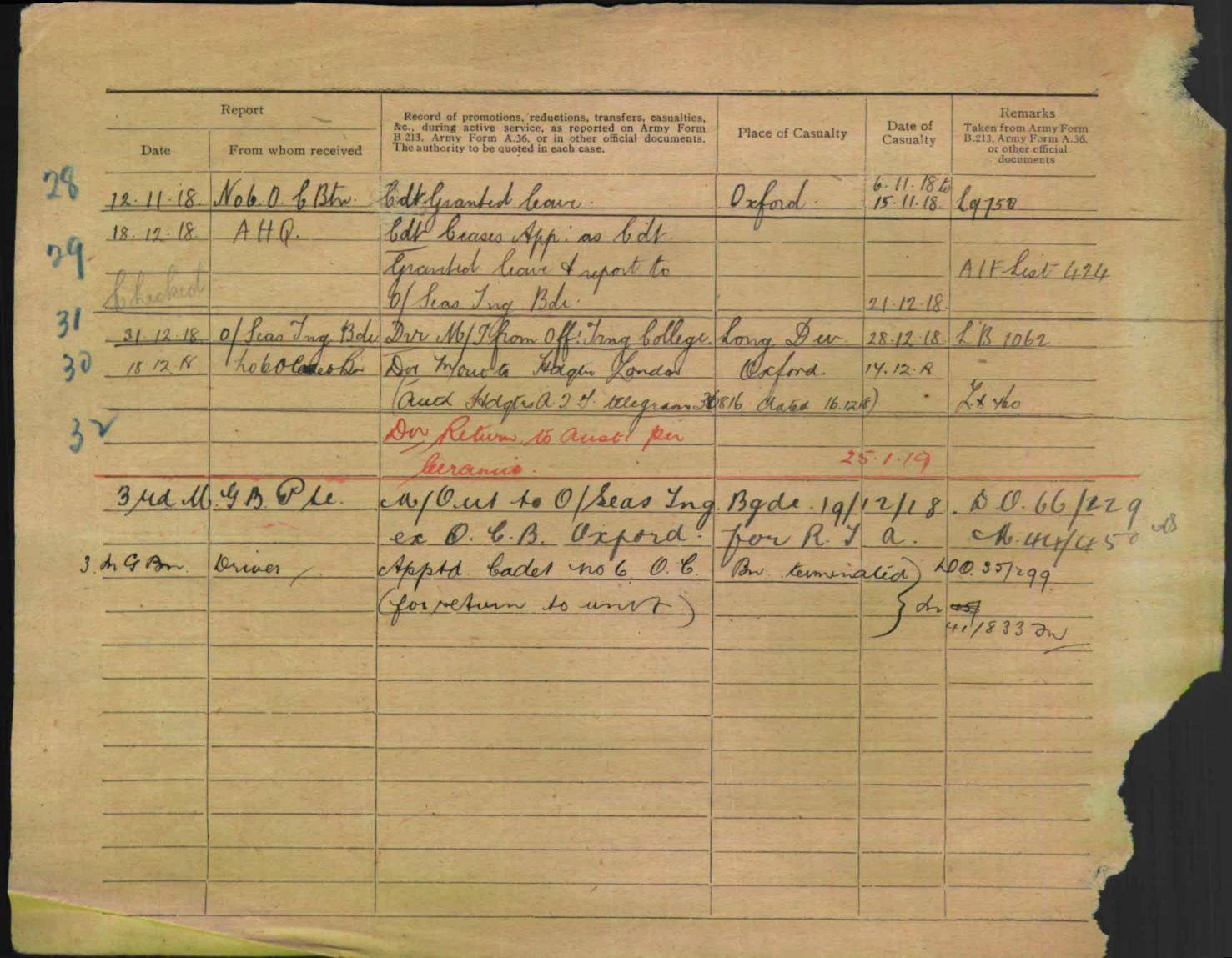
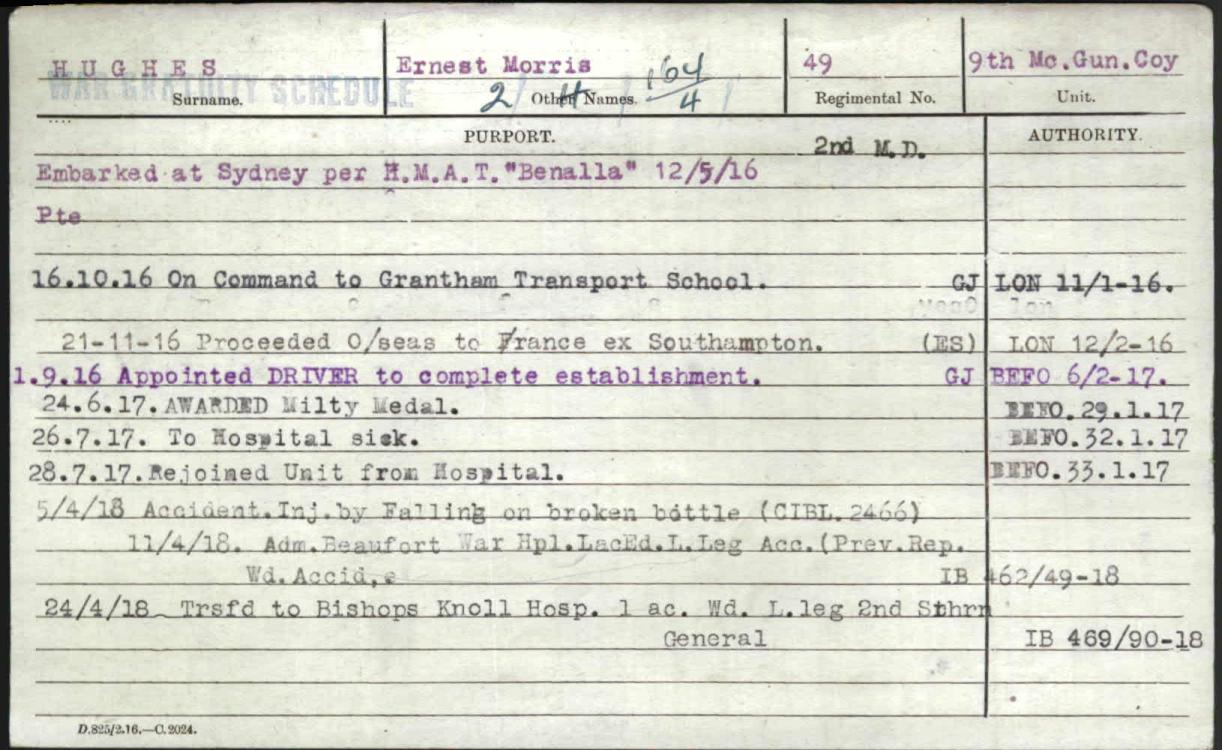
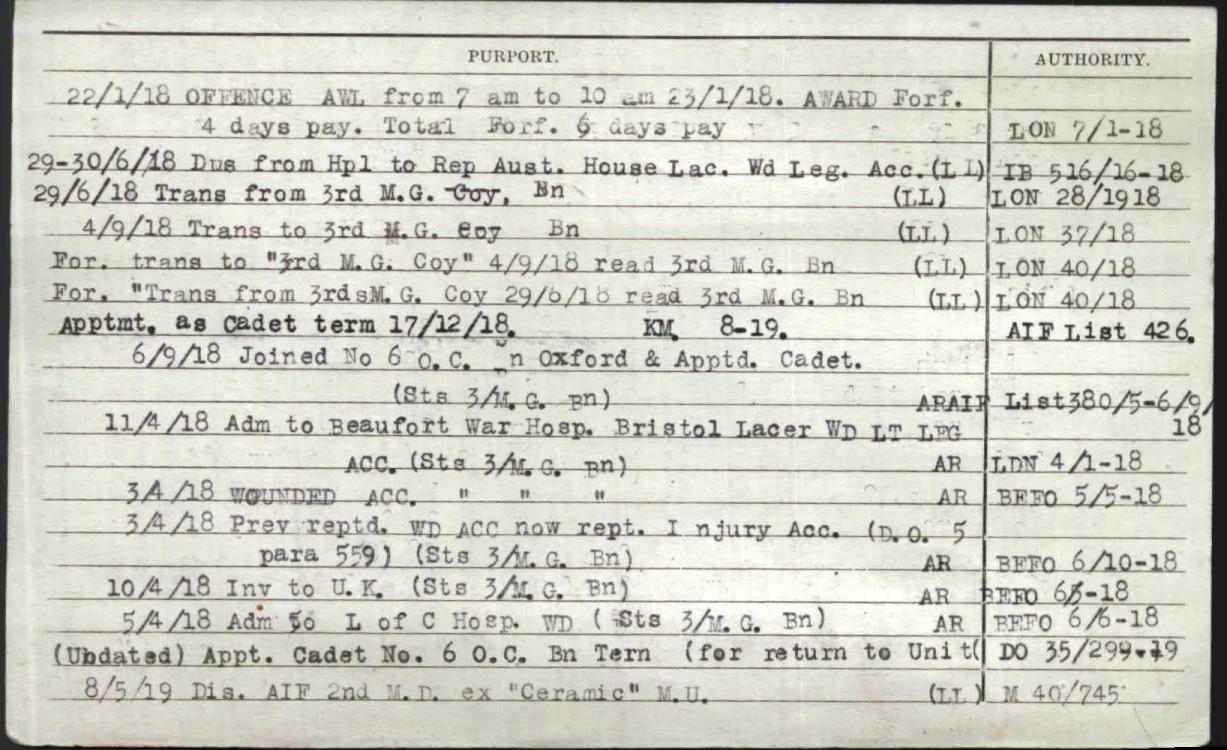
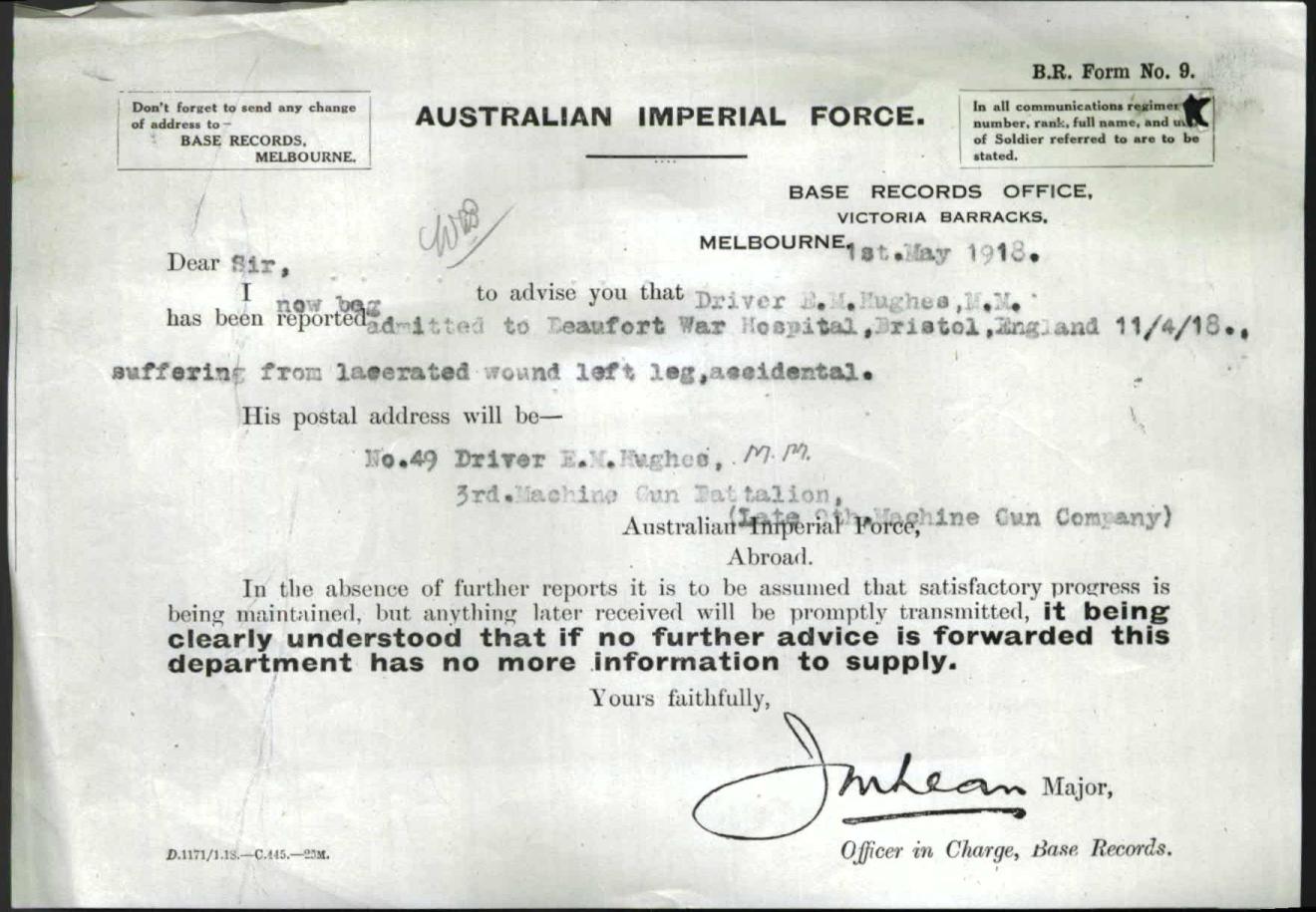
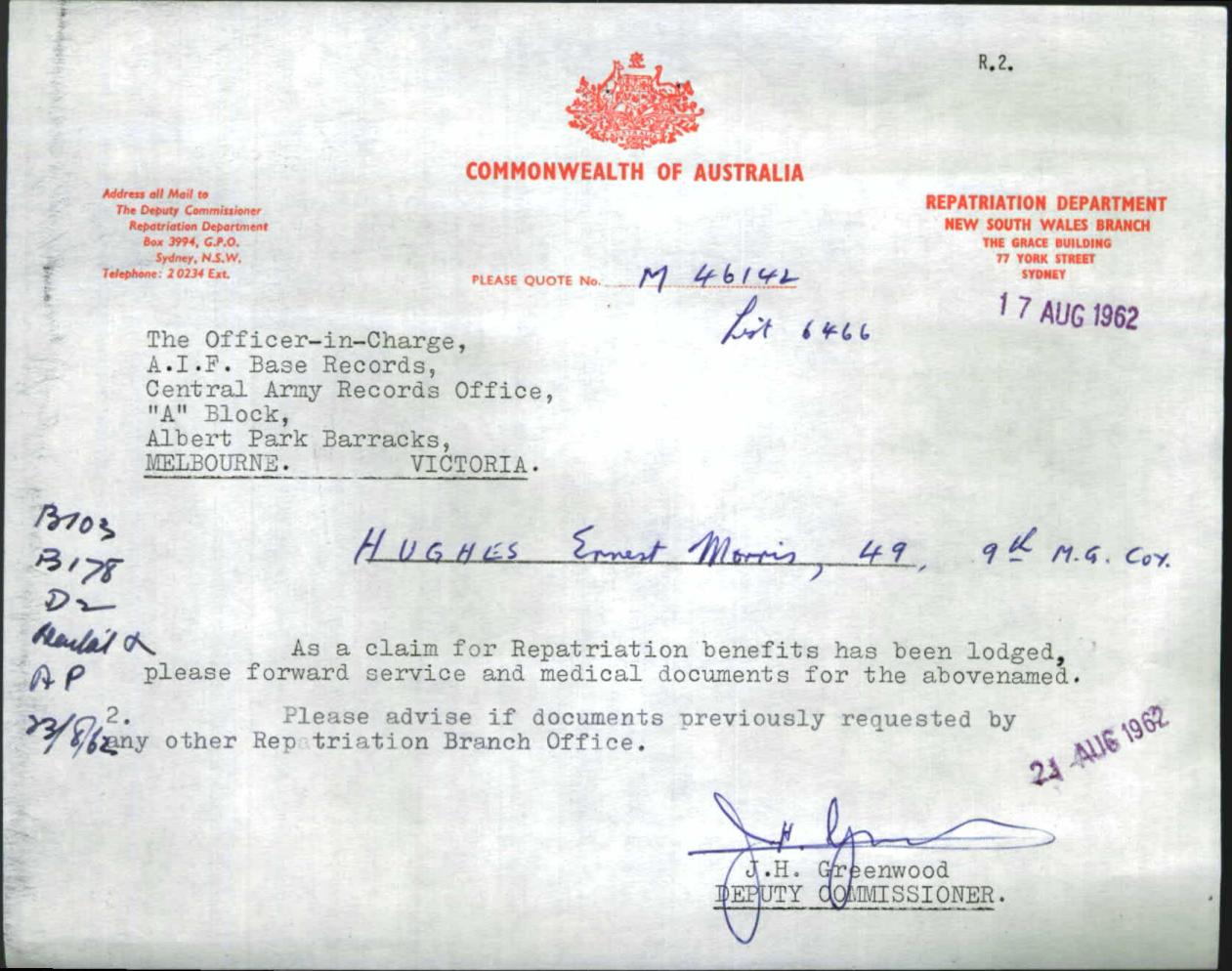

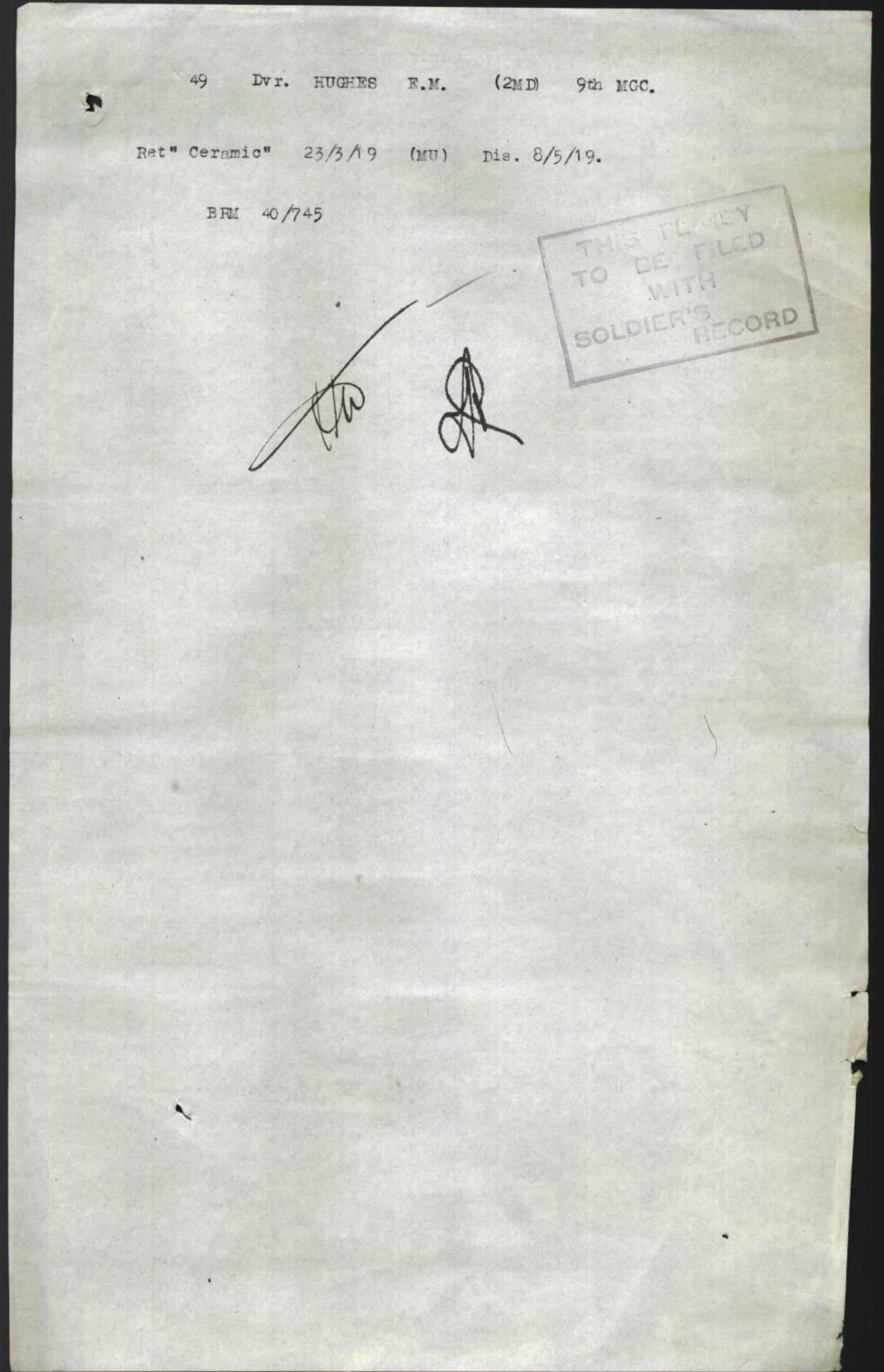
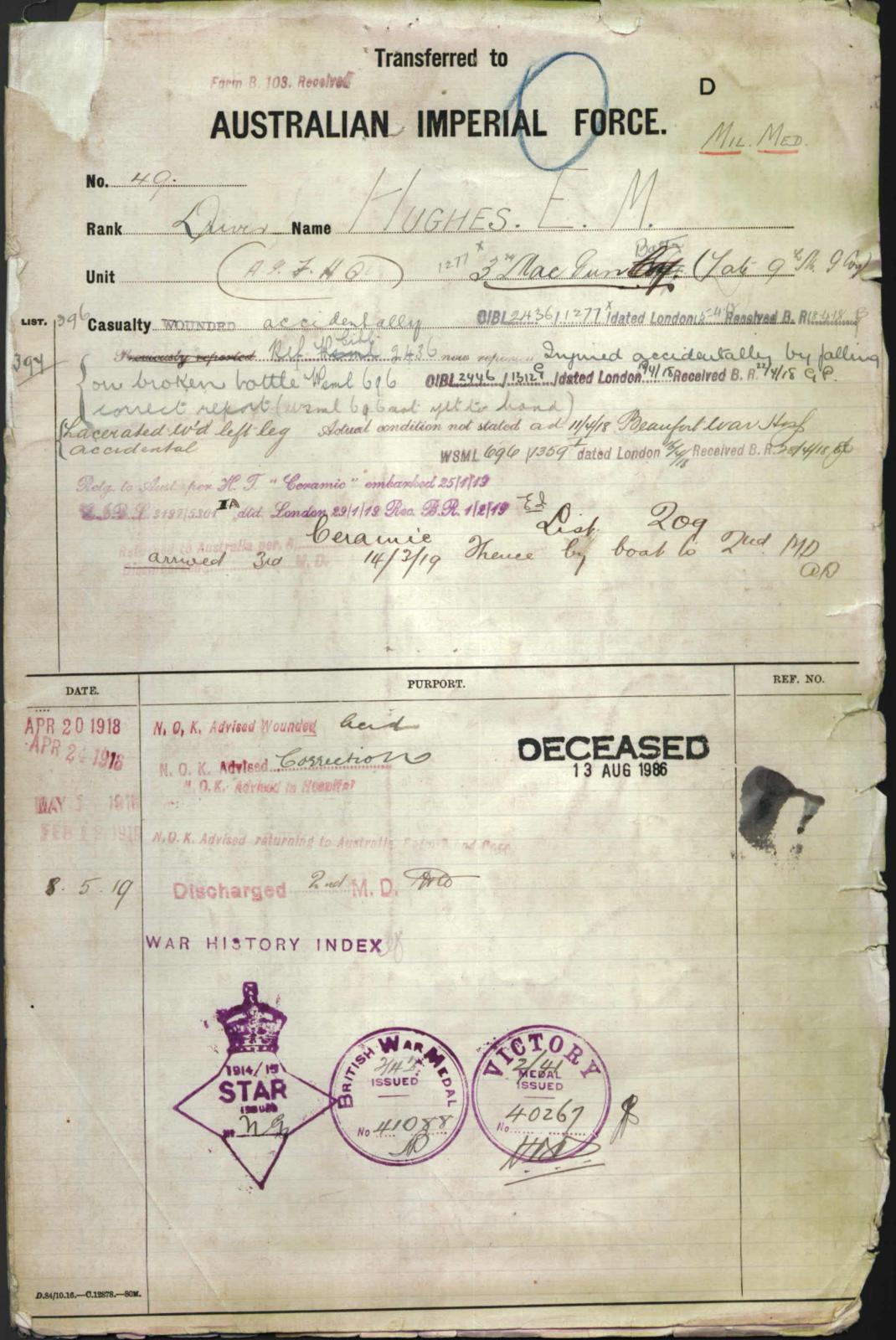


 A SOUVENIR OF H.M.A.T. MARATHON. THE NORTHERN BATTALION'S TROOPSHIP.
A SOUVENIR OF H.M.A.T. MARATHON. THE NORTHERN BATTALION'S TROOPSHIP. S.S. "MONA QUEEN"
S.S. "MONA QUEEN"



































































































































